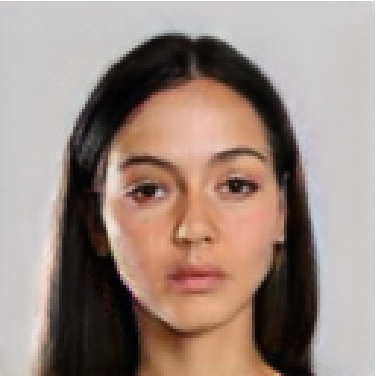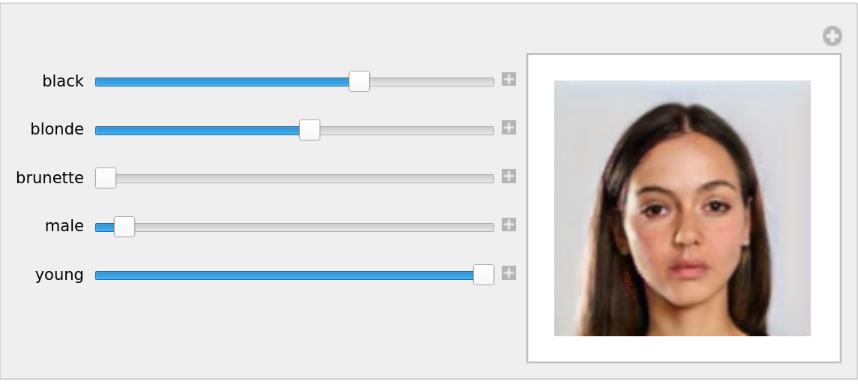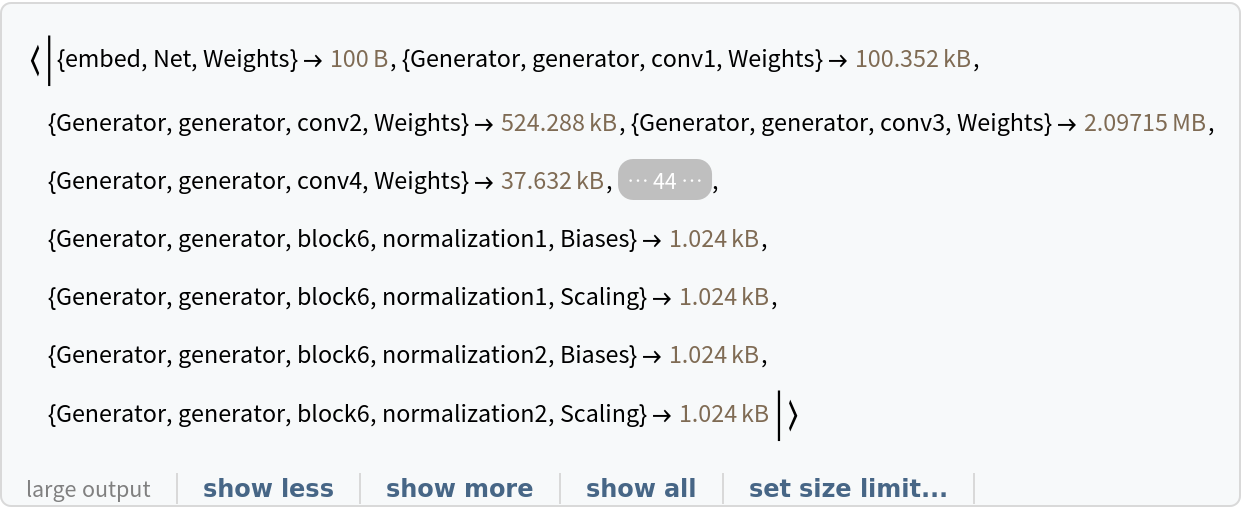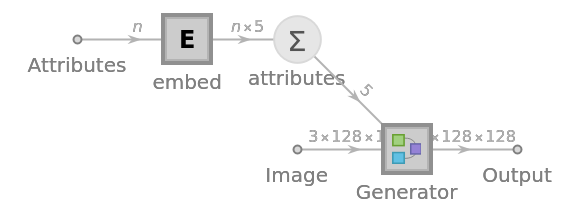StarGAN
Trained on
CelebA Data
Released in 2017, StarGAN performs multi-domain image-to-image translation. Adapted from CycleGANs, StarGAN uses the same architecture for the generator network and has a similiar objective loss but instead of having one generator for every particular image translation task, StarGAN has a single generator for all translations.
Examples
Resource retrieval
Get the pre-trained net:
NetModel parameters
This model consists of a family of individual nets, each identified by a specific parameter combination. Inspect the available parameters:
Pick a non-default net by specifying the parameters:
Pick a non-default uninitialized net:
Basic usage
Evaluate a net on a photo:
Attributes interpolation
Remove the class encoder from the net:
Instead of using one-hot representation for the class attributes, allow continuous inputs:
Net information
Inspect the sizes of all arrays in the net:
Obtain the total number of parameters:
Obtain the layer type counts:
Display the summary graphic:
Export to ONNX
Export the net to the ONNX format:
Get the size of the ONNX file:
The size is similar to the byte count of the resource object :
Check some metadata of the ONNX model:
Import the model back into the Wolfram Language. However, the NetEncoder and NetDecoder will be absent because they are not supported by ONNX:
Resource History
Reference
-
Y. Choi, M. Choi, M. Kim, J.-W. Ha, S. Kim, J. Choo, "StarGAN: Unified Generative Adversarial Networks for Multi-domain Image-to-Image Translation," arXiv:1711.09020 (2017)
- Available from: https://github.com/yunjey/stargan
-
Rights:
MIT License


![NetModel["StarGAN Trained on CelebA Data"][<|"Image" -> \!\(\*
GraphicsBox[
TagBox[RasterBox[CompressedData["
1:eJzsvHVYZFe69j0nk06nhYamcXd3d3d3aNy9cXfXQsuAAgooCnd3h3LFvekk
Mxk7c95z3u/7/v1WQaYnZyKnM5PJJO/1Jk/vqyjk2vV71rqf+1l77S0enuwR
/dGvfvWr9E/BwSMs2zwtLSzXkwN84Z2UHheTFBVpn5QRFROVphf+a/BmKfhX
Av6xXhNph98MEv3oJw4y4/hD4n/8YfBdcP7gBYV58uFBPTz9rvhBP/wQtKOz
D4//k/i/h/9/+f8oWfjmt77/dx/O/Ot/4Qdl4QPxfmD8n8T/WzPyzd8lUJm/
RP7/Kto/euApjG8m8cOz8BOT/wXxB2BBvB//33XOYPx/T+34Cfj/IPK/IP7g
JPeJ1Pen+q3nDN4EOXrQzwfavxT+/1rN/5AA9ADbhxR819k+8MeR6Q/x/hd/
yiz8EvkD0QDcwBHEw5m8f/3eUj4EjkQ7INHe/9jfwAfMH777vhD/svj/S7Lw
N9gP7gmzvgTvk2kHRCoefJcKskPHUeh7JNounrxHoBDIDByNiaMzifRDEkgT
jUmg0MEPg98FWbj/a0wy/RgECcQH14J/rf789PwfmL+XjofXAOD7F0BwdnDE
XRB44h6BtL2P29jZ3zkgbO/j9wlkAoVBoZ+QaCdE+skOnvxQow9I1AMyjQAy
Qr2fU/RDPOOQ+I258DPk/y9Rnq+rzfvSiSPTtnFEQH5ze3djfX1pfmFqdGQU
g+5rhw71tIMY6EYO93VOT4xubG8TGEf7FOYOjrS7j1tb31hdW9/eAbki05nH
FMYJHmSBxiD9kL7sn0r7Z8j/Hg5LMR6GPRjDW3uE1fXd+bmFUWwvAlJemBwe
/9o+xEHX31o9wFYv3tc2I9wjP9K7OC4IUpw1Pti3uXuwsbWL7e2GQyogBWnV
2UktpZloWBNIHI3GYByfE1mt8YM1Pfm58f8uZfgJkvLVgKfS8UDqyUAuGDtE
ytLKxszkTD+qvSg5KtDOyEFdwkRBwERRyFhB0F5H1stC081E1d1Mw89cPcxW
J9jeIDnQBdPWimpqSA/ziXIzDLXVCbPVTnAzTHAzzgxxgZRkTI4OU2hM2tE5
UCEK8+gDC/E/G/tPxv971g0enA/LLlKPiPTjfTxpaWVranS4qTwryEnfUI5b
Q+ylliSPjhQ34O+gK+dlrhHkYBjhZh7mYmKlKWWiIm6qLOqgI+NnoRZkq2Op
ImqqJGSmJGyjJuaiKx1krZnkY57y2iLZz6omK25jdZV6ckmkgyn2QQt0v3T+
31xT+noWHt55gA9eAN+ys3cwNzWBhta/CfYwVORX4H+iKPBCW5rHQEnQXE3M
VEnYQk3c2UDR00Q52F4v2t083MXYSV/OVFlEQ4JTVeSFiYqghsQrZRFuFQlO
FTEOFdEXOlKvbDREguzUkv0s4tz04r3MMSgkkXrviL76XO8nwj99kfOH8v+x
tOXr5fW9J7//7jGJeownUUGpPcCTt3dxYwN9uTF+jnoyqsJsykIv9OT4jJUE
zJSFTeQFjeT4zJWEHLRlPIyVvcxU3Q0VfM1VQ2w1fUwVbTTEXYxVrDWltCQ5
1CVeKgpyqIlxa0ly68vy6UnzmCsJuBlIhznpZAU5pHoaRzrqNpVn72zvEBin
RCY4DSaBdVagOv+1WaB+bcH5F8f/+2cN4P++LQWOEU85BDZyl0De3NxG1hYH
2mhrgQEs/EJNhF1HmttQQcBIkd9cVdhRV+a1pUaEo1GEk5GvubqjrrSDtqSD
ljg4gnS4G8qnvLZN9LQwluNWFWOX5nuuIMCuJvrSWFHYVlvWTkfeXkfa10I5
0lk/3d8mN9gu2kErK9p3emIYT6aCckBkHhP/esngq/N/IP+e/3fl4mfI/+tZ
+Oab9yk4/Mpq0g/XD/Arm9tTY8P5iSEuuuLa4k9VxNg1xV8ayvObKgubqYrY
aEk668v5W2mFOuiH2On5W2oG2+q46suYKQtpiL9UEmTTkeRy0JIIs9WojPeL
cNLTBuNfiENWgF1RmF1bittSQ9LPRtvPStPLVNnbTC3K1TjO3TQj0DbeTTfO
wwSNaN3HEXFECuuqAeP0oRzc0/5KJP+1+v+PxEP7/7AU/M04ANUWOMzt/ZXl
zeEBbEqAvYUir57UKy0JdkM5LlMFfnNlIRBmSoL22lI+5mpg2Afb6kY6GwdY
aXmbKDlqi+tIcqqIcqqKc+vJ8DnrSL5xN0TmRlfG+9ppiGmIv5IVBLPgqbII
u5GigI2WuIuBgreZuquRioepGpg+QLhSfS0yAmx8LVVhdSV729s7u6Ds0+/5
/7Uiv9eiXyL/92rzkALQHxEYLIdPooMv6dtE6tL6zvr69tTw0Bt/J1tVfi0J
Dl1pLgs1EXtdGWs1UVsNcSddGQ9DJT8zjWhXkwgXfXAMttULstbxNlEFk0JX
hkdNDOj8Kx0pXkctCWA124ve1CS89jNRNJLjVRRhVxRiVxBi05B6pSvLY6Yi
bKEsBOB7mKo7GyhYqorba8tGuBil+pp5GcrAqgv39g/Wt3Z28AQihUoFKsQ8
e5gIJJZZ/fYS8PPn/+Arviq+QFdZ8JkUxuH6Ln5memZxdrYLCY3zsXRU49aW
emGqIuxrreVhpmqlLgbguxkqgGEfYq8f4WQMXGWQvY6bibKNpjQw/+Yqovqs
uixkqMCvJcmlK8XtbiD7xt0ImhPdkhEW66RnoSQAsqMjxaMl+UpdAuTopYmy
iJ2OrJOO3GtLbR8zDVt1KUN5ATNFAXd9mSQPo9fGMvW5iSuLc9sEMo7CBBOB
+hdf+l6Rfon8/9ssAAaDfkilH25sbE1Nza2srHc0lEfYqdqr8ejLclqo8nia
KroaKlqoCNtpSrjoywH+r600geZ7m6oC9bDWkNKS4DJTEbPVkbVUlwT23kpd
wlJN3ECWX1+a21VHIuu1JaYyva88OdnD2E5NyEyRz1JZxElb0stEwdVAzkJF
xERJxNVAMcTOIMzRONTRyEFXFhgqTTEOS2WhNy7aoWZyhYkh81MTuHthJFFp
7/l/Twp+zvX367OA9YJ6RKYxt3Z2p2bmtnb2hrphMe76Dmp8lko87kYyTnoS
jjqStupiQHMsVYStVEVAeJoqO2hLGMvzAiepKcFjriJuqyXjZ63rA5pfAyVn
HTk3fUV7TWkn4G2MZJPd9VEFMb0lCQmOOv4m8jYKPMYSnNaK/F76kqHWqqBH
9jFRs1aXtNWS9rbQBI1bhIupo568vjSvkhC7rhRXtIN2tJ1aQZTP0uz0AYXO
WiwCyvO1HvmXy5/0YO0ox8BmTE6D/ycx3W1vvE3ctYRcdMSDrJSdtEXtNEVs
1EUcdaQsVYV0xNnttKWcDRX15fhVRdjlBF+IvHoG/LypipiHuaa/rb6LgZKr
obK/lU6onZ6rvry9mqinrniUjWJNjONQxZv2jKASf/MQYykbJS5rBW4XDeFQ
G/UoB91AMzUnHVnA3F5X1slAwcNIJdjOAByNFAVVhNnV+Z+GWMoHWshUpEbu
bW4fkBjAkVIZYPCckBjf1wX8/Pk/6D+eQltYXpkcGx9EITMC7PwNJYDqhtpp
uuiIWasJ2muJmygKGMjxghKsL8ttpycBRFuK67nQy2e8Lz6RE+DQl+E3U5cy
UZXQlxMwUxG11pJx1Fdg/Yosl5UKX4CxbJa7QUOsU3dW8HBJbGeab56nVrS5
RKSJaICugL+BWLC5QrSTXoCVspuhrJOugrWatI2mlIWKqLuxiqepCjBaqkIv
FAWe+VsrhVjJ1WXF723uEql0EqtBOwf8Hzj/Evk/XJDaJ1LXt3fGRsYHO+D5
Ea5hNor+JlLhdqoOmkJGsq8sVASsNMS0JDiBnwcVU1OCU1mUXYTjY362R2Lc
z41VxA1l+XSk+LUledRFQSJ4QGkItdcNs9MOtFCNttdIcdVKdlZPddWoDDTp
eOM5kBM8lBfUn+41nuEzku7eGmqSYiXtrMhhIffSXVfCRVvcRkUQCJ25mjho
7nSkuOy1pD2N5a3VhdSEXqgLsgVYyvqZSlWkRGytLu3gKaxaQGOSHwrBt3mh
nzN/8j3/PRJ1cw+/vLYxPThUGh8QZiXjby4bZqdkq85vKMNppsgLPKeu9CsF
QTYlwee6MlzKIhwC7I/5n/9ahPNj0F5ZKAkayfAYyAqYKQk5aYgGmSkkOGun
exgWB1pXhNlXBVmUeumV+xtBE5wHcoOWa5PW6pMPYFl4RBYFnrFdF7NWETKb
79cQahZsIG4q9sxSltNKgdtMlgukADR3mpJc8rxPTBUFnHUlHTVEDMHsk2L3
MZEMsVZqh5RsAke6i8PhiaxrOiALf7GjX58LP2f+BCp9B0/cPCCsbW6NjYw0
FaeHWilEWCskuOp5GMvoSr0E/sRGVVBPmkdX4qW8wDMloedy/E+FXj0RfPmp
LD8bmA4mSkLASWqIghLJaSzD6aDEE2IsGWstl+OuW+RtVOipV+1vAo92wGT4
zVXGbTVl7jZn4mDZlPY8OgpELq7pzUFjwj4kZqMydCLPrz7YJMJYzEWF31qe
z1qR11D+lY4Mh5LQE2WhF9oSXNYaInZawsYyXFZKfJ76YgleZpNDmP0DIp5E
JTOOSKAjZvXFrBT8bMf/+wWHhyXN+4uGJNBYLi8uTGE60gLMwiwlUz0NvQyk
5fifGyvwe+pJmCsIaIi+tFQV1ZUCU+CFAMdjMZ4XKiIvVUVYWqQhxqEhxqYr
/txS8ZWzBl+MlUKOm3ZloGnbGw9kgltvus9oQchcZexGU+ouLBuHzCd1FFJR
BYA/tT2X1p5NRaQzuvKpyHRyUyy5KWazKmQww63K3zjEQMJZXdRQ+qW+JLuJ
Ip8M92MNCW5NyVemyvyWKkKmCjwuOiKBZrIVqSHzM5Mb23tECp3KPCHSQS98
9jPn/5dqy7oIS6AwiWTm5hZocgdqM0PjHVTzfEwibNQAakXe51YqovbaYqDt
kuN7qij4TFn4pQDHU+7nnygIvACdkTL/EyBHwAu5aAj56QpFmIhmuarVBJhA
Q6yGsgJmy2OXa+J3mlP3WtPxyFwyqoDUUUDpKmb2ljK6i457Sw67CpmdeUed
uUfdBYeoLDoimdmRsdcYt1ETuVwRgklyKnTX9tUT0RN/bqHMZ6bIryLIpiry
QlOc3VJNDPQONhpCPiYy0XbK7fWFC/MLu3t4Aol+v1L9VUfwz+D/j19/Z635
0A7v9yockmhHBBJtdWNlemIUWpYVYi5REGiR7mNmocilKPjcWJHPXJH1wcHc
l+Z6rMD/TITzMcfTR5I8L6wVBbTFXqqLsOlKcFjKsPtq8iRZK9QGmKKT3Mdy
A1eq4vdbM3ehmThEDggyKp/ZU3zUW3bUW36IKTvClJ30V5yC6C077S05RRee
dOUeo7Jo8BQ6Mo0MTdmHxO3WRG1WhU8W+CJibWIspA0kXhjL85jI8UpxPVES
eWko/cpaic9QhstFTyrYSiHVz7QfUbe2vHpApOJoDDLLlJ6QaUc05g+eAvTj
cxBff/31+FH4k8Dgp4FWlwnOE5zkxub+4sLieF9bordRppdejr+xh56olshz
PRkeSzVBK1UBTVF2Uc5PJbmfir78lOvZYyG2R0ZyPHoS7CpCz7XEnlkpvAzW
Eyp002iPd16siNtrydiEJO82pxMQYMAX0rpKGD1lR33lLNr9VSeY6pPB6tOh
2rPBmtP+ytO+spOektOe4kNU9nFnDoBPaEkkw1KILUn45jf7DfGb1eFLZcHo
VLd4GwVdkSfAyhrJ88nwPlYW/NRYlttaVdRCgddNTyzYSr48KWCkt3Nre5dA
oxMoDECeQj+m0H/wFPgf+f8I8bDUQzukME5294mrGzubK6vN+XHJ7uoNCe5J
7jreJlK64hwWiry6Es/MlfmBnxTleirFyybw4hPe549MFPjM5F+qCj/REntu
JPFpmIFQe4zdbFHIak0cDpax3ZgCUkBhKXwRA10K4rC3/Liv4gRTeT5Qd4at
Ox1uvBhvOR9uPAWvMZXHPaWnvSCKT3oLTnoKaO2ZZEQaBZFOQqQSoMkgBTt1
kSvVkYPZ3lmu6qYy7KYKnLrS7IqCLDE0kuMDNtVK8ZWPkWSEvRqiMnt2YpxA
Yu04AuRBCshfqwI/SGf+Jgs/sv/56vLWIZ5MX1rdOiCSxjCowlC72mi7DG9d
LwNJfUlOA6kXptIvTGTZwaxXFWaX5H6mJMwJ3L6ePI+2BLu+JIca/yMLafZ4
a4XeNy4r5REbdfF7LSl7ral4eBa9q5jRXULvKqF3ljC6So56Ko56K0/7awDw
84GGyzHY+Sj0fLj1fKTlbLD2fKD6Alt5M1R1jik+7Ss66S086gamKJuMTCfC
08iITHzLmy1I/CYkYazgdaKtnLEsu6kSj7rYC1mBZ2rCbNaqgnZqvC5agsEW
0hmBNiM9qB0wpCgMIpVJZfH/axX4efBnrS0D8WFt8KAxdvbxwPNvb+00ZIUW
+xuXh1kHmYsbyXKqCz+3UeY2l39pIcdpIs8rzvGpguBzSc6P9WQ4jWW5gAlU
EXhsJvlpqpU8KtZxKj9wvS5+tykZD88kIrMpHQW0riLAHwz7o76qw97qE0z9
6UDD8UA9iNOhxosR6NUY/HIUdjOJvJ6AXo42nA9Vn2MrTvuKj7vzj7tyjsCx
t5DRnU9FZRNhKSR46n5TwkZt1EpVZHuCU6S5pJEUu7USr4b4C2UhNlD6HTQF
7FR4g8xlE1w02ytzlxcXiaylISaJtTR3+oH8vw75W3PxI+nPV7t3iDTGHoGy
S6Ae4PA90PrCIIuqcIsMD007lZd64k/t1QQcNfiNpV54G8poi3HIcgHv/VxT
jF1PisNC/pWa4FNjSbZcF2VomBk2iTX4D1rTCMgccnseuSOf2lVCZWl++elA
7TG27hhbfzLQeDrYdDrczBrwIy2no62Xk4ibmY7b2Y7b6fbLCejVeNPVeMPV
KOQSU85szaDDs07RxWe9pcfoInpHNhmRQUak70Litmuj50qCawP13VW5jGQ4
7dX41cXYVYWemci9slLidtcTibZTqkz0m8L24HHAB7G2O374+P9p+D9stiRQ
AXxg+Ak7ONLCxHBdWmBVuE1RiFmgiaiJHLuFPKe3jrC98is7Ve7XprIaImxq
okBpuQ0AfAUeLdHnxmKPS7x1oeGmXXE2s4WBBy1pwFhSu4opXUW07hJqdxkN
XcHEVLPgD0COsGDkN12MwS7GYQD75QTiEjCfQd3Od9+AmOu+ne+8nWu7m0Pe
TSNuRptO0BUXveXnmPIzTPkJsEno4sPOAgYqDw+UrTllB5IwnOed56ZqKceh
J/nCWpVPgf9TTRF2SyUeBzX+KBv5bD+j7vqS9ZVVMp1OpjMp4FP/XfrzTRV6
+PIfhc/aTgPaLvoBgQS88vYefqS9oSLSrj7WIdNHx8tAzET2ZYCpdLCxmK+h
sIuukJXiSyslHjN5TjDGbBReqQuzaQh8kuqo0Bxs0BxiMlMcDGQfdLIEZB7g
T0OXUbtLWfD7ahiY2tPhptORVhAnQ61no7ALAH+q7QJozmzn7VLf7WLf24W+
u4Xuu4Wuu/mOd3Oou9n2m0nY9XjzzWjD1TCo1NWnmIrzvrLj7iImKp+MzNpv
TjloSZmvCEOnOkeZiWuLPrFQ4jaS55Lj/lRfmsNKhTfQRCLWRrouJXBpZopA
o5FpdCqN9alBUwZqAe3wX+l/7q9wHRHoTMAfR6aBbn2fRNne2u6szoQkuMJS
3bO8NO1VeH2NpJPctFJcVUPNpaxVuI2l2Hz0xZ00BBw0BEwVeKVffRJnKd0a
blrvqz6U5bVQEblRnwh8PhFYzfYCSkcxHV1x1F972F93PMiCfzEOv5hAno0i
zifarmY6Lqc7rmdRtwvdtyuY2xXs20XM29nOd/Pd7+bR75Z67hbRb2c73k4h
b8ehV8ON14OQ877Kk15QkYtAjwZUCNeaQoSnb9bGjOf7NoSZemry60u8sFLm
1RB7rinOZqbE56otGGUlleatP4JG4MhUMp1BAg0miQE8NpXx3/YL/av8J4HO
2kKzhycRqQwcmTQ3hK5P8YMkuqCy/bz1BMyl2bJ9TerjXWpj7INMpeyUXzqq
8bhoCAJFctQSluD61EtbuCZArylAuzvKdKrQf6kqer0uAbhNcls+rRO4zfIj
TM0Rtu5kqPFspPVsDHoONGcCeTHedjXVcc+/HRyvZlFXiz23K/1vF0FgP18d
+mJt5PP14bcr/e+WekE67ibbbkaab0bqL7GVwJeyWuOufGp79n5z0m5j4l7T
m9lif3SyQ6q9gp08p5E0u7HiS10JNlMFHmtlrkBTqUQXDWRF2vbWJvikrG0q
FCarC2CcUL+2KPo/8v+u+Efr77347BwQQAo2N9a6KzJaEt3hqZ6tyW6G4p8k
uGi3ZbxuTnAtD7PxMxTz0eX30RcG7ZWLpqC+DKee6NNcZ4UyH+3uGPOJbM+5
sojl6hjAHw/PAZ6HiioEbue4v+50pOEEePsx6Nk40Hz45f34v5hsvwDi8xDT
7WD8360OvFsZvFsbAvHZxshn64OfrWA+X+r5fL77drztZrT1erjuYqD8or8M
8Kd35NBRuaT7KQCysFEdPpzhAgk2CjcRM5Fm0xFjM5J9aSTNBiTIVUckxk6x
NNZldWEeT2YAvSWSmQ/twAP/D9SffxJ/IvMYtL04AhlHoKzOjTcluiPTvMdr
4vNeG9oqv+wrj0cXRsLSfUuCzQINBEJNhV01eRzVeZ20RAwkOcKMREq9NLqT
HIcz3SbzXy9XxSxUxqzWJuDg2SRUIbmzhImpOuyvBoP/BFgdoDxTbayCO9V+
NtFxPtl5OY16iOuFvndrwyzyq4Pv1gdvl3rfLvW8W0B/voh+N98FBv/VEOys
r/6E1ZcVXfSXHnflMdrSqYh0MqspY8VOQ9xM4WtUvG2Ws4K7BreeOGtFyEju
laUSr7OmQJSDUtZrw4ku5AGehqfSiSAL91OA9mFV+J/Kn8C6UYKGwxNpNPpw
W21znH1/cehweViIkWCktUxHTnB/eVxPUXjBa4NYa4l4ayknVS47dTCveTy1
RWpDTdvj7cfzfMayPedLgtdrYufLI8H4321OJbblUln6A1rdssN+UHmbz8eA
20FeTT3IPvpyBn010301i76eA8oz+BbAXx+5Wx9+tzpwt9x3B8R/tvPtDOpu
DnU7Drsaaj7rqz7vAy6o9Kyv6BCVzWhLo8BSiK3JhNYkAjxlrzlhpSJ8IMO9
1EcrwkzcRolLmf+xrgS7qfwrd12RYEuZJDcNeHHywT6OtX+MwmSJD0t/flL+
39zGfF+CGcD5kEjk3e2tnsqkthTXFUQuItU1wkysOcFlpDZpqDqhNcm9PtY2
y1050kLCU0fIz0TOWY0331O7O9m5L8V5JNNjrjgAfPyF4tDFioi12tjtxiQ8
NI0Iz6Cj8mgduXR0GeizzkdbLieA+ADlabuc7r6c7T2d7rqYQd+Amrs6eLc6
9BbE8sDNQs/bBdbgfzfbeTfbASzQ2wnozSjkeqjmeqDyElt20lNw1JlzhMpk
IFPJ0CR8SyIRmnTQnLBVEz1V4N8SYZFkJ/faWExf/LmWCJuh1At3XeEgC+kE
J9XSaOfVhWkcmc7ar3W/EEf7sIuSPyL/h0Vmyv0lua820tMP8UTiAQ43PzaI
rUjoyvHbxVSXhZike2ljy+K2MHWd+WE1kTbNCfblwYYumq98TWQDjRWK/Uzb
Exx6kx2GM90nc72n8nwmc3zmi0LmS0KXKyI3QQlufEOApjJQuUClD3vKTgYh
F8DDTCJYKgT0ZIbF/2ym+2K25+a+5t7OY94uAP+DvVvC3ALzM9/zbq6TBX8W
eTfVejcJuR2vux2tuxyoPO8rYa1Oo7KZyHQKNBnfnIBvSThojN+ui5krDuxM
dCzw0oq0kfIykDCW5jSS4QBtY6CZdLStfIq7xsww+oBE38OTiRRgge5vPfu2
XuCbJv9HHP8PN8cBt0Nmtb0MAoVBwOM2Ntf7G3Lb03ynGpIXmlPyPNQgic5L
7aVbPXWo3NCOTF9EskuKk5K7jpCZsmCgmRImJwid4jaa6zua6T6W4TqW5TZd
4DdTFLBYFgb4b9TG7bckkZGs8X+ELj7BVJ8Ot5xNgFLbDgw/qL9Xs12Xs+iL
6e6LGdBz9d0s9d8uY98uD92tDN+uDr5dxr5bxIAp8Ha2/XYKeTeDuJuBvp1q
BU3x2WDtBbbqvLfsuD3vEJHNgGeSoCm4FpDuuN2G2KWKoJ4Ux9ow8xhb2XAr
WXddIQslLnNFTi894Shr+XhH+d6m8gMihWX2KHQChQ4a//d71791/H8/+b9v
/H91xxCNCQJPpu3jSbs7Oxvzo52FodAkt2VkESrDpyXeYagibre3dr2jDJHm
15Xjj0j3DLeUddAQNpXlrIpwGC4IGcwLmCgIGMvxnsjxmszzmSkOmi0NWSoN
Wa2M2KqLBfpD6chjdBWx1jn7awD/i6mO+2rbcTbWdjHbfTHXezrVfTYN9AcL
ii+rBKwOf745ebc+erc6/G5p8LMl7GegHZvtfjuFuptC3E5Ar4CCjTSdYmtO
+ypPu0uPOgoYyCwqPI0CByl4s9eUsFEXNZzjBY+zS3ZWCTSV9DYQN5V/aSzz
wk2LP8JaIcxcojknEre/B4Yc+OAUxhH1a1eE/46R/yH8v3n3CmuHNuOYwmCl
AEeiEslUIpG40NfSGGnSnOSIG0JA410Gy6OX4Pm7mLp5eO5wRSymKKw4yPS1
saS/sUy0jTIqM3Cm6s10RdR4UfB0cRBIwVRhwFRR0GJl1GpNzCYE1N9kYlsO
tbMY+P/jvhpA7HwUejmFuppBXc11A/G/WsCcz/VdzvdfzGGugOysj9yuDl8t
gRI8+dn27Gcbk7cLg1dz2LcrI2+XBq9mei8nURfjHZcTqPPx9uMRGBPbSEfX
MNAVDHQxtT2Xgsgiw9NxzUk7jQnzZcFdSQ5ZHpq+BhK+xtKsrQLSbIB/oLls
gIFwcZjl+vwM64okFfjPw4e16L+78n44/68/foS1pQrYHgodT6aDyQjO5GBv
e6QpCxKs2Zjkutbb3BjjtNlTs9pZuT/UPFKXNFqbiEz1jLBSjHPRLwywKgqy
6C1L2u6ELDVlLUESZwqDJvNez4CRXx2zUpew0Zi205q1D88ltBcRUaU0dDWj
t/ZkoAHI/vVsJ5Cd6zn0zQIg33e1iL1cwF4tDoAA8N+ujV4uDt5tTH2+u/jF
zvxnG9O3q5NvN2febc7crIxdLQxezGLOpnuPJ7uZ4x20ASixB0LoqsZ1lJG7
SlkLTe25eFj6FuTNak3UaJ5XRaCRj4G4p6Gks46QiewLe1VuHwMxT02+LC+t
qR4YhXlGINOIDNZC0Id0vj8i/wcJAuQBf0D+/s5oxur0yFh9cn2wZk2E9WBN
SnOKN3kGvYQqX0aVd+eHDNe+QWb4umuLp3qbVYXbwzNCd7CIvYG29Y6qleaM
hdJI0PMuAudfHbcKSdlszt2G5u8ji4mdlWR0DR1TfzTQdDICPZ8ETRbw+b3X
C/03y4M3qyM3q+OXS2Mgrlcmbtem3m5M323N3mzOvN1Z/Gxv+fO95c92l+52
F8GXVxuzV6vjZ7PY7a6mBVjlcHVWb2EiuiC2JzuqPcGvNy1wpT6V1J5PQGRv
Q96s18TMl4c2hFsEm8k6aYu4aAuz1swVXrlrCdgpcyXaK/bWZe7jWM0Onn5I
Yv7T+X9Thb56QWOVYCIoAXjCPAa51lbQGG2e76nRle3fmhFEnumdguYN1ad1
5gX1lEZn+hiH2Wq3pvrVRtgMVGQejPVQFgYpE907baUrkLTl+pSFmjdL9Wmr
TdnrrfmbsMIdZOkBqpLUU0fHNh8NQ0/GEOdTKKD510vYm5WR69Wxm42pm/WZ
q5Wpi+UJcLxanrzbWvh8fwXQvtmaB9hvN+eu16av1mcu16YZ0wMzrZWlQW5x
NvoBxqpeOnI+enKh5mrJzgbpbkbJDjoF3mZdqX6bTembkKTlyiggg4h4hzhb
JVcdUTs1fgd1QRMZdlslbm3RZ8GmEm35ERsry6zFFpYDYdH46fmzdsXc11+Q
/b2tjVUMlDZYl+9vGGOn0p3j31kSdzDSMd9WgS5JhKf6owoiPPQkYAUJQ1Vg
IgRNwsro6/OfHVLp80M7bVUgBestuUuQzJWWvNXWgrXWIhAbsOLt9sq9rjpc
TwMJ28Ichh1PtJ/OoM/neoHsXy0OXq2MgixcL49eLAxdLg6dzmJv1yZugeyD
WJ+4XBo+nek/nuqjjKAWWiuqwr0irHQjzLQTHUzSvW3DrbVDzFRj7bRj7bUD
jOUDDeWTnIzy/awRSa9XG9KXquOXqmK7UtwSbBT8jKTtVPnt1QQMJdjMZDlk
uT92UuZsSHBZHB8m04/xFBqFtfb4U/D/myyQ6QA+gwIaQDpzbXZivbeBiClN
cVLz1BUbrIgbaS0ark1vzwuDxLmN16dlBlhZyHMP1GUNlCV050WuYmDnpL0v
by4ZiyO43obd7roNWOF0bSqmKKY9Mxj+xg8S41kd6Q5NDenNj5+uy93vghAx
LaQBKH2snT7ecTiBOp3pOQdld3HgYh57NoO5mBs8mx0A8nI+3386y/ryZLKP
NtC+3FyGzo1LczEJMlSIszd442Sa/9o5zdUy2dm0Jsq3NSmsNSmoIca7PtKz
MtApw9Uk18OkKsByrDhqpT55IPd1jKWcj5GUlQqfhTynluATLZHnMjyP3dS5
qkJNJ3oQD4+kAA4cQKZ89yrQw/s/On/WlSAag8o4JuDxG7Oj692VW8iMCHMp
O2VeRLrfRHNeQ7xLYaBpeYhFX3m8i65YmIPODKJspCq1ryR+ewz95c3Z7++u
Trdm9gdg2+hGWHponIOem5aktaKApTyfkeQrffFXRtI8NsrCYZZaQDewRUkz
kLxtVB1lEE4baWeOdx2O9xxPdJ9O9ZxO9Z5OYkCcTIJ2rO90uudkppc20rHQ
XNKRFlET7pHnbZ3saJDubpHjY1se4tYUHzBUlrYKq9hG1e91N+AxzTh04ya8
YrAktS7CPdNZHxLuNFMRN1oUGm2l4KYjZq7EayDJpsz3VJTjEc+zj1w1+cqC
DIcQNTt7+wQSFejPP5v/N5SHdf8sqwVgHJGp9L2Nte25kfWOAkJntqcOvyLf
0yQ3rZ7CsGJ/gxgrqdZkj9xAS22x56WJAbtD8NmWgtH6HMLi2L//5vPf3V2e
bM3ipvs7S9PDrTXtVUWNZfmM5QV1JPk0RV7aa0p7Gyg5q0uayfPry/J46Eqm
uBrm+1ojUoLnGvN3ULUkDJw2iKQPIcGROYI6Hus+Ges6BKkZaaOOINYR5SNl
Kd05UY2x3g3RnpVBjoikIHRW5FRVKq6zijnYcjTUyhxoPhxqPR6Fg9eHAy3k
3qalxsKuzAj4m9eT5bGT5dGRlgq2yrwWKgKaYmzinJ9yPf+Y48lHzpoCoLXs
rc3e2ljHEYgP+3Ip37EK/b4X+HH5A/MP4FMPTw4ODnbXlvdmB1ehGbj2DD8j
UX62T6zV+GpjHCLNxcLNRKojrBxB/dIS663P3xtFYatSMZXp58Sd/+d//fl3
by/pGzPdjeWehipuasIemmLAILnrSgdbaEVY64SbqwUaKXnryXnry3nqy9oo
8zmo8vsZyISbKjZGu41XpKxBS/fBdOhvpWBa6VjE0VDH6SjqaAjBHIIT0JCJ
8lR0elhLnC86L6Y3J3ogN26uMn2nNZ/cWXzYV3ky1Ay6ieOBRiamltlXfYRh
baKgd1cTOyoJXbXT1WnjZXEzNYkxdmqmcpyGcjyyPI/52R9zPX/E+eQjL13B
XHeF5oygpbnp/QPcV/wZ3z7+/xH+3/r8tPunuBxSGayySyCR93e3gPPfn+ya
ro1ZaU7w0RPiePyRDC9bmLWSo9qrUDORdFc1Zb5nr43lR5tKtyZ6m1P8Z2Fl
v705/99//uNvzk7Gu5Al8eFFQa5lwS6QaI+e7IiBooSxkoTpqvSx8tTe/Fh4
cmBNuGtpgG26i0G0pWq0tUaKi2Gxrzks0W+gKHGlpWS/s46IbqD2th5hESfD
iNNhOBjV4M0FSNFoafpAYcJ4RfJsVdpSbeZGfdYBNAsPz8BBM/ZasgiIAgoy
j9FRwOwqYXSXMXsq6V2lREQhuYvlByarkuYhKWkeeloSbMby/PK8bFxP/+3Z
px+/ePSxn55wrodaQ4LTzEj/zu4ukcKgH5497Av6yfiDok8CPRcOv7e3RyHs
Eyba5mqj+rI9PLQFOJ894n7+iaG8gBTXR/aqPC6awrpSPLH26pjq7KV+REmo
/fYg8s+//fw///DlOZm0PDIy2FyHyknszgrHZIXOVCSuQDK3GtNZm5lh+Tuw
/K3W3OX6tLGiKHRaACzOqyHctSbEqSbYri7MqSM1eKYma6khF4+qovc1M7HQ
o0Ho6QjscKAJGNeN1rLF+vyF2syVhqyNxszthoz1yrjZvMC5wpC1yrjdprR9
aPZBc9pBfTyxKZkEyya3F9E6S8ntxURUxXZbyVRNymJDamWonZbIM3UxTnUh
dktZLlXhF68efeRvKJbtrloTZTXa2bq9uY4j0b66EPAP8P9W1N8apIebxKl0
AJ9IJO3hSVQibhcL2WpN6MvxsFHg4Hn+iIf9qaasENuTj8VePlYVegFsQ56P
wVB9/kRbTVm4A2EG+7///Y9/+s1nN4eMSyZ9Z2JguqloojRuNDdwtjh8qTJ2
oy5hpyllD5q1D2PFHixruyV9uTZ1qjQBmxWGjPdqiXFtjHSGxXljsiMnyxO3
oPmU7trjIdjZKPx0pJWJbcB3lG805i9WZyxVZ6zXZW9B0pZKIybTPZdLQ/eb
MgnIclJ3PQkNIXVWE5FFO/UpG1Vx+/Vv9prTD6C5+4jiLWTxQkv2SmM6MtHH
TJ5XhPORrjhnf6pnqauyPNuvQgz5C71VqkJNeuoL1pfmgP4cEKgU2vHDptBv
0v4QF/rh/Mmse8MPDwhkEplKIJMPCJT99fmtztLF6vCOJFsXdV7JV09ePfuE
58Wjl88eSbx6xvX8EzWxl5BYh4HaXHR1Xk2s2+neyn/+8fe/v7v+8vrq3cnR
7lD3QkPuRHHkTGHIXEHwXHHIbJH/fGnocmXsak3CSlUcqzsuiVwsj16qTVqs
TZsojgVzoSnMqdLXvDHcvj/Lf7nmDamz8nQEfjXVeTnZfjrcdIAoXKzJAIK/
VJu+WZ+yVBw0kuI8Xxi8W5O0VJa0VJk5V5G9Ca3BddQcwCu2mwrWa5I2KqL3
WzIOoPl7iKKttuI1eMF6Sw62IMpZS4L7ya+CzFR3IUmhWrz6/B+H6PIXemmU
BOiiwd+fGiNQqSwjSmZdDvgm/w9sAT5o5H+lS4d4Mo1MYeCJNByJtL+P35rC
7HWVLEPi4fEWXjpC8jxPOZ9/wvb0ER/HE+7nj379q1+5G8ujcgLqkvyRBXHN
KYE3lL0///aLP9xe3Z2f3h3TyVN9qy0FYwVhIxlePTG20EAzzBvX6aKIpcqU
tcb8TWjJLrR0qzFvIj9qINF1tiBkpSFzOD8KGetV6mWS5aTaFGYxVxpJ6qq4
nup4O997O9N5jK3fbM5ZguSuNhatNRctV8SOJdhMpzpPpPk0+NlnOJpEmqhb
SPC/NtR442aW5WvXmRY2XRCzVp+8D83BwQv224p3UaVbiMINaO5MXVqghbIg
20fpbgYVnnqyT39lIsYWrMOb5aZSFKDbWZK4NDGyiz8gM1mLkGTa4df9z98s
h/4j/EGpff/0GOL9mgPgDzJOIJJwBweE2V58T8l6a3pTrJWvvoiK4DNetkcv
XzznePLJR7/+hP3Jo0RXvabUgIoEr56yhL6y1N+f0Vn8317/9vrsgrJNne1d
gRWOF4RBw8wRUTbjuRGzhTHD2ZHjxcmz9QVLLeXz4Ai8U0PBQmFsX7zzaKbP
THkiNieqJtQp0UY5z0V9JNufgCw8G4HezXffTrfT0VUbAHtzyW5H7V57zXxB
+GyKY1eoeam7UaC1gbIImzDnUw8He0URbjlBHhN1VU1xngADRUSCz0ZzBg5R
iG8rwXWW77UVbUKz11pz0zyNpF99lOWhW+apLsn2kZbQ80hD/hwXBTD+4TnB
S+NDm5tb9EOWJpDuu2D6f9/w9iHwv4f/35Rj0v0+E9bDi1jPOGUScHg6jUQc
byP1Fa9As4v89Xx0Ba0UuZUEnz97/IkK96cKvM95n/xbuJ1WQawfvDhluKFw
uRvyuzPaH7/47D+//PwPd1eXpC3G4uASrKQjwaUz1X8XVYvNiagKdMj3s/c1
VLVRFjeVEbBXkUz1tAGC05/ktQRkKi9kODditPgN9E1girNOkrUcOt5luyGV
2Vd7MYa4GGmldVduI2r20c3UYSQRDdksi+oLNS3xNOsoL8xNDDOUfiYtzOfo
4GhnqGSmpVxfAUkICzeREzMS5ch1054sjsIhiomdFXhUyS4idxdZ1BDrqiPw
aXO0fUeMhQL7vxmJvwg35MtyUawINmhIdlsYxmxv7RBJFOrRCfHohHL4twtx
P5T/t7sgOuspdlTGCSj0rMFPZVAoNAKRCLpvysHWNqqUhq1cgWelOCl56wg6
qvEpCzyVYPsoVIcv0kjQTIbdVV+pHVLVCakebCjd7G/93Tn99++ufv/ZzW+v
j88O1g/XJlbbKtAZAecbc8ONZY4qohpivOJcL7ge/1qAkz0yOFRNhL+ioKC1
srzA06jFV3sqN2ijKX+8KqstOSTbw+iNpWxHtP1WXdphT835cOMZtpbWUQyG
PXWo7WoZezzcupQVhIlyG6nPW5scbizItZZ7YSzxVIHnEz2J58HOdnNjM4Mt
kIYwlww7tXo/48n80F1oPqGrgthdugfP2UMWducEh+lLDGX7t0ebq736taXM
qzgzgQwHmbIAvfoYh1lM5872HmiC6Een1KNTyv2Taj4c+9f5f4//ZFV2xgmJ
esi64gkmGoVGJlHIoAIzDslbCzsdBeS+imVoeranpr+RmIXcS03h56biL3xU
ubyUOaJNJELtNcJ8XPLiwkeaSveGkb+/ZP72+vR3N+fvjknHmwvH61PrnTVj
tVnYlmoLRQktWfG4kCBVUV557o95Odh1VOTMZdmLM9KoOPIqtrs/JwIZaDJV
GEbGNk9UpRX4mqXaKLZF2mzXpVHbSs76a097KijwvH14GWO47d3myPEwdK0y
bRdWPZKbMNlQtNTXnRns4aTM464r8drBdLCzawXT21+YDPG3rvUzXyiLpXSU
4NtL8KhSSk85vi3/AFk0WBTZEGK1UR3fFmGsy/fISvplooVAooVwkZ92ZajF
aFvj1ubm7u4O7fCrjVgPvfDfzf+bys/qrEHQWYMfpIBAoRNIFAoVlGAwCaj0
9YktRM4eqnCxJe2NvUKgsZitMpeTuqCLPIeZyGNt3o+CtfmMZV9xPPpVhLN5
b1X29jDyd+fML86YX57SL/Fr9MWxo9XJqebiNFdje1UpN1XhvFCv9qYWH1tz
Q9FHumIv1AU+tlLmGURjiGtLSz1tW9Ca2azwydLofXTddG16oa9xjqNqR5T1
dk0yBVZ41FVxhCplIvJxrYX4TsjxVOfhJJqAqlqrTZotSJwpSpwqjp6pzkam
RnfmJS/AWhZbaruSw1CxPti04JmyBECbiq4id5VS0OXUngpyRxEeWQwaYUyG
/0FjGirS1Er8sa3M8yjDVxHGPKWBepUhxn2gMG1vgv+I95viqH95WNMPnQLf
1XN9tbMRZIc1+Jkk2uEBkUKm0qn3/BngMIfegqUR0KUjZWEBuvx++kIOKtw+
euJB2vyOsi9MxB4F6nDZyHIpCLDHuFuiy9NwE11fHFPvGMR31F3m8sj+UMfe
EGoOVlEd5bPSj27LiCrzMEKmx6Cqy2Ld7Fw0hP0N5WB5aUto1HxN3mx5+mxF
+kZLCa63eaOzoS3Jv9hTv9BVoz3Cag0M3Za8w/YSOjyfUJ+Ma8zag5cd9EAI
A8hdZN1WY9FKZfpMdsRYTshMUfJc0ZvhrKj5opT+9Mil2txdWNkevJSMrmJi
IfTeGkp3GRVdRgMpQJUA/lOVbzoSPbfqktBxNq5ybLbSzyL0X0Qa8+V5q1UG
G6DKkg52wPjfxRHJODLrCUK0wzP60fkPnQLf43zu45hwf53lgEQFRotKZ4Lx
T6XRmcQ9+njrZkviDjJnINfLR5PL30jURY3Xz1Ay3EDMXYHDUuxxkJ5goKGo
rhRndoRPT2kSbbbvy1PqDXnncmeWOILY7Kxdba+aaS5YRjUcby6PNVXW+lu3
hDq1xb1GJUd2pkQN572ZKEqdKUldKAPNVM42vHK3s36rvW4KUlgf5lTurV/u
qdsebreYH4GHpDHgeZSWDFxDMqE566A1bxdWTOprIfbBd9vrt6CV242F6/W5
W5C8teqM5crUvdbCA2QZpaeOjoEcDUGPh+GH2IZDbP0hpobZW0HrKSF3lODa
S2ZrUppCLRZLIjBxDl6KnGZibGF6zyL1ebKdZcuCdGE5oZury7t7e8AKsq5G
3W/KYhyevV8O+kf5P6SAwbrUC2IftF001mNkaHQGCdTfpVHqMGQLnr4CTetI
dfTRfPnaQMBbR8hTSyjGRMJbmctG8hnoVhJt5PREn8S4mnUUxDNWRn57yrjE
bxwvD+H6mzeQFSuw0oXmgg10wxa2bbuvdaYmDZsW2Jsc0Jnwerr4zUxZ8kx5
6iokf72hAFTVvV7Y/gBqv78dkx/fEGRZ729c/9qkI9JhPCPgoD6dAs1lthVQ
Ebn41mx8Sy6ppYCIKKViGmn9CGJPO6G7ldLTSupqwCGrqehGBqbleBhxPIK4
mGi/muw4H4OfDbWcDEBOsfWn2NrD3jJWLWgrma9Lbwgxm8kP6o93DFTlshR7
EmP0KlT3VYYjKMFajcneG0vzBzg8Dg/8OBBn5ld3R/7lqR0faIe+t+E9IVOZ
RBIwPFTi/Y4LCo1BpzOpZOLBGJI51rjXVbjVWdKV4+OhxvFaXyDAQMRTgz/V
Rj5IW8hGki1Clz/dRsZFmTPJw3SipeSKsP77y9M78t7RfD+xt36vrWylKXe1
OW8FXrKMKF9uLZqtyZgoiZ8rT1qrSd9qyNpqzttFVhx0NRD64dThTsoImjDY
tdJS0p3o2Rpi3hRo3hxo3hZuN5UbetCQddhRdgzMGLKAAMsjwfNJ0Fx8YyYF
UczENB+OdJD728h9CDoWMO84GUWdTnafz/SczfScT3VdTCBvJhBXI1CWicLW
n2FrTjAVDFQZuaNssT4D8J8vDhtOcovR4bOVeBRjxBes+yrRSrTMX6P5jcvc
xAgY+/sHONZNGdRDEPTDs4e1IPoHN8Lfsc7DWuphpRXAJ1HxRCr54eGxQHyY
R1T8LnG44WgMsttZOFOXgC0Oc1F5GWQoEGEm6a0pEGsmGW8i5SDJFm8smmYj
FWIsFGomNwMrfUvd+/O7Gxb/uT5Sb90eoni1IXP1IQWNOcuQrJXG3NWmvG1Y
Ca6tgtBdS8I0UwaRtFE0ZRxDn+inDbTj2qpni2J64hwR4VatIZYtgRatoTab
dcm4hjRGW+EJuuKwqwLfnEOE5jG6ysmwfGpr/mFnxUl/4+EQ7HAQwRyAHY+0
n02gjye6TqfRx+OdF5Odl+PIm3HAv+UM23A91HI12HiBrWWgSojtpQv16S0R
lovFESNvXNKMBJ2kPg7XfRms9yrWQqjktUZjguMUtpMIZBlHJFLoFPoxnkQH
8OmH3z7gvysF380fJJTG2mhBY+1zuN/rdUSl39f6nWX6eBNtoArfUzxaHABP
dLKSfRpswBNjJR2oL+6rI5BqKe8h9yLNSjrDQT7YSCjcTBZI/Ts67s+/eXtL
3T+aHyD1NRy0law3Zi7XZy1DMlcgmWuN2duwQlxHFb6rntDTSMRCycNt1GEU
ZaiLPtoJLD2uowZY/emc4O5Ye2SENSzMutrHCBHtjGvN3q9NpEKzT3pqTnvr
qIgCQmsus6uSjiqjIwuP2opOumuO+urPh6Fnw/DjQfjREOJkBHE23nY50XY5
Brseg92A40jT1VDzzTDsaqjlchByiC4nospnazM6EtxXi2OH42wzTfg95D4J
1gKi+jLalL/AVw0SazfT27q3jwfqj2fdmnFMILPuy6D/pRH+R/jf72wBc4rO
ehgO7avdhqziCySIQmVszjAmYcTeEspA2UR5WG2YmbnU40BdrihziRBjGQfF
V8lWCiFaPEWuKjlOSq+1+aMtlIHJ/+IQ919//N1nx9SjpVFiXxOuvWwTkrZW
k7xem7pWm7rdmLnfmgccI76zBt9VR+lrpmKhjCEEOFLRteSuahy0YKMybizT
pyvGBvBvCDQvctUayQ0lQnMPIOnHqIrznrpTdDWjo5AAzaahSo/QFYy2/ENk
wQm6+qwXcoltvhiEXg7DL4ZbLoebr4ca78ahb8dgb0dbbocgb4eargearoda
gRCdDzYye6oIgH9N9mhuxFpRNCbCNM2Ax1P+cYjW82AdjhgT3kIvpdooq2Fo
2cHeLoFMxZOoQHzAFABHKvP0Wzn/HeOfTAPTirXPjQWfeQyUnwLqC4l4vDF+
udzDHKnZ7sgaLgyqj7AA/EMMeWMtJcNM5cykXkToi8YbC5Z5aKRZyfqocbkq
cNbHuJzuz/3Xn/8EJOhye4E+0raPKNmoTtqsStyqSdqsfoNryiTB8sjtwHuU
UburGT319O5aZm8trbuc2lFMai85aM7ZrI6fKXjdl+jQHmlf5qlb7W+yD83D
QTJILTmHqNLjztIjVPFRWz6hMY0MzTnuLj/uKjpsyz/tqT5H1130QC4xzbdD
sKuBxsveuouOsuve+mts87vBlrf9kNu++tsBMP6hF8OtlyOtzN4afGfVbF3a
SLbvSkHYaJxtkg6nu8yjYM1nr9WfxJsB/op1UZY9lWl72+sHFFY7+qD/D5vS
vxX1h/N/L/5MUMSZR/cbHY+ph8BcgXb4iEkhnm+Nvd0coA/XztXF9Od6V4SZ
mkt+EmkmEm8pGWIsoSfOYS3LnWIiUu9vmGYj76vC5avOl+mufTAE+3//+If/
+PLdb45pZwvDhO66vYasnco3u7UpuAbAMJvcmkND5NDb8omt2cyOUkZ7Ka2t
iN5WBF5TYPn4puzduuSFoqDBJA/Q9ubYyc0URVHaS3br02nw3OPusuOu8rOu
sjN0GbOtkNCYRYHnn2PKT9HFl33VNwONF72Q6/6WGyz0Gtty1lV3iaq96oac
d9XdYVu/GIbfDUJZqRlsvQQyNdDC7KkjdFfP16fNFQVToGmLBYHeMs8cZB6H
aj31U3scby5Q7KNSE2HaURy7vbYEZJ9EppIo988oAC3Y4dnDWvSHwP/28c8q
tcf0o1MG8FGMI9b6xj1/GvMY+B8Gfvtye/Ryrfd6GbXSlDha4l/gp+ugyBZn
LRVvKeGvJ2wo9UqJ+9MQDd6GAOMcB+UAdb5wI6kIU2lMSdyfP7/985e/+dO7
t1+Qd4+mevahRdvVyXuVCfjaN9SmDGpzBrExlQbLIbVmAxmnIYsocNaR0VZC
gxeRoQUHDenLZaHDqW4VHupl3jo0dA0emkNoyqAjC876669H4NfDraeY6tOe
KlJrHr4p86ir+Ha49gpbczfa+m4U/vlY280A9BrTfNnTeNPXfN3XdIttuelv
fjsAfTsIux5oZfEH7UA/0J96XGfFPMgsqoiGKsyxkLQS+LW9zLMQjWc+Kk9i
zfgLPBVrwk3hOcHrC9N4Io1MY+BJFByZ9exE8l+uxfzd/EEwTs6ZJ+c0OjC0
J7RDVhdAZRzePxXw6HB38d3++PUG5majbwOaPF7il+OhEWIsnmgrk2gtFWwk
biLNJfzikbUUe62XVq6dgq8Kp5cqf5C+VOFr41vqzn/94Y//8dndb0AjsDUP
SupOfeZ2eQKhNo3alE1rBpFFac6mwwtpsEJyax4NXsh6jSw5AorUUU5ozduo
ie1LtEs1E+3PCT+d6j1oyiU3Zpx2116MoL7YW/ryYJH1FAJsAzCiOEg6qTXr
or/ydqzp7Rj0bgx+N4a8wrYA+GAiANq3g7DPRtveDiNuh+CA/yWmCfA/7W86
6msA4/8AVb7SkEFFFa/WJTf5anvIPreS/CRQ44mn8ieRRtw5rrJVYcbwzNfL
49j9AyJrO9w9f+pfxv/fXIL8gfyPGMdnzOMzCpUJxjwY/KAE0A5Z7QCFzrzE
LX5JnD5f7r5ax6y3JI4X+Rb76YabSmS4qKQ5KgYbSRhJvOTneKzC8yjXWrrU
WcVP+aWjFLu3mlC4sfD+OOr/+8Mf/3R9/vnZ4TVug4yF7TTlblWlboOetDYT
V59FqE0lN2aRm3PITTk0aB4TWXzUXgYMzDEIdC0VWbLXkNoSaJBjI48f6fzd
BY2IhuCashi9VeejyJsZ7N3C8Mko7AQLOeouJTZnkpoy6R0Fn88gPp9uu5tA
vAVWcwj2bhAOpOZmGEwWkJGOu7H2m2HENbb1ZhB2gW05wTQeYhoYPXW77aWr
kGRCa8ZSVfxAvI2N6DMDwY/91Z95Kj8O0+fMdZMrDzaEpXtPoOEHB0QciQb4
7xMorIcYf/Xs7n+APxj2QO2Pz0Baqff8H+ovkcakE/feUta+IC9er3RfrnbP
14Vhstzz3VXA4M/31k1zVXttIGosxSnE+Ynsq8ehmtzl7sq5DsrBmryucs9d
ZT4dby74X5/f/v7i6DcntFvCJm28e7+jcq0qZb00casc1OLk/ZpkAiQdBB2e
f4QqBdblFNMACijwkye9taAWbNTGFTsqwuI8/+PdJWNldANWvt2QR+4oB4P2
BNvC7Gtm9DSA7okEyyXBs+nIXDoy/+1o42ezbXeTyLsJ5LuJts+m2u/GEJ+N
Ij6faL8bb3t3f7wG1miw9WKg5QTbdIhtpPbWbcCLdqGZoKHerkvGxNjIcz7W
4P/YW+WJi+xHUUbc+R4KpUEGzUmeYx0QHA6HBy6dylolAMOV9rVVuL/z+u89
fyD77/lT7ssxiEPSwW+Y219SV+42eq6XO5Yb4wbzffI9lJPsZcD4T7SX89Hm
N5Jkl+T+VILzUbSxRKqRQLqleL6TYoqVlJ/S0/asgH+/OQbi845BOt9ZZk5j
9rvqV+uyVsqSNsqTtkAtqEs7YPmZ3ENU+VF31Tmm/ry//rSv9mKw+bS/gY4q
n84PzrMQxxTGnW3NrtZmEDFN6y15W5AMalc1DV1H64FQuupI7eUEaC4VCUxR
IbO98Hqo/m4K9m4ScTcG+3yy/fMZFEjBu3EkKwD8ifa3Y8jbUQSAfzEEPR1s
YfQ3kLqr12EFFFQxA5lLac3ui3MRfPaREt8nTorPnBQex5nx57rLlwTqNya4
DMEq93Z3iMD/398NAUDRjv4qPn83/4eC+8D8K/g0JvCipzTin04OvmSs3ax3
3K227bZldyQ7ptqJp7sqZLooJ9pI+esKmMtwKvI/533+q9eawpVuKpFaL9Ot
JEq8NFNtpUu8te6ou19eHN9S9i92F0+XxohY5Da8crM+Z6s6dbs2ab8xiwgr
oLWXMLurjzCQM0z9aU/l5UDDxTD0dKCZhCwG5ifXXKr+tUF/dhgi3qsjJ2EL
WbFU+Wa1Pn0bWoBDFs+UxMYayOfZyG/XxtCQuTRE7tVQ/c1Y07sJ6Gdj0Lej
0LsZ1OezqHeT7Z9NtLP4g6IMCvcIHMA/GWw5Hmxh9rM2Uay05J5g684wZUxY
bleCF++zj+R5HtnJPXFSfJxkLZzlLFP4Wqc+1qG/qXhzbQVPIFKZrPugWUJ9
dPr1S8B/B39QZ4HtobKeuMW67PiQBcCfRmdcM0l/uiD/hrJ8uYK6W4LvtmXV
hRkC/jnuKnmeagk20q91BWwUuTTFOAQ4/v/W3jo6zuTK+7fFzMzMzMzMzMzQ
YqaW1N2ibjFLFjPLsi1ZtpjVUqu5W2yamSQzO9lNdt/39/evHjmZzCbZZCbv
6tR5Tks+9rE+99b33lvPrSpmY1HWGh/NIie5eBOBXFflEk8tmLXkyeLgv91T
P1zsPZxs0jaXrpbHzkbb9juq9zHF+035h82FZyDsDtTSJzDX0y0Pc223U2hQ
kz4u9V/PdoLqYL4oOs1crsJDoy/WPtZAXJ3lWaix1uuGvDV40kpl8rvGgqWi
2HInPaSj8qt8/9OWPEJP5eMM5sN888e5li+LUMH1eRWEg8FvXw5+uwYmwiAI
Co8LoATuBYGbPtdOn20nTKAP+hHr6FziEPxhCkUerKkJsRNkeaYpwuqkzOKh
zpLlJFXopQwPM8Eku443ley8fQMkCCQqOGgViAz89qcXAf9y/wNwdTyB8pX/
V/8HHyhk0g+PlN9/IH2Pf/txb/Sbd/3nQ5XNiVZ5bgqVgYalAbpJdnLRVtKe
uiIGsjxKQmxgziZZyJQ5yyaaCeU6KxY5KaWbi83V531Hwd6fbj0cv73ZeUle
n72c7jl7gT7qqjlsKwe18AkIvv01tLFG4Pwgk7mbab2dab9f7L1d6CKNoDZq
U+u9DZMNhPMdlLKsFSP1JKIMJKoCLIbS/aayw942Fl8ON5FGGg7r0tfyQy/a
Su7HGj/ONX1exHyeb/403/55tefLavc3L/uBCb68BEGh/9NKH6h5Hxa66TNt
5KlmCiQ+9ceDiE5YSLqDzgjMZzDLO8xYRoKTSUOE1UaeyRP4v4t0nqciPNiw
KcHpRS3s7fIs9gxLJF9fEihfe7GuKPRf/iLm7y17/pn/U+SF1hye7uagUUg/
PBC/v8Z+c776eX/s43r3cX9ZW4ptrqs8PNi4MsQQ8E92VHbTFtKWYFcTYhLl
ZjWX5sq2ky5yUylzUyl1Vcm3l+3I8P2M23s4274/2rjdXaNuzF3O9Z+NtZ0M
Nhx3ww/bSo47y3CDtZSxBup44+108/0sSAtbHxZAWdpOHUOcNGe/ygnpjXIo
dtGNN5TOsFJsCLIcygpcKEvcaiw4bK/A9iIuexDH9Tkgm/0wgfkwDeA3fLPS
9M1i86fFlk8rnZ9f9n5ZG/gCovAqSIr6Hhe7n9Yc2qjTzcSJJuD8Z0PIw77K
yigPGeZnPlqsGc5S8XZKCvzMSkLMVvLMftoc6Q7iWS4y1SFGmGS3vvKktcnB
0+MzIuUGcn4SnfA/rL/9Kv+/xJOI0P76P4WAr+OaSvzDZ9oP12ffnK795niJ
stCw05XRFGea4yxX6KlR4q+T6qiY7KTsoSuiL8OpJPhcVYRFno8pSF+4wl2t
3l8P4a9T6alW5adP3Vp8xO5e772iv18G/n+1Moqd7cFOABPUHXWWgXExUE0e
baCNNd1MNQP/f5jBPMy13sygaSNV+K78PVTqRlXSUmFsT6JbhZf2QIrPEdS6
VnvYUU0ZbQRWu3qBJPbBP0ygPs80fZrFfLPU/M1K45fFxm9XWj+tdnx+1ftp
rf/jk+eDcTPbfjPTRp/GUKaaiBMNuBHU0WDtdl91Zah1gC5XZYAaMsyowE9P
S4JdVoDZXIbFX4sjxUY400kK+H9DgktfadxCP+bo8ARPur54OqOP+Mvazv+h
/9MvQClBAMkPdJIwjkjGE8kUCuWRTvyPz9e/oR79jvT+u+NF8nzj8VBpU4wp
8P8CT9V8L7UUB4VEe0VvfTEDGS5lIWY9KQ4FASYLWe6GQN2OSNPWCPOmUKMY
Y5HlLuR3pFPa7kv61jJlY5a4Nn61MHAx3Xk81LTfVXXUWYHtq7kaQpFG625m
MHcz6FvwnMXcjCNoL8qveoqOWrL3GjPeo9JWK2NHYF7LlZH4FwjKZOtZXw1t
svF2vvlmDk2fqnuYrn+cafgw2wjGx/mGL0tNX5bQX5abPy63flxp/7jS8wE4
//KT7E+3gr9IGm+4Gq3HDiMPBmrfd1XAw4zzXCSbIvRaE6yrwswMpTjkeFkB
/0A97gRr4XQHyfJg/fpEx76S6OWBltPjY+CxIAvFk+m/Snz+Af8rAhFaAiVQ
oMVtPJFEIn6kY//9A/nfHwi/p+1/szdGmUFcjlagY0zL/NQLvdQyneUTbWVS
nVTcgf6Is2iKs5jIcwMhkuZhDDWWbgwzRfrrxlrIi7I+K4nx/gZ/SNt7ebO9
Ql6fpm7MEFZHrhb6T0Zb9rrh+21lZ91w7AAwQS19suFmso42ibqGDk2qIPYX
YTsLTttyD9CZW/Wpa/DY1YqIXXQabRpzs9R9OYSgTtY/rnbeL7bcL4DYUXc/
Xf8w2wCe9zP1nxYh+J+Xmj8sYj4uN0OHEqz0Pix3Xc+1AuUBFRx+tO5yuO58
GLXbW/2urbgmzAAZqtUeb9aWbFMfb2epJCDLDfQH8OeKtRDKdpUrC9JDxFr3
FIavDLYcQNsBLi/xRAL1L+L/r+k/9M6RAqYS4QJ3BS2BAvGH3vkSyWTSR/r5
Hz+S//OR8D1+89vdEfoc4rQ/HxWmV+KjBvin2Ekl28sB/h46IjpijMaybHbq
fCYKHAqCzGLsz3TEOJQF2XnYWZ89Z3bSkrrZXb45XL/ZBvozTQJT4PUU6eXY
xWz34QByt630oKPipK8SNwQnDMPJI9XUkSrKSCUJOjGpCNtVcNAM265PfV+X
9Boe9QYec9KWezPfcrfcjRuoJg3C7xfbbufQ93NN93ONtzN1wAq3M/W3cw13
802PS4B8y8cl9MNi0+Ny+/1S5+1C6/VcM3UaTZyoB8qDHUKeDiHfd8PX0XnI
EK2BTOv+dNvWROumJEcnbXFZHkZzWYYQI55oc4E8D8XSQN3aaMtWmO9Cd93B
ztYxKMKIZCLtBv+z5P9f4w/8H5gSe4mDMh9ot++T/pBJX64Jf/xE+f3d2X/Q
tr8/nqHM1W+2ZCDDDfLcFYD+pDnIQEtwrupeemI6Ygx2ajyuWvzm8mwaYiwy
AmwgEIjzsAhzsfCyM4FYtjWKeTzdvNlZpW3OU97NU98vUNZnrpZfgLm/11G2
31F22FV63leKhQ4/LCMMlF/1lV72lZ10FR225Ww3pb9FJb6pjgXw3yNSr3qq
Hpc7b+ZbiYM1d6N1H+Za76aaHqagcwboU8jraRRtCnm70HS3iLkBzwX0h4XG
h4XG+3n07UILfRZNmWokTdQD/hcjSCjyDiK2e6qXapORQaqTRW4jee6N0ab1
sbYeBlIyPAxm0s+izAWizQUB/5IA7cowo6YUt/Gm0t3N9bML6MpVwv8z/6/r
/9A7rwvcJbTPF7pRnUii0cnE3z2Qf3zA/3iL/ZG48duDEdpq505vKTLcJN9N
Md9DNdNZIdtVLdNF01tXVF+S2U1b0ENH0FaJU0+KXVWEVVuSQ12UVZKHUYib
DeTSnXkRn083aHtr1zur19uLlLez5I35q5WxxeqUTUzedmv+flvBEdQTXnTR
X3LWXXTSXXTUXbzXXrDXmrOOTFytjFitiH4NT9qAp29UZV10wWnDjZTBOupA
Hb6j5qKlEttWhe+tpY830iaAfCFpwBazjfS5RvpM/f1cw81M3TUwynwjbbae
NIF64t+EG60/G6o76ENsd1aMlQTVBqlNF/uNFQXWR5k3Jzh66YtL8zJayzJG
mQmCkQ1Cnq96aageOsV1HJWzvbaMxeKAUBD+3hakX8v/Arp9g4K9wF1cEi6h
O46pJDLtnk75/SPhN5TDH2kHv7tYvl1rfdzof99VUBNqUOylkuehnOWqWOCp
mWKv7KMvYiDF5Gso5qMv7KLBayzLri3JqifNriPJJsXPLMDDysn0LNhK4/r9
3PXuKn17ifBqHBqvpwgvx/cGUFsdZZvonJ3m3P3mnOOO/NNuYIjc/bbc/faC
95jsNUTSWk3iVF7IcHrgVFbUfG7CckHqbHrkq4KkXXjublXufk3RPqLkpLFi
D1W+gyo9bi0nDqOos82UWTR5tp48jbyeqaNPo8C8uJ6tp87UX43U4IYR+LEG
7DDqbAi101X5trWwK8MNGay5UBEyUuDfEG3RnOjoqQfxd1bljDQViLUUyXGT
L/bXKg8zbEpynUEXbq7MnpycgaL1f4U/lvB0sMnF5cVTtzlIhMDXPZX0/S0O
OP8P1INvTxeoiw20pdaN1qyqIO0CD/lMJ+kcd8Vcd9UMZ1U/IzETObZQc+lw
C2lfAxEzBXZ9aVYDGTZDaWZFIVYgQXzsjOoiHJv9qLv9Nfr7eeLaCG55AL86
Qno1eT7buzeAfIfJfdeQsd0E28XAAPy9ZtgOBrbXlr/ZBFuuSZguju5J8G0K
cuiN9VwqjF8uipvOCJ3LCN2Fw96Xpb0uSnhbkbZVk7VZDXtTkf6yNOVNNex8
AEWewhAmkKSpWvoTefo0kg7xryOMIfCjSKjtdgh5MogA/BcRyQ0xVk2RRqvV
Uf0wT0y8TUeqm6eumCjHM1d1rlhL4WhzoXxPpXxvtbJQo6YkjzFU1pvFsZPT
86uv+k/5O+v//2D87VY76AI4AvnsAjrlBkReIoi9ZMCf8Lubqz98Iv8b7ejx
/YvHV8301bbVusSaEP1CL6U8d8WKIN0MJ3mYm5qvvrCdCme0rUKkpXScrbyt
CrexHDsIxCaybBoi7GKcTELcrHxMz6oTfKApsL10u71AfD0BTYG1cez8wP4w
+l1b6dtG2PumzL2W7P3W7G0Avzl7szFtuTplNDeiPcYTE+qaY62ZYihd625Y
YqeRZaiQqS+fqC1XaaubY6BY52jQ4mXeF+44EO0yEOs+nOi3UBj3uiZ5vw12
2pNLGqumTaMAfNoMijyBIE3U4cfqsC+Q2CHUYS/8fUcpOsmpLtIMHWWyWhvT
kmDdnGDfDfP21JeQ4HzmpMIWZyWaaCMJc5Yr8tEoCdKvT3AerclcXxyHulCg
VfprPOXXtSD+bf/h0/FKT2ebEKDMh0iiUEHyc0384fbqP79c/460/bjR83G9
42a9d7UxGchjkZdyma9aXaRphpNcob++v6GIhzZ/opNahLlkpruKm46QhSK3
lRK3qSybnjiHBDejIDcTFxujnbrY7gsEaROo0Ap9a4G0MYN/NYZfHTqd7t7t
Q+52lGyiYTst2bstsO3m7HcNafOlIehI5xJXk0IHvTQTxVgNCZiebK2laoeH
Sau9boelVrOVQa+b8YiP1WKwy8to75XkoNnEoMFQ595g+64wp4kMn8OWtP2W
tPPeIhARrueaQCwgTdTix1CXw6jzQcTpQM1ed8VsTUqyg1xrgk1rnNlseQgm
zhQd79CW4emhLyHN/dxNgyPEkC/RRhr8plUhBqDkRMbbD1emv1+ZOTw+xkEv
3391C+7f3X8HrfY/Ha+Be/J/GvHqu1vCDzdXf/xM+4xdf9jouXvZDGbBK3Ra
c7x1kYdCsacCItQA5qJQHGjoockLJCjVVTPaSibdVdnXQNRBlddVC8RiLgNJ
Nll+ZkEORh5ONjEuBnSa79XLIWCC290l0sY0aX2K+GbiYvnF6UTbYX/1TnvB
TlveTmvOVivsDSLuFTx8LDMI5WWJ8betcTbqCHAaDHSaC3Nej/fZjPHeT486
hcVc5Mefl6edVsLOawoOy3OP4QVH8Ly9iuztmhx8X+UVKB968097CsmTCNps
A3mq7mq05hKIz0jd6WDtQW/V+44SRLRDrJVYd7oTOtpwosi/KdakPtq6Nc3d
Heg/93MPLa4AXc4wY4EUB5kSf62yYH3Av6844d3y9On5+eUVGU/+dcXXP+dP
pJDIVFD5/u4G98MNDtRfvyFsgeB7NVr64W33Uk1kd6p9pb9aiad8faQx0J+i
QAPAP8BYIs1dO81FLdlBPsBQ2FWDx1tPyE2T10yWTQmEAA5mAQ4WNuZnDpri
r1oLAfO7vVXa+3nK5ixhfZrwZupyof90uG6/u2yvs/igq2inI+t1bdRCgfe7
mtRXxcnTaSFDUZ6jsT7jMT6vYHEHVYUX9VUXmEYsqoLQ0kAb6CX2d+BaG0+Q
VUeoyn1E6XZN4Vl7Nf5FDX6kgjBWdTFUjh+vJk2hCJPIi+EaUPCevkAe9MH3
++CDBWGxlrLJ9lLoWLP6CB3AHxWuj4iwaEp0dtQQ+so/xJA30IA3wVaywFcj
31cTHmXZV5y4NjNyjgUJC7Qd9V/XH8KfB6RFVKjnCke8Il1TafSPN6RvqRc/
3OD/8IH8I2mHttKCH6t43BpcRMS1JFhV+WvUBGlh4q1y3FVKg4z8DISDTCSy
vHSzvXTTnZWDDIXtlDm89EV99fmctXi0xVjFuJj4uRjY2Bn4WZ8V+JqdjmFo
oBDYWaa9mye9naG8ncYtD56MN+90lIKE87ALpJ1Zb1CxUwU+Q+luU1mB01kR
w0lBU5nR62U5L/PTDlAVly0oLBqJbajGttRd9XdQXnQf1VUfoqoPG2t2UMX7
jUWnHUUXfWWUCQQYhDE4bhQOYjFuDIEdqjkfRhz1w/c7S15h8uIclfx1BdIc
ZJHhOohQjaFcz6oAzQp/3fpoK1tFHlne5y5qnCFGQqEmIpEmAsV+WgW+OqUh
Jj2FMStDnefQSzAqlP9TfkXx+8/5g3/omvbxmvCBcPbjHfGPHym/J23fveog
T1Q+vhuYq4pEx1lU+qmXeavUR5vle6qWhxgFGopEWsoU+BkU+RvnemqEmYmb
yrI4agh46wl46fGZy3OCRI6PnYGLg5WdhQlkRM0ZfoTVYdrWCnV7gbw5g18b
xS0NHo+1bHeW7bblH3YXbbdkrMDDZ0oC+9Ich2Cer2oy16ryFoozQOb5Epaw
VZC2V55zhiw9qS0+rik6ra84qis/bKw8xlQB8jv1OUcteRe9JcQROHm8FigP
ZRJBGK/Fj9dih+BnL6pPBuD73eVgVEY6uGly++sJFPpoocJ1qoNUO1NsSryV
KgJ0asOM7JQA/2fuGrwB+gJBRsKRxvyFPhrF/nolIcY9hdGrQ+2HBwfQe6v/
Df4XeArI/6+IlCs8mUggPt5QP9CuHiH+oP4l/fZq/XqtFfei5O5l93RFVHuq
fXWgVk2gVmOsRbm/ZpGfNpD9VFe1Al/dYn/DXHeVJEdZGyU2ezVef30RX11e
J3VuZSEmfjZmLjbwxczE/ExfgXcGkUbdnKO8XyBuTAP9x871nk62brYXv0XD
ttpyN9GpcyWBozkeI9keE0WBC5WJi5VpU8Wxw2n+Y/FeM0m+cxkBc5mBs+kB
s2kBq9lha0UxoDR7XZP4Fpm0i8k46cy96CvBD1eRJhHUaRR1CkmYqL0Yhp+/
gJ8MVB30Vux1lk3DU6wUufz0BX31+KpCjKsC1WpC1NuTLMt8lMr8NEp9NQB/
eQFGN3Ue8Ct4aHHGWYvl+6jn+WgWBOh15Ye/HG7f3dk5x5FwlL9sBPsrzv+T
Uf4bfyLt5/xxeDKZSPxwTbwlnn+i4H64vfzPT8Qvp8u3693gd7le6R0pjWyI
tagO1K4K0ECGG1UFaud5qiY7KsI8NIv89WujrAq91PO8lL10uL20BeKt5cNN
QWrErSPBKszJzMbKxM7GzMzCwsLEEGAisdFXc/1+iQhC8OsJyP/Hmzfai9fq
U183pL5Cxi+Uhw5neUwXB6/UxC9URE8VBY/k+vSmuPQk2PUm2Y1kuPQn2fXE
WQ0m24+lOs7meS2XBW6gYrfRqQdtsLPegouBMvxoNRnAn6n7M/+q4/7yw77y
3c7izeb8aGt1DaFnwcaiPro8iAizEi95ZJhWY7RRgbtsjqssqLas5DkUBZlc
VLm8tXlc1NljLEWKArSLA/VgHqotmX4rQ61HBwfQoXzU6//J//85/6/FL+Hr
db3Qjb2gCqBSaZ8o2GsC9pGC+/094Y+3598dzN696iJOwm/Xh8YroloTbeqj
TJAReqgIo6oAnXwvtURb6VRH5bJgY0SMdaG3ZoGPWoSZcKCBYJKDQrKDbJiZ
hIU8hzw/CxAfNjYmYABGJhYjGfZcT92D8Rb6zjzu5djVytDpZMu7rvJVZOrL
2vi1mtgVePRsWdhyTTywyDI8arUqark8crk8bK0i9B0y6rgl/awt+7wj56Ij
B9eVje2AnbVnYruzz3ryLvqLr4Yr8WPVxIla4DOUKSQV0p8a7IvKg56S7a7i
7bbsjnRPFQEmOyVuHz3+ID0+RKhhsbsMJsYYEapT5KWY4yYHc5G1VGBXE2Zw
VOX00OJ1VeeMthDO81YvCTSCuaug4u1fDrceH+5fXBFwUPLz99/8/lP+X7f6
ginwZ/7QOZ90KvUDGXtHJX6kXv7hA/H39KP7t0M3a530xYabV/2jxSHdaQ4N
0aZVgRp1kcalQBJ9NRNspdOcVcpDTZGxNkU+WkW+GuAnocaiKY5KILWOs5Vz
VufXFmfjY2NkY2YE3v+cgUlTiivKTKzQ3/RsvpO2Pnm5NHA6077dV/sanfu6
Pv01Iv4NKuF1XdJ6Q9pbDOxNfeIGKvFdQ/JWY8JeU9Jxa9plVwF5sPx6pPpu
AnE7Xk0eKiMPl9PGqijj1TSgOVMo2lOpC41pUHPVXo1Vnw2W73UVrjdnvUYl
1MfYKfIyuGkLOqtyAv6oCONSL/mWeNNyP5VyP9USP9VMJxkbRTYNMUY7ZU4n
NU5XdY5QY16Ym1Khv0GSvRxIQV+OdOztbGFxBBy0C+nvL0H8Y/5fLz3/ev/U
BfSB/PTOnUKnkO6I59c0yhcaJD7/Rt2/Xe+jrrSfj8GJSx3TZaH9mc4oiLwy
OtYcHqhb4AVyTrkcL52qCEt0slORr3ZZgFaynWy0hXSmi1qKs3Kivby3jqCR
JJMUHwsHIzMby/PnjMziAuzJdlKRJkKlwRYXM53E1WHsfM/+KHq7F/6urXAT
k72ByXrfXrDbXbrTkb/VkrHbkrXbnL6LST1py8H1FENdo31lt2OIDzON91N1
d5Oo+5n6Dwvoh4Wm+wX03QIGWnmbb4CsMI0ijsKxL8qPeos3MZmL1XHvmlKa
Yu0VeJ656vA5KnGCqVoTYZRpJ4yJM8lzlS7xVs73Ukqzl7BXZNGWYLZW4rRR
YndV4wg24E51ks33M4i3lauNd3w52rW/u3WJ/9PdwT/B/9sXYX9rha/K85X/
JYH6lf/l0306V0TypxvyLRlHJuK/vcb91xfSv1EA/176WufJUDlhsX20wLcr
xQYRpl/hr9aSaFUVqJvvpZpkK1MaZFwXZ4dJdinx160I0kt3kk2yk8vx1Ep1
UU5ylA8yFrVWZFcWZuFhBfLPxMjEyMPGFGklmukkF24iUhFmfTzZcrnYdzDR
fDjauD9Yu9tbvttbcTSMPBtvOB6o3G/PPmqDHTRnHLVmnXcUEPsr6SM15MFK
2nDV/STydqLufhb9uABdePFxufVxqeV+seUG8J+towH44zXng6VHPcCmmXMV
kWBOHbbDGqJt5fmeO6lxuarxJNiIlwVoploLoiL1U2yFy3yVslykE+3EHZTZ
DaWYLBU4LORZXdQ5A/Q5kx1lc3z0Y2xkK8LNV4Y793a2v/J/6pi6/roX7x9c
kPFX/v+ng22/nvBJhBoOz6BuLtJ392Qa6YoM6l/A/zPpB9Lu3XovbbXteKDk
YqZ5uMC7P8upJkSvzFe9PcWuPFC3JEArw1mpKtQUk+TUmuJREWRUHqRfGqiZ
46lW4Keb7qoSaysZZi7moSOoIcYiwAX0n4mZlYGd6ZmPkWCOu1KKk1yMpURp
iOXhGPpyqfdgtOlkovloGAUGdrrlar7rfKzhqLMQ8D9uhR02Z150FhIHKuhj
tbTRmpuxmruJ2oephg+L7R8W24AJPq60f1hue1hsgZaap1GkseqLwfLDnsK3
6PTZ8vA3DSkHnTnHHVkNMXYyPM88tASBY8dYCBb7qGY5ileH6SRaC1b6q8Cc
JWJtxG2VOc1kWEDkslTkdNbg9tXhSHVRhHlpR1hIlAfqQ3uBd/eA/l9CS6C0
P52O/tSLTvzvhxL8Lf+f33mH+xN/6iUJOt6TRqF8vgUpEJ5CwP2WfvF/P5G+
w72+Xmu7nKzbasu4mG4aynEfzvNAhZsUuCl3pTmXB+hUhugX+ulUhpq2prr0
5gTURliUgSkQrF0eZFDoqwuiVYyVWIy1ZJCJuJ4ki6QAOxsLCAGMjAzPHDUF
8zyUM50V0p0U4qylc731NjrLAfDjsebT8VbcbDdx+QV5beRqtuO4t2yvJWu/
GXbannvVX0YZrqGNI6+hs+VRD1N1H+cwD/OtD/MtgP/jE/z7hebr+SYQfy+G
Ko57izaa0uYqIoAJTvpLjnsLT7tzAH9pwF9byFmFPdFWDOYkDdKeqmDNZBvh
Mh/lDEfJGGtxG0VWCwV2Axk2A2l2D20BHy2OZEeFJCdlwL8kQG9xoPXkCDqP
B0sgQ/5PokONKKRrwi+4I+nn/L9+xoLii0S8IpJuSMRHKp5EIlyT8b+lnv5/
n0ifT+fJCw3Hg1XvW9L2B6ra4s170m3qoowz7MQw8RZF3upVoaDs0q2JtOzI
8BguDq+LsYYHGZYHalYGG5UHGhX6a4PMOdFeJsJSylqVT5qflY8TUqBnDAzG
cry5bgpZLgqZLvKZroopDjIZzsqjlXFn0xjsbOfVUh/h5RB1fYKw2Acq1v2O
gv22nOP23MveUsowgjSCvJ6sv5uuh5R/sv5+ruVuFnM/hwHk7xcwN7NNlOmG
y5Hqo96S1/WpwPPXG1PPBsvOh8pPegtPurKREdZSXJD/OymzpzlKp9iIVvip
FHkrpTtIlPqoZDhKxVhJ2CqyAvHREGNWEWQAlvLV4U6wBbmEQqytTLGfzvKL
9otzLBaHB/SIVGgLGDAB8asE/TP+P1v2ofx84Ih4Ov6cCqYUifjxmvjjA/4/
HwnfnszRFhv3O3PWm5J2u4raE62Gcz3roswzncQboo3K/bXKg3VyvNRRcY7d
OT592T4NcTbVISagNKj016kOMykP1ouxEomyEou3kvDSF5IRZBLmYWdlYXjO
8FxZlCvHFSR7itnuStluSlluSmlOcvHWUvUJjrtDdfiVAdxyP+nVCOnl6OVk
+3FvxX5b/n5r/klHMX4Aju+vuh6vIw9VU4Zrrycbb2cwN9Po29nmm1nM9XQj
dRKFG6k96i19iUyaLgndaEw96iu6BEnpSNVJd8FpWwY81FyW57mHJo+9Ehvg
n2orBA/UyPdQyHaVKfUCyY90mImIhSybmTy7ljirIt8zd01eH22eaGu5cDPp
SCupinDjV5PDZ+cXZ1gcDur/fGL7iy+F+bv8n3Z7gWT0mEzE3dzQv3ug/tcX
6r/fnH06nLleaT7uzVuujdxuz+uHuYCBTrDOcBKvizCo8Ncq9lcvCtBpTHbr
y/fvzfJuSrCtCDRsirFAhBqUB+pVhegnO0hFWopmOMoFm4ioijILcjJzsDMy
MDyX4GNNcZDL81TJ8VDJ9VDJdlcGCV6mq3KSrWyej+5CUzZhZfByaRA733s2
3nbYW7XfUbTTUrDXWnDeXYF/UUMeRV0NVhOGEfQpNHm0DgzKRBN+tJ4wVocf
RR50Fi9Xx0PwG1JA8D0friCCKmC06qgr/7wDVhNqriLIaKfE5qjKnu4ok2DB
Vxuim+0sW+SjkueqCCwSaChkLMViJs+hJ8WhxP8cpKl+egJBphJBxuLh5mKI
RKe3S3PHJ2fYSzx0Pt7fnAL0a/lfkKAnCU+gE85IxMtrOu23H6//6zP5R9L2
p5Olu/We4z6I/2Zz1liBd1O0UX2Maa67bKm3WrGXKuCf7amGincaLg3pz/VF
J9mXBxigYy1Q4UbISHN4kH6ao0yEmVCeh3qkuZilEpcINxM3BzMDIwM/B1OM
tQxIXwF/UETneqpmeajA3MBQS3VSSHFSas8OOp5qwc51HQw1bvdUbrbkb2Ly
3qHzDjpKT3rh5wO1X8fFQO1ZH/ystwo7iDjurTroLttogs2XR63AY7aaM057
i7CDZfjJWtIU8mqkEvq2Mwvw1xJhNpRicVHjSLYRTbMTQ4YZJpgJZ7spJFtL
AMH00RUwlmIFkVdHgk1ViNlOmcNbR8BdWyDQWDTaTKS9OGbz1crh0fHlFfFr
8nlF/m8toP9Uf/588+yfBpZEOccT6UTiHZgHBNzNNf37z3f/fn/5u8vX312+
ob/q3mmDrdXFvWpIGy3wRoRqlQdo5Hko1EWY5rnKF/mqJdnL1ETbDuQH9mR5
oRPt4SHGoKIBEoSKMkeGG+d4KAfocmW7KCfaSbpr84MQwMXOxMLCzMbMEGAs
UeitBiroAm91MECBme2hBnNTBSbIdFVNsJcvD7dYbi48mWhd76xYQGQsVCUt
VaesITLeNuVvogveoQvW63M2GnLfofPB542GrFVE8lxF1Gx5xEZd8lFH3llv
0dVQOXG8ljxbB2ph3FD5GYi/7Zl1kZa6YswaokyemlwxpgIlfhogkY405Mtw
kk22kYg0E3LT4DaUYILe34kya0tw2Cqy+xmIuGjyBZmJJ1iLDdUVvlt/A/HH
E3+e/P9C/j/d/PtTn+FT5Xt1SyN9oJEpJPLdNfWHz3d/eLj8Ab/5m4vXd2td
ux25y7VRG82w4TwveJBqqS+IVmq1kcZ57vIF3qqRliL1cXb92UFtqc6NsUB/
DGrCDRviLOqiLKqDdHPcFYMN+NMdZFOdZQKMhLXF2TnYGDlYmZ8zMLjoiBb5
qBdBRbR6ia96vrdarpc6zEM1w0Upw0UlzUU12Uk5zV2zGRa41FzyqqV8Dp7R
Bwvth4WMFESO5EeM5oUN5wQN5QQM5waO5AWN5gdNFAWv1CZsteac9BReDJQC
wQf5P2WmgT7fSJlE4IfKT/vzjjrSW+JtVPmfaQozBujyBupxFHkrw1xkw4z5
0xxkkm0lIkwFHJXZTKVYDaQ5NcTYjaTZ3TR4fQ1EvfWE/Qwl0twU5rrR796+
PT67wF4RoeZn6l/055fczvN3+BPIBALxlkq6pRDodNrjLe3HL3d/vMN+j9v8
crxMX27YxCQs14RuYFJ7023L/RRqw/XKA7TBbM12lQU5JKikQOXbkeoJHL4p
HuIPD9GrjTBCRpjCg3Se+PMl2knA3BWCjESsVHn52RnY2JgYGJgsVfiB/5cG
6FQEaVcEaJf6axf5aeV6aYAo8JV/qotqurtaiotqtrdeXZJnd350f3FMd25o
e7pPa6oHJsGpJcGxPdGhO9V1NN9/sToWkD/uKz1/UXkxXIkbhQPNp87UX4Ny
eL6JNlNHHoOfDeQD/j3pzkq8z7RFGYP1ucIMOCv8VFNtxSJM+FNsJBKsRIMN
+SzlWIykWPUl2fSlOE2l2Vy1BVw0+b0MxIAVCoONX4717m1tPe1//F/gf/m0
1YhGodFBJku8oNMp3zze/Mc3d6Dy/d3FSxB/L0fLtpqTX6Eil2tjupKtKv2V
6mOMCzxVM5xksl1k8jyUQswEGhPsO1LdIbePtSz31wMzuiJYpz7GotxPA1qO
MxGJshTIcZf3NxBy0eGT4WcBJRjTM2ZdaY58L5WyAN2acANEmGFtmElViGGx
rw4wQZa7erqrWqqLGrBCpjuYFOqZ7ho53rrFAQaVocY1YeY1IaZ1EeZtSQ6D
Wd4gvYdqq+7Ci2E4SDvx44irsVrwJE/X0+fRN4vNNwvom/lGwP98sOCkK7Mv
002e+5meBEOYHkuiGX+Jl0KKlVCMGX+ihXC8pYivHi/4I0NpDsDfTI7TXIbF
WpHDTUfYTVc0wEgUmeq5Njt8sLuDw0PLlVC7IJX+E/9fIkF/uXn8yQSgiCYB
+FTKHQ0k/pc3N7TvPtz98cvtF+z6p/3JL0ez1CX0Vkvqm4bE5ZrY1jjjCl+F
5kRrgD3bRS7DUSbLXSncTKg2yrIpzqHAU7k8UKfET7vMT73MVxMTZ1cGyYty
vI1kkBEvyK5DjATddfm1JbiYWZ4zMjEpCrODsAuSWESESWOMeX20OQJMmRBD
UODkemlmeapnuKulu4CIoJHjpVXop18ZYlYdag6qp9ZEh65U56Fc7wV41HpT
5m5Hwdlg5dU4kjhVR5hAEiYQ+PFa0iTyyfnR14uYu+VmwB+Uw7ih0uNO2Giu
lxIvk4k0Q5AOU5IZX66TRKI5X7w5f5wJb6QJn70Ss64os4EUu44Eu5kMh70i
h6kcmwN0L5hcvL1CV3nym8Xp/e1t/NNLK4g/5S/HQf+Do7n/lv+TCaBWQzKF
ckun3NOhc07ubq9/A/h/IH+Lff1pd/J2c4S4gN7tzHrbnLlQFY2JNSxyl25N
sk+zl8i0l8pxU0p0kIowEy4LMWyMsyv2UikP0i0N0i72Vij1VKqPNC/31chy
loi3lQg0FMx0kow2E3LV5DdXFOBmZ3zG9FyClxVUXlVB2sgo8+Z4a0ycNUhc
6yPNasJNyoL0Qe2W6w3Ia+T5aBf665UFGyGjrVuSXHqzfMeLQxZrYsF/aber
8HSg6mocRZxqoMxiqHNNxEkkYbzmahROnkLS5+qv5xuB/98tY67n6qlTSBAR
Djtgi2UBBqIcljKMwXrsyZZ8adYCCWY80SbcUYackWYC5jIMeiKAP4u2BJuV
Ao+DEo+xDJu5AmeohXxBoOE4pnJzbfVo7wAP9Y087VX/V/lDN7sRyEQylUql
3d/Qb6lEwtXl/Q3t+w83/+cD8fPJ8vXGC8pK2+lw+flw5ZumtNnysJY4syIP
aSAy0WZ82a7yue7KURbCkRYiJYF6jfE2RZ6KlSE6JQGaRZ7yZT6KNSG6lQHa
6faiUeZCXtrcqQ6ScTZSNkqclip8Yrwg/j4X5GIEZW91iG5Tgk1nCuTS7Un2
LfG2wBDISFN4mGFZoC4oNksD9CpDjGojLVpT3F7kBkyXRb2qz9zuKD4fqsGN
1RGn6qFWt5km2lwzZbYROD/gD+BTZ+roc1DkvV1qvl6AluOgFzEjVQftmeuI
8EBdESPRZ8G6HLEm3LEmXOEGHCAQRBpxgVTBWJJRW+S5oTSzoSSzvZqAhTyX
hSyHlQJXlI1cdZzD0kDr1sab46NjHOFPG1Wuni4l+YXw/8r/ofKNRKFQqHQK
iU66olFIjzeU7+8pP1KPvxwuUF/3X00hD3ryzkdqpsoD+zIdawI14UEqDfFW
0ZYC6Y5SMGf5SHOhMBPBkiAQcE0KPORLAkA+qVHkqVLiqVgCpoOvRrazZKyV
qL+hYKylSKy1lIUCu7kCh5wAGzMjAy8nQ5KdNOAPbAdiYn+m+3Cez0CWR3ea
c0eyQ0uibWOsJTLcBBFmXB9l3p7qOpQftFSd8A6TfdBdcj5cDXyeNo8B8Klz
GNp8MxiUWcj/odeOM3W0Wcj575db7lfabhfRwP9p0yjCKPyoM/t9fTQ8QFNP
8JmfKrOfOmO4AXuwLpufJku4EberMpuBODOk/zKM1gpstqogFrBZy/O4agvH
2cuhM/1eTw7v7WyfnJ6eYq++bhT9tfyf3P4n8QH5JuBPppChAuyaTv1wQ/n9
I/EPt2cfdmcIC81XU6ijvsLj/pKRHHeApTJAozJAFUh6gpVwqr1MmpNspKlg
kJFgrrcaMEq+pzJIRzOd5cDUyHeTy3GWznWTz3KUTLIR89PlDzIWApHCSoHd
UJZdUQhkQM842RliraVrQ/TRcTYDMI/xAv+JwoCp4qCxAv+RfL+BLM+eNJeO
FPu2JLv2ZLuBbK/ZypjXDRm7ncUnA5W4MQRpphEIDmWmkTaPps2hqVDDbRNl
up4yBeA3XC803a+0AOW/XcIAQzz1v9WBpOi4p+AdKmqu0M1NhcNVnslFgdlP
iyVIlz1Qh91Ph8tEihGIv7YYi4Ekq7smr6U8p74kh72GkI++SLaXVm9l2ur0
0NHh6enZxcn5BbRdC4QAaOvo9c8vBf7HFxT+xB+6TYNEgbqtqFQSEU8k4qkU
0gON8OP91Y/Ug+vNkYup+ssJ4P8FR31FU0V+XakuoPKqCFCHVsitRfO8tWBu
yjGWor56/OkuClWhBumOstluiqn2Uqn2kjmushn24plOUinWIKkQ8tXld1Tj
jLQQtlfh1hRjUhRi4WJjYGd9DvjXBOth4qz6Mt1nSkMWKiIWKiMW4dGv6pIW
4THTpaGjud5DMI8XmW7AKAvVMRtQtC06Gai6GKklTDaQAfy5JpDkQGOukTqN
As4PBmAO4D++bLsH/BfRkBDNNQBRuhyFn/UXv6uLfY8Kg/trGIg+MxRjdlNm
CtNm8tfjMpdl1pNkU+Zn0BBiNJNiDDUWsZJlt1LktVHmjrSUqYyw6K1MX556
cXx8dnp2eXaBw1P+Rf5fTfAkPkD76TQaFSg/MAGVSobaDq/Pv718S309cDJa
i5tCHfcXv21OH87zbE9xrgrVqQjUynSWiTIThLmDnFAFBF83Le5Ee5myAB1o
GcFdJdVBJs5KFKT9qXbiKXZiiVaC4cbcvvp8FrKsQSb8NsqcIK4pi7LxcbE8
8ZesCdFBx1n0ZbhOFgW+RMS9rksEyeQmJmMDnb7emPqyNm6mJGQ8zw/86SI8
ahOdsduWD/z/chQB9Ic83fhUXgH/b3rqcEMQJ2oo08ivnv+w0gJ9WMIA+ECO
yJOIy5Eq7GDpdmPCO2TkywovWzk2eb7njorMAdocZjKsWsJMykIcEhwM+uJM
Tqos4cZi1oo8xrKsLurc+f6GBQGG9dlhr2anjo9PzrE44P5XT/nPJemvL8X4
KRb/7Q/B+Ik/VHaRgPRQSSQimYgnkwgUEuGBfPEbwu63F29uNl6cjNRix2p3
OrK32rJe5LjXhhsX+Slnucgm2YmHGPEkOShmuKpEmIs5QGdhScBDjSuCjbJc
VJLtZYDUg+os2kwg1lIwzkow2JDTU5vTRJLZV5/bWplTVZhJQZCFh5OZk/V5
op00MkyvMca0J91psjhotTZ2ozFlpz17pz1npz13qzULskJT2lxl1FRJ8HJ1
NLDIVnP2cX8F4P/ntAeaAsAKVOidL4o2WwfUBojP3ZP/P6y2PSy33Cw0gR8C
64C8CDdcvodJ3kREH6Bj60P11QWe2auy6EuySHMxqgmwCHMwC3MwmcqwuKqz
BhtJGslwG8oyx9jI5vvpg2IEnR/1ZnFub2/34hI6ggniT/7V/KET1J8uUwP8
yRQakUi8vMQRCXgqmUAjEa5xB5+PF39z8Zqw3HHyovJ8qPIdJu09JqU/06XM
Xy3FXjjJVjTGXNhfly3JXjHdSTHURMJOiSvaXLTUXyPHE1q3ibORjLcSzXCW
CzcVCjPlB8NPh9VVlVVXjNFDi9tBhUuWl0GOn42LjVmYiwEEi/pIY0y8WUeq
3XhRwAoidr0pZbcz56S/5KS/dKc9/11zFhgbTRmriISV2ri36My9zsLTwSrc
GBLwJ4Pgu9BMBcozW0956jaB4IOcc6n5/mX7w1oHeN4tt0HrDzPAWAgcxL9i
vwP2vj72sClppy46y15Kkfe5ACeLLDeDBDczLwuzAj+LhTybjTybu6awqRyH
t4FQgp1iqptWgqMqIsXv5dzEzu7OxcXlKfbi4ulCrss/3wv/V+R/Pv6a/1Or
5xN/KtRrDr6gd494Gplwc7l/vzP54XCBuNy+31MInH+jIX6u1L8l3jzPTS4e
8meRUCOAlCPVWTXDRSXERNxGkTPORrrQF9RKismOCqEmwjEWonFW4sGGAgEG
vAH6vL7aHHaKzJqiDNBLJXl2GT5mCV4WDiYmZWHmPHf5pmiztkSbrjTHoRzv
xeqoDXTK+9bMwx5QzFad9JfvtOdtYmBgvEVnAFHaas3Z7yp6ir9IkHPSF1qo
iyDzAfoP+Tx4AkPcLKK/wv8z/1YaEP+f8T/uzt1Cx592pB+jk16XBzor8XM+
fy7Eyc7PySbKyaQtyqQrxaEpxmoux+mgLuClKxRiqRDtoOZjIJIXZLk6+WJ/
f+/kFAv0/+mIPOj8n1/F/+vxntDaBZkGkh/AHxQABDweSBDIQq/Pd6hvBj8e
zFFX23c6st42Jb1BRr7IsGuI1Ic5SceYCiTaScZYSXhoMKe4aqQ4KfrqCdiq
cCc7K8Dc5VOc5OLtZPz1+aPMRWKtxAMMBd01OH10+dzU2K3lWVWEGc3lQFLN
IsXHKsLDxMnAbC7HXuKt0BJn2Z3s2JfpBurZ6bKQV/WJ71oydjtygf9jh6qO
+0pBebvdlvuuGQbk6LCn+HQAzMpqwgSU9l8vttKWWuiLGBBwb5bQtIXGm2XM
/cvWx1d/gn+/CvEHFqHM1hEna/HjNbiRCmx/4UFz6nE37Kgz8wCdulLsEawr
zMP4XJCDWZKHWV0M2vmuI8Zuq85nocpnqcznqCfhYyrjpiMA89ZfeNF+dHR0
co47v7yC9r//jP8vGYD/OYCPJ+GAv1NoBCL5yQSgBgBZENT2Tzxcp73q+bg/
g5vDvGtNfYUKny307Eo0rQ3WSLMTCTfmibcVBwWXvQJjooNyrI2Mkzq3nQpn
misohKVBMI22kgwyFAoxFgm3EPXX57NRZHbR5HZUZjFXYFcUZNSVZFYTBgLL
wsf1nJuF2U9XoNJPpTPZrj/TbTDbEyT/XyVoE5O+255z3Ft8/qLitL/0sLvw
oKsADGCUvc6Cs8EqIP64CRR5Dk1fbKUvNl8vYsC4WcLcrUDZJnjev+x4fNV9
v9YJPtwut9CA+M/Wkaah0hg3UnU5VH7ckX3SnXvam3fQkraPjnsDDyh2VVbl
ecbH8kxMgFVNlF1bnMNEnk9ZhENBmENVhM1CTdhRVyzH3xTw39t+d3IG/B9/
iYfOx8P9YvhfB+APBp4IMp9rPIFEIEJTgE6FqgAyAU88eENdab1+O3w22bhW
H7MMDxjLcuyINynzVky2EQg15g414QvQ57aQYUp2Ug03lwT5jIsGd4qTQpiZ
eIS5eKCRcIiRiJ+eiJcur7cOt4kMq5kcu7kMq4Eks4YYo4oQkwQPMzc7EwcL
k5wAc4adRHWAZleqw3Ce90i+L+A/Vug/XxXxui5ppzX7sLvgbKDkpK/4sCv/
sDt/vzMP/OSor/T0BRB/KPJS55uvl1qvl5pvllvuVtvuV9u+Zvug5npc6/zw
uvt2pR1MgduVZup8A2WunjBZC/iTntrhoBcBPbkXvbmHranH7Wn7mMSduojB
NOtAXSEFnufCHM9kBLlkRXn4oc07XMK83IJ8HDKiPJ4WWjP9LVtbW2cXV+dY
PPaK/HX36L/A/4oIMn8KtOedQKLT6cAEV7gLOgFLOXh9PoagvRnc7i2fKvab
LPBojdXtSLKo9FPNcBQLMuDy0ASBicNIijHQWDLMQtpUlsVFiz/BQSHASCzA
WNRbTyjQRBRopqMGj6smn444k5Yog7E0i5rgMzURkPZDN8WwsTPys7K4a3AX
u0uhwvT7s1zHCv2mSkMAfOD/MxWhq7Vxm+h0APy4twjwB8+jnkLw7X5XPpAj
7HD15UgtVPzOAZ9vBfBvV1pvIfgtIARA/Fdb71daH4D4rADlwVAXGoDzA/6k
aRR5po4MaoRpJG648rS34Lwv/7w3D4yzTthhS8oBOn6r1r8/2SLaVFqRj1GE
j5uTi5udjZmdjYWZhUGAl0taXNjH2Xp94+0VkXoGXUpOBnrya/n//5Jbtjw=
"], {{0, 48.375352736947036`}, {48.000350002552096`, 0}}, {0, 255},
ColorFunction->RGBColor,
ImageResolution->{191.9986, 191.9986}],
BoxForm`ImageTag["Byte", ColorSpace -> "RGB", Interleaving -> True],
Selectable->False],
DefaultBaseStyle->"ImageGraphics",
ImageSizeRaw->{48.000350002552096`, 48.375352736947036`},
PlotRange->{{0, 48.000350002552096`}, {0, 48.375352736947036`}}]\), "Attributes" -> {"black", "young"}|>]](https://www.wolframcloud.com/obj/resourcesystem/images/c74/c7481216-d36b-4ff2-95d5-a5c7cfb9e1fb/13e75678c12617dd.png)

![Manipulate[
generator[<|"Attributes" -> {black, blonde, brunette, male, young}, "Image" -> \!\(\*
GraphicsBox[
TagBox[RasterBox[CompressedData["
1:eJzsvHVYZFe69j0nk06nhYamcXd3d3d3aNy9cXfXQsuAAgooCnd3h3LFvekk
Mxk7c95z3u/7/v1WQaYnZyKnM5PJJO/1Jk/vqyjk2vV71rqf+1l77S0enuwR
/dGvfvWr9E/BwSMs2zwtLSzXkwN84Z2UHheTFBVpn5QRFROVphf+a/BmKfhX
Av6xXhNph98MEv3oJw4y4/hD4n/8YfBdcP7gBYV58uFBPTz9rvhBP/wQtKOz
D4//k/i/h/9/+f8oWfjmt77/dx/O/Ot/4Qdl4QPxfmD8n8T/WzPyzd8lUJm/
RP7/Kto/euApjG8m8cOz8BOT/wXxB2BBvB//33XOYPx/T+34Cfj/IPK/IP7g
JPeJ1Pen+q3nDN4EOXrQzwfavxT+/1rN/5AA9ADbhxR819k+8MeR6Q/x/hd/
yiz8EvkD0QDcwBHEw5m8f/3eUj4EjkQ7INHe/9jfwAfMH777vhD/svj/S7Lw
N9gP7gmzvgTvk2kHRCoefJcKskPHUeh7JNounrxHoBDIDByNiaMzifRDEkgT
jUmg0MEPg98FWbj/a0wy/RgECcQH14J/rf789PwfmL+XjofXAOD7F0BwdnDE
XRB44h6BtL2P29jZ3zkgbO/j9wlkAoVBoZ+QaCdE+skOnvxQow9I1AMyjQAy
Qr2fU/RDPOOQ+I258DPk/y9Rnq+rzfvSiSPTtnFEQH5ze3djfX1pfmFqdGQU
g+5rhw71tIMY6EYO93VOT4xubG8TGEf7FOYOjrS7j1tb31hdW9/eAbki05nH
FMYJHmSBxiD9kL7sn0r7Z8j/Hg5LMR6GPRjDW3uE1fXd+bmFUWwvAlJemBwe
/9o+xEHX31o9wFYv3tc2I9wjP9K7OC4IUpw1Pti3uXuwsbWL7e2GQyogBWnV
2UktpZloWBNIHI3GYByfE1mt8YM1Pfm58f8uZfgJkvLVgKfS8UDqyUAuGDtE
ytLKxszkTD+qvSg5KtDOyEFdwkRBwERRyFhB0F5H1stC081E1d1Mw89cPcxW
J9jeIDnQBdPWimpqSA/ziXIzDLXVCbPVTnAzTHAzzgxxgZRkTI4OU2hM2tE5
UCEK8+gDC/E/G/tPxv971g0enA/LLlKPiPTjfTxpaWVranS4qTwryEnfUI5b
Q+ylliSPjhQ34O+gK+dlrhHkYBjhZh7mYmKlKWWiIm6qLOqgI+NnoRZkq2Op
ImqqJGSmJGyjJuaiKx1krZnkY57y2iLZz6omK25jdZV6ckmkgyn2QQt0v3T+
31xT+noWHt55gA9eAN+ys3cwNzWBhta/CfYwVORX4H+iKPBCW5rHQEnQXE3M
VEnYQk3c2UDR00Q52F4v2t083MXYSV/OVFlEQ4JTVeSFiYqghsQrZRFuFQlO
FTEOFdEXOlKvbDREguzUkv0s4tz04r3MMSgkkXrviL76XO8nwj99kfOH8v+x
tOXr5fW9J7//7jGJeownUUGpPcCTt3dxYwN9uTF+jnoyqsJsykIv9OT4jJUE
zJSFTeQFjeT4zJWEHLRlPIyVvcxU3Q0VfM1VQ2w1fUwVbTTEXYxVrDWltCQ5
1CVeKgpyqIlxa0ly68vy6UnzmCsJuBlIhznpZAU5pHoaRzrqNpVn72zvEBin
RCY4DSaBdVagOv+1WaB+bcH5F8f/+2cN4P++LQWOEU85BDZyl0De3NxG1hYH
2mhrgQEs/EJNhF1HmttQQcBIkd9cVdhRV+a1pUaEo1GEk5GvubqjrrSDtqSD
ljg4gnS4G8qnvLZN9LQwluNWFWOX5nuuIMCuJvrSWFHYVlvWTkfeXkfa10I5
0lk/3d8mN9gu2kErK9p3emIYT6aCckBkHhP/esngq/N/IP+e/3fl4mfI/+tZ
+Oab9yk4/Mpq0g/XD/Arm9tTY8P5iSEuuuLa4k9VxNg1xV8ayvObKgubqYrY
aEk668v5W2mFOuiH2On5W2oG2+q46suYKQtpiL9UEmTTkeRy0JIIs9WojPeL
cNLTBuNfiENWgF1RmF1bittSQ9LPRtvPStPLVNnbTC3K1TjO3TQj0DbeTTfO
wwSNaN3HEXFECuuqAeP0oRzc0/5KJP+1+v+PxEP7/7AU/M04ANUWOMzt/ZXl
zeEBbEqAvYUir57UKy0JdkM5LlMFfnNlIRBmSoL22lI+5mpg2Afb6kY6GwdY
aXmbKDlqi+tIcqqIcqqKc+vJ8DnrSL5xN0TmRlfG+9ppiGmIv5IVBLPgqbII
u5GigI2WuIuBgreZuquRioepGpg+QLhSfS0yAmx8LVVhdSV729s7u6Ds0+/5
/7Uiv9eiXyL/92rzkALQHxEYLIdPooMv6dtE6tL6zvr69tTw0Bt/J1tVfi0J
Dl1pLgs1EXtdGWs1UVsNcSddGQ9DJT8zjWhXkwgXfXAMttULstbxNlEFk0JX
hkdNDOj8Kx0pXkctCWA124ve1CS89jNRNJLjVRRhVxRiVxBi05B6pSvLY6Yi
bKEsBOB7mKo7GyhYqorba8tGuBil+pp5GcrAqgv39g/Wt3Z28AQihUoFKsQ8
e5gIJJZZ/fYS8PPn/+Arviq+QFdZ8JkUxuH6Ln5memZxdrYLCY3zsXRU49aW
emGqIuxrreVhpmqlLgbguxkqgGEfYq8f4WQMXGWQvY6bibKNpjQw/+Yqovqs
uixkqMCvJcmlK8XtbiD7xt0ImhPdkhEW66RnoSQAsqMjxaMl+UpdAuTopYmy
iJ2OrJOO3GtLbR8zDVt1KUN5ATNFAXd9mSQPo9fGMvW5iSuLc9sEMo7CBBOB
+hdf+l6Rfon8/9ssAAaDfkilH25sbE1Nza2srHc0lEfYqdqr8ejLclqo8nia
KroaKlqoCNtpSrjoywH+r600geZ7m6oC9bDWkNKS4DJTEbPVkbVUlwT23kpd
wlJN3ECWX1+a21VHIuu1JaYyva88OdnD2E5NyEyRz1JZxElb0stEwdVAzkJF
xERJxNVAMcTOIMzRONTRyEFXFhgqTTEOS2WhNy7aoWZyhYkh81MTuHthJFFp
7/l/Twp+zvX367OA9YJ6RKYxt3Z2p2bmtnb2hrphMe76Dmp8lko87kYyTnoS
jjqStupiQHMsVYStVEVAeJoqO2hLGMvzAiepKcFjriJuqyXjZ63rA5pfAyVn
HTk3fUV7TWkn4G2MZJPd9VEFMb0lCQmOOv4m8jYKPMYSnNaK/F76kqHWqqBH
9jFRs1aXtNWS9rbQBI1bhIupo568vjSvkhC7rhRXtIN2tJ1aQZTP0uz0AYXO
WiwCyvO1HvmXy5/0YO0ox8BmTE6D/ycx3W1vvE3ctYRcdMSDrJSdtEXtNEVs
1EUcdaQsVYV0xNnttKWcDRX15fhVRdjlBF+IvHoG/LypipiHuaa/rb6LgZKr
obK/lU6onZ6rvry9mqinrniUjWJNjONQxZv2jKASf/MQYykbJS5rBW4XDeFQ
G/UoB91AMzUnHVnA3F5X1slAwcNIJdjOAByNFAVVhNnV+Z+GWMoHWshUpEbu
bW4fkBjAkVIZYPCckBjf1wX8/Pk/6D+eQltYXpkcGx9EITMC7PwNJYDqhtpp
uuiIWasJ2muJmygKGMjxghKsL8ttpycBRFuK67nQy2e8Lz6RE+DQl+E3U5cy
UZXQlxMwUxG11pJx1Fdg/Yosl5UKX4CxbJa7QUOsU3dW8HBJbGeab56nVrS5
RKSJaICugL+BWLC5QrSTXoCVspuhrJOugrWatI2mlIWKqLuxiqepCjBaqkIv
FAWe+VsrhVjJ1WXF723uEql0EqtBOwf8Hzj/Evk/XJDaJ1LXt3fGRsYHO+D5
Ea5hNor+JlLhdqoOmkJGsq8sVASsNMS0JDiBnwcVU1OCU1mUXYTjY362R2Lc
z41VxA1l+XSk+LUledRFQSJ4QGkItdcNs9MOtFCNttdIcdVKdlZPddWoDDTp
eOM5kBM8lBfUn+41nuEzku7eGmqSYiXtrMhhIffSXVfCRVvcRkUQCJ25mjho
7nSkuOy1pD2N5a3VhdSEXqgLsgVYyvqZSlWkRGytLu3gKaxaQGOSHwrBt3mh
nzN/8j3/PRJ1cw+/vLYxPThUGh8QZiXjby4bZqdkq85vKMNppsgLPKeu9CsF
QTYlwee6MlzKIhwC7I/5n/9ahPNj0F5ZKAkayfAYyAqYKQk5aYgGmSkkOGun
exgWB1pXhNlXBVmUeumV+xtBE5wHcoOWa5PW6pMPYFl4RBYFnrFdF7NWETKb
79cQahZsIG4q9sxSltNKgdtMlgukADR3mpJc8rxPTBUFnHUlHTVEDMHsk2L3
MZEMsVZqh5RsAke6i8PhiaxrOiALf7GjX58LP2f+BCp9B0/cPCCsbW6NjYw0
FaeHWilEWCskuOp5GMvoSr0E/sRGVVBPmkdX4qW8wDMloedy/E+FXj0RfPmp
LD8bmA4mSkLASWqIghLJaSzD6aDEE2IsGWstl+OuW+RtVOipV+1vAo92wGT4
zVXGbTVl7jZn4mDZlPY8OgpELq7pzUFjwj4kZqMydCLPrz7YJMJYzEWF31qe
z1qR11D+lY4Mh5LQE2WhF9oSXNYaInZawsYyXFZKfJ76YgleZpNDmP0DIp5E
JTOOSKAjZvXFrBT8bMf/+wWHhyXN+4uGJNBYLi8uTGE60gLMwiwlUz0NvQyk
5fifGyvwe+pJmCsIaIi+tFQV1ZUCU+CFAMdjMZ4XKiIvVUVYWqQhxqEhxqYr
/txS8ZWzBl+MlUKOm3ZloGnbGw9kgltvus9oQchcZexGU+ouLBuHzCd1FFJR
BYA/tT2X1p5NRaQzuvKpyHRyUyy5KWazKmQww63K3zjEQMJZXdRQ+qW+JLuJ
Ip8M92MNCW5NyVemyvyWKkKmCjwuOiKBZrIVqSHzM5Mb23tECp3KPCHSQS98
9jPn/5dqy7oIS6AwiWTm5hZocgdqM0PjHVTzfEwibNQAakXe51YqovbaYqDt
kuN7qij4TFn4pQDHU+7nnygIvACdkTL/EyBHwAu5aAj56QpFmIhmuarVBJhA
Q6yGsgJmy2OXa+J3mlP3WtPxyFwyqoDUUUDpKmb2ljK6i457Sw67CpmdeUed
uUfdBYeoLDoimdmRsdcYt1ETuVwRgklyKnTX9tUT0RN/bqHMZ6bIryLIpiry
QlOc3VJNDPQONhpCPiYy0XbK7fWFC/MLu3t4Aol+v1L9VUfwz+D/j19/Z635
0A7v9yockmhHBBJtdWNlemIUWpYVYi5REGiR7mNmocilKPjcWJHPXJH1wcHc
l+Z6rMD/TITzMcfTR5I8L6wVBbTFXqqLsOlKcFjKsPtq8iRZK9QGmKKT3Mdy
A1eq4vdbM3ehmThEDggyKp/ZU3zUW3bUW36IKTvClJ30V5yC6C077S05RRee
dOUeo7Jo8BQ6Mo0MTdmHxO3WRG1WhU8W+CJibWIspA0kXhjL85jI8UpxPVES
eWko/cpaic9QhstFTyrYSiHVz7QfUbe2vHpApOJoDDLLlJ6QaUc05g+eAvTj
cxBff/31+FH4k8Dgp4FWlwnOE5zkxub+4sLieF9bordRppdejr+xh56olshz
PRkeSzVBK1UBTVF2Uc5PJbmfir78lOvZYyG2R0ZyPHoS7CpCz7XEnlkpvAzW
Eyp002iPd16siNtrydiEJO82pxMQYMAX0rpKGD1lR33lLNr9VSeY6pPB6tOh
2rPBmtP+ytO+spOektOe4kNU9nFnDoBPaEkkw1KILUn45jf7DfGb1eFLZcHo
VLd4GwVdkSfAyhrJ88nwPlYW/NRYlttaVdRCgddNTyzYSr48KWCkt3Nre5dA
oxMoDECeQj+m0H/wFPgf+f8I8bDUQzukME5294mrGzubK6vN+XHJ7uoNCe5J
7jreJlK64hwWiry6Es/MlfmBnxTleirFyybw4hPe549MFPjM5F+qCj/REntu
JPFpmIFQe4zdbFHIak0cDpax3ZgCUkBhKXwRA10K4rC3/Liv4gRTeT5Qd4at
Ox1uvBhvOR9uPAWvMZXHPaWnvSCKT3oLTnoKaO2ZZEQaBZFOQqQSoMkgBTt1
kSvVkYPZ3lmu6qYy7KYKnLrS7IqCLDE0kuMDNtVK8ZWPkWSEvRqiMnt2YpxA
Yu04AuRBCshfqwI/SGf+Jgs/sv/56vLWIZ5MX1rdOiCSxjCowlC72mi7DG9d
LwNJfUlOA6kXptIvTGTZwaxXFWaX5H6mJMwJ3L6ePI+2BLu+JIca/yMLafZ4
a4XeNy4r5REbdfF7LSl7ral4eBa9q5jRXULvKqF3ljC6So56Ko56K0/7awDw
84GGyzHY+Sj0fLj1fKTlbLD2fKD6Alt5M1R1jik+7Ss66S086gamKJuMTCfC
08iITHzLmy1I/CYkYazgdaKtnLEsu6kSj7rYC1mBZ2rCbNaqgnZqvC5agsEW
0hmBNiM9qB0wpCgMIpVJZfH/axX4efBnrS0D8WFt8KAxdvbxwPNvb+00ZIUW
+xuXh1kHmYsbyXKqCz+3UeY2l39pIcdpIs8rzvGpguBzSc6P9WQ4jWW5gAlU
EXhsJvlpqpU8KtZxKj9wvS5+tykZD88kIrMpHQW0riLAHwz7o76qw97qE0z9
6UDD8UA9iNOhxosR6NUY/HIUdjOJvJ6AXo42nA9Vn2MrTvuKj7vzj7tyjsCx
t5DRnU9FZRNhKSR46n5TwkZt1EpVZHuCU6S5pJEUu7USr4b4C2UhNlD6HTQF
7FR4g8xlE1w02ytzlxcXiaylISaJtTR3+oH8vw75W3PxI+nPV7t3iDTGHoGy
S6Ae4PA90PrCIIuqcIsMD007lZd64k/t1QQcNfiNpV54G8poi3HIcgHv/VxT
jF1PisNC/pWa4FNjSbZcF2VomBk2iTX4D1rTCMgccnseuSOf2lVCZWl++elA
7TG27hhbfzLQeDrYdDrczBrwIy2no62Xk4ibmY7b2Y7b6fbLCejVeNPVeMPV
KOQSU85szaDDs07RxWe9pcfoInpHNhmRQUak70Litmuj50qCawP13VW5jGQ4
7dX41cXYVYWemci9slLidtcTibZTqkz0m8L24HHAB7G2O374+P9p+D9stiRQ
AXxg+Ak7ONLCxHBdWmBVuE1RiFmgiaiJHLuFPKe3jrC98is7Ve7XprIaImxq
okBpuQ0AfAUeLdHnxmKPS7x1oeGmXXE2s4WBBy1pwFhSu4opXUW07hJqdxkN
XcHEVLPgD0COsGDkN12MwS7GYQD75QTiEjCfQd3Od9+AmOu+ne+8nWu7m0Pe
TSNuRptO0BUXveXnmPIzTPkJsEno4sPOAgYqDw+UrTllB5IwnOed56ZqKceh
J/nCWpVPgf9TTRF2SyUeBzX+KBv5bD+j7vqS9ZVVMp1OpjMp4FP/XfrzTRV6
+PIfhc/aTgPaLvoBgQS88vYefqS9oSLSrj7WIdNHx8tAzET2ZYCpdLCxmK+h
sIuukJXiSyslHjN5TjDGbBReqQuzaQh8kuqo0Bxs0BxiMlMcDGQfdLIEZB7g
T0OXUbtLWfD7ahiY2tPhptORVhAnQ61no7ALAH+q7QJozmzn7VLf7WLf24W+
u4Xuu4Wuu/mOd3Oou9n2m0nY9XjzzWjD1TCo1NWnmIrzvrLj7iImKp+MzNpv
TjloSZmvCEOnOkeZiWuLPrFQ4jaS55Lj/lRfmsNKhTfQRCLWRrouJXBpZopA
o5FpdCqN9alBUwZqAe3wX+l/7q9wHRHoTMAfR6aBbn2fRNne2u6szoQkuMJS
3bO8NO1VeH2NpJPctFJcVUPNpaxVuI2l2Hz0xZ00BBw0BEwVeKVffRJnKd0a
blrvqz6U5bVQEblRnwh8PhFYzfYCSkcxHV1x1F972F93PMiCfzEOv5hAno0i
zifarmY6Lqc7rmdRtwvdtyuY2xXs20XM29nOd/Pd7+bR75Z67hbRb2c73k4h
b8ehV8ON14OQ877Kk15QkYtAjwZUCNeaQoSnb9bGjOf7NoSZemry60u8sFLm
1RB7rinOZqbE56otGGUlleatP4JG4MhUMp1BAg0miQE8NpXx3/YL/av8J4HO
2kKzhycRqQwcmTQ3hK5P8YMkuqCy/bz1BMyl2bJ9TerjXWpj7INMpeyUXzqq
8bhoCAJFctQSluD61EtbuCZArylAuzvKdKrQf6kqer0uAbhNcls+rRO4zfIj
TM0Rtu5kqPFspPVsDHoONGcCeTHedjXVcc+/HRyvZlFXiz23K/1vF0FgP18d
+mJt5PP14bcr/e+WekE67ibbbkaab0bqL7GVwJeyWuOufGp79n5z0m5j4l7T
m9lif3SyQ6q9gp08p5E0u7HiS10JNlMFHmtlrkBTqUQXDWRF2vbWJvikrG0q
FCarC2CcUL+2KPo/8v+u+Efr77347BwQQAo2N9a6KzJaEt3hqZ6tyW6G4p8k
uGi3ZbxuTnAtD7PxMxTz0eX30RcG7ZWLpqC+DKee6NNcZ4UyH+3uGPOJbM+5
sojl6hjAHw/PAZ6HiioEbue4v+50pOEEePsx6Nk40Hz45f34v5hsvwDi8xDT
7WD8360OvFsZvFsbAvHZxshn64OfrWA+X+r5fL77drztZrT1erjuYqD8or8M
8Kd35NBRuaT7KQCysFEdPpzhAgk2CjcRM5Fm0xFjM5J9aSTNBiTIVUckxk6x
NNZldWEeT2YAvSWSmQ/twAP/D9SffxJ/IvMYtL04AhlHoKzOjTcluiPTvMdr
4vNeG9oqv+wrj0cXRsLSfUuCzQINBEJNhV01eRzVeZ20RAwkOcKMREq9NLqT
HIcz3SbzXy9XxSxUxqzWJuDg2SRUIbmzhImpOuyvBoP/BFgdoDxTbayCO9V+
NtFxPtl5OY16iOuFvndrwyzyq4Pv1gdvl3rfLvW8W0B/voh+N98FBv/VEOys
r/6E1ZcVXfSXHnflMdrSqYh0MqspY8VOQ9xM4WtUvG2Ws4K7BreeOGtFyEju
laUSr7OmQJSDUtZrw4ku5AGehqfSiSAL91OA9mFV+J/Kn8C6UYKGwxNpNPpw
W21znH1/cehweViIkWCktUxHTnB/eVxPUXjBa4NYa4l4ayknVS47dTCveTy1
RWpDTdvj7cfzfMayPedLgtdrYufLI8H4321OJbblUln6A1rdssN+UHmbz8eA
20FeTT3IPvpyBn010301i76eA8oz+BbAXx+5Wx9+tzpwt9x3B8R/tvPtDOpu
DnU7Drsaaj7rqz7vAy6o9Kyv6BCVzWhLo8BSiK3JhNYkAjxlrzlhpSJ8IMO9
1EcrwkzcRolLmf+xrgS7qfwrd12RYEuZJDcNeHHywT6OtX+MwmSJD0t/flL+
39zGfF+CGcD5kEjk3e2tnsqkthTXFUQuItU1wkysOcFlpDZpqDqhNcm9PtY2
y1050kLCU0fIz0TOWY0331O7O9m5L8V5JNNjrjgAfPyF4tDFioi12tjtxiQ8
NI0Iz6Cj8mgduXR0GeizzkdbLieA+ADlabuc7r6c7T2d7rqYQd+Amrs6eLc6
9BbE8sDNQs/bBdbgfzfbeTfbASzQ2wnozSjkeqjmeqDyElt20lNw1JlzhMpk
IFPJ0CR8SyIRmnTQnLBVEz1V4N8SYZFkJ/faWExf/LmWCJuh1At3XeEgC+kE
J9XSaOfVhWkcmc7ar3W/EEf7sIuSPyL/h0Vmyv0lua820tMP8UTiAQ43PzaI
rUjoyvHbxVSXhZike2ljy+K2MHWd+WE1kTbNCfblwYYumq98TWQDjRWK/Uzb
Exx6kx2GM90nc72n8nwmc3zmi0LmS0KXKyI3QQlufEOApjJQuUClD3vKTgYh
F8DDTCJYKgT0ZIbF/2ym+2K25+a+5t7OY94uAP+DvVvC3ALzM9/zbq6TBX8W
eTfVejcJuR2vux2tuxyoPO8rYa1Oo7KZyHQKNBnfnIBvSThojN+ui5krDuxM
dCzw0oq0kfIykDCW5jSS4QBtY6CZdLStfIq7xsww+oBE38OTiRRgge5vPfu2
XuCbJv9HHP8PN8cBt0Nmtb0MAoVBwOM2Ntf7G3Lb03ynGpIXmlPyPNQgic5L
7aVbPXWo3NCOTF9EskuKk5K7jpCZsmCgmRImJwid4jaa6zua6T6W4TqW5TZd
4DdTFLBYFgb4b9TG7bckkZGs8X+ELj7BVJ8Ot5xNgFLbDgw/qL9Xs12Xs+iL
6e6LGdBz9d0s9d8uY98uD92tDN+uDr5dxr5bxIAp8Ha2/XYKeTeDuJuBvp1q
BU3x2WDtBbbqvLfsuD3vEJHNgGeSoCm4FpDuuN2G2KWKoJ4Ux9ow8xhb2XAr
WXddIQslLnNFTi894Shr+XhH+d6m8gMihWX2KHQChQ4a//d71791/H8/+b9v
/H91xxCNCQJPpu3jSbs7Oxvzo52FodAkt2VkESrDpyXeYagibre3dr2jDJHm
15Xjj0j3DLeUddAQNpXlrIpwGC4IGcwLmCgIGMvxnsjxmszzmSkOmi0NWSoN
Wa2M2KqLBfpD6chjdBWx1jn7awD/i6mO+2rbcTbWdjHbfTHXezrVfTYN9AcL
ii+rBKwOf745ebc+erc6/G5p8LMl7GegHZvtfjuFuptC3E5Ar4CCjTSdYmtO
+ypPu0uPOgoYyCwqPI0CByl4s9eUsFEXNZzjBY+zS3ZWCTSV9DYQN5V/aSzz
wk2LP8JaIcxcojknEre/B4Yc+OAUxhH1a1eE/46R/yH8v3n3CmuHNuOYwmCl
AEeiEslUIpG40NfSGGnSnOSIG0JA410Gy6OX4Pm7mLp5eO5wRSymKKw4yPS1
saS/sUy0jTIqM3Cm6s10RdR4UfB0cRBIwVRhwFRR0GJl1GpNzCYE1N9kYlsO
tbMY+P/jvhpA7HwUejmFuppBXc11A/G/WsCcz/VdzvdfzGGugOysj9yuDl8t
gRI8+dn27Gcbk7cLg1dz2LcrI2+XBq9mei8nURfjHZcTqPPx9uMRGBPbSEfX
MNAVDHQxtT2Xgsgiw9NxzUk7jQnzZcFdSQ5ZHpq+BhK+xtKsrQLSbIB/oLls
gIFwcZjl+vwM64okFfjPw4e16L+78n44/68/foS1pQrYHgodT6aDyQjO5GBv
e6QpCxKs2Zjkutbb3BjjtNlTs9pZuT/UPFKXNFqbiEz1jLBSjHPRLwywKgqy
6C1L2u6ELDVlLUESZwqDJvNez4CRXx2zUpew0Zi205q1D88ltBcRUaU0dDWj
t/ZkoAHI/vVsJ5Cd6zn0zQIg33e1iL1cwF4tDoAA8N+ujV4uDt5tTH2+u/jF
zvxnG9O3q5NvN2febc7crIxdLQxezGLOpnuPJ7uZ4x20ASixB0LoqsZ1lJG7
SlkLTe25eFj6FuTNak3UaJ5XRaCRj4G4p6Gks46QiewLe1VuHwMxT02+LC+t
qR4YhXlGINOIDNZC0Id0vj8i/wcJAuQBf0D+/s5oxur0yFh9cn2wZk2E9WBN
SnOKN3kGvYQqX0aVd+eHDNe+QWb4umuLp3qbVYXbwzNCd7CIvYG29Y6qleaM
hdJI0PMuAudfHbcKSdlszt2G5u8ji4mdlWR0DR1TfzTQdDICPZ8ETRbw+b3X
C/03y4M3qyM3q+OXS2Mgrlcmbtem3m5M323N3mzOvN1Z/Gxv+fO95c92l+52
F8GXVxuzV6vjZ7PY7a6mBVjlcHVWb2EiuiC2JzuqPcGvNy1wpT6V1J5PQGRv
Q96s18TMl4c2hFsEm8k6aYu4aAuz1swVXrlrCdgpcyXaK/bWZe7jWM0Onn5I
Yv7T+X9Thb56QWOVYCIoAXjCPAa51lbQGG2e76nRle3fmhFEnumdguYN1ad1
5gX1lEZn+hiH2Wq3pvrVRtgMVGQejPVQFgYpE907baUrkLTl+pSFmjdL9Wmr
TdnrrfmbsMIdZOkBqpLUU0fHNh8NQ0/GEOdTKKD510vYm5WR69Wxm42pm/WZ
q5Wpi+UJcLxanrzbWvh8fwXQvtmaB9hvN+eu16av1mcu16YZ0wMzrZWlQW5x
NvoBxqpeOnI+enKh5mrJzgbpbkbJDjoF3mZdqX6bTembkKTlyiggg4h4hzhb
JVcdUTs1fgd1QRMZdlslbm3RZ8GmEm35ERsry6zFFpYDYdH46fmzdsXc11+Q
/b2tjVUMlDZYl+9vGGOn0p3j31kSdzDSMd9WgS5JhKf6owoiPPQkYAUJQ1Vg
IgRNwsro6/OfHVLp80M7bVUgBestuUuQzJWWvNXWgrXWIhAbsOLt9sq9rjpc
TwMJ28Ichh1PtJ/OoM/neoHsXy0OXq2MgixcL49eLAxdLg6dzmJv1yZugeyD
WJ+4XBo+nek/nuqjjKAWWiuqwr0irHQjzLQTHUzSvW3DrbVDzFRj7bRj7bUD
jOUDDeWTnIzy/awRSa9XG9KXquOXqmK7UtwSbBT8jKTtVPnt1QQMJdjMZDlk
uT92UuZsSHBZHB8m04/xFBqFtfb4U/D/myyQ6QA+gwIaQDpzbXZivbeBiClN
cVLz1BUbrIgbaS0ark1vzwuDxLmN16dlBlhZyHMP1GUNlCV050WuYmDnpL0v
by4ZiyO43obd7roNWOF0bSqmKKY9Mxj+xg8S41kd6Q5NDenNj5+uy93vghAx
LaQBKH2snT7ecTiBOp3pOQdld3HgYh57NoO5mBs8mx0A8nI+3386y/ryZLKP
NtC+3FyGzo1LczEJMlSIszd442Sa/9o5zdUy2dm0Jsq3NSmsNSmoIca7PtKz
MtApw9Uk18OkKsByrDhqpT55IPd1jKWcj5GUlQqfhTynluATLZHnMjyP3dS5
qkJNJ3oQD4+kAA4cQKZ89yrQw/s/On/WlSAag8o4JuDxG7Oj692VW8iMCHMp
O2VeRLrfRHNeQ7xLYaBpeYhFX3m8i65YmIPODKJspCq1ryR+ewz95c3Z7++u
Trdm9gdg2+hGWHponIOem5aktaKApTyfkeQrffFXRtI8NsrCYZZaQDewRUkz
kLxtVB1lEE4baWeOdx2O9xxPdJ9O9ZxO9Z5OYkCcTIJ2rO90uudkppc20rHQ
XNKRFlET7pHnbZ3saJDubpHjY1se4tYUHzBUlrYKq9hG1e91N+AxzTh04ya8
YrAktS7CPdNZHxLuNFMRN1oUGm2l4KYjZq7EayDJpsz3VJTjEc+zj1w1+cqC
DIcQNTt7+wQSFejPP5v/N5SHdf8sqwVgHJGp9L2Nte25kfWOAkJntqcOvyLf
0yQ3rZ7CsGJ/gxgrqdZkj9xAS22x56WJAbtD8NmWgtH6HMLi2L//5vPf3V2e
bM3ipvs7S9PDrTXtVUWNZfmM5QV1JPk0RV7aa0p7Gyg5q0uayfPry/J46Eqm
uBrm+1ojUoLnGvN3ULUkDJw2iKQPIcGROYI6Hus+Ges6BKkZaaOOINYR5SNl
Kd05UY2x3g3RnpVBjoikIHRW5FRVKq6zijnYcjTUyhxoPhxqPR6Fg9eHAy3k
3qalxsKuzAj4m9eT5bGT5dGRlgq2yrwWKgKaYmzinJ9yPf+Y48lHzpoCoLXs
rc3e2ljHEYgP+3Ip37EK/b4X+HH5A/MP4FMPTw4ODnbXlvdmB1ehGbj2DD8j
UX62T6zV+GpjHCLNxcLNRKojrBxB/dIS663P3xtFYatSMZXp58Sd/+d//fl3
by/pGzPdjeWehipuasIemmLAILnrSgdbaEVY64SbqwUaKXnryXnry3nqy9oo
8zmo8vsZyISbKjZGu41XpKxBS/fBdOhvpWBa6VjE0VDH6SjqaAjBHIIT0JCJ
8lR0elhLnC86L6Y3J3ogN26uMn2nNZ/cWXzYV3ky1Ay6ieOBRiamltlXfYRh
baKgd1cTOyoJXbXT1WnjZXEzNYkxdmqmcpyGcjyyPI/52R9zPX/E+eQjL13B
XHeF5oygpbnp/QPcV/wZ3z7+/xH+3/r8tPunuBxSGayySyCR93e3gPPfn+ya
ro1ZaU7w0RPiePyRDC9bmLWSo9qrUDORdFc1Zb5nr43lR5tKtyZ6m1P8Z2Fl
v705/99//uNvzk7Gu5Al8eFFQa5lwS6QaI+e7IiBooSxkoTpqvSx8tTe/Fh4
cmBNuGtpgG26i0G0pWq0tUaKi2Gxrzks0W+gKHGlpWS/s46IbqD2th5hESfD
iNNhOBjV4M0FSNFoafpAYcJ4RfJsVdpSbeZGfdYBNAsPz8BBM/ZasgiIAgoy
j9FRwOwqYXSXMXsq6V2lREQhuYvlByarkuYhKWkeeloSbMby/PK8bFxP/+3Z
px+/ePSxn55wrodaQ4LTzEj/zu4ukcKgH5497Av6yfiDok8CPRcOv7e3RyHs
Eyba5mqj+rI9PLQFOJ894n7+iaG8gBTXR/aqPC6awrpSPLH26pjq7KV+REmo
/fYg8s+//fw///DlOZm0PDIy2FyHyknszgrHZIXOVCSuQDK3GtNZm5lh+Tuw
/K3W3OX6tLGiKHRaACzOqyHctSbEqSbYri7MqSM1eKYma6khF4+qovc1M7HQ
o0Ho6QjscKAJGNeN1rLF+vyF2syVhqyNxszthoz1yrjZvMC5wpC1yrjdprR9
aPZBc9pBfTyxKZkEyya3F9E6S8ntxURUxXZbyVRNymJDamWonZbIM3UxTnUh
dktZLlXhF68efeRvKJbtrloTZTXa2bq9uY4j0b66EPAP8P9W1N8apIebxKl0
AJ9IJO3hSVQibhcL2WpN6MvxsFHg4Hn+iIf9qaasENuTj8VePlYVegFsQ56P
wVB9/kRbTVm4A2EG+7///Y9/+s1nN4eMSyZ9Z2JguqloojRuNDdwtjh8qTJ2
oy5hpyllD5q1D2PFHixruyV9uTZ1qjQBmxWGjPdqiXFtjHSGxXljsiMnyxO3
oPmU7trjIdjZKPx0pJWJbcB3lG805i9WZyxVZ6zXZW9B0pZKIybTPZdLQ/eb
MgnIclJ3PQkNIXVWE5FFO/UpG1Vx+/Vv9prTD6C5+4jiLWTxQkv2SmM6MtHH
TJ5XhPORrjhnf6pnqauyPNuvQgz5C71VqkJNeuoL1pfmgP4cEKgU2vHDptBv
0v4QF/rh/Mmse8MPDwhkEplKIJMPCJT99fmtztLF6vCOJFsXdV7JV09ePfuE
58Wjl88eSbx6xvX8EzWxl5BYh4HaXHR1Xk2s2+neyn/+8fe/v7v+8vrq3cnR
7lD3QkPuRHHkTGHIXEHwXHHIbJH/fGnocmXsak3CSlUcqzsuiVwsj16qTVqs
TZsojgVzoSnMqdLXvDHcvj/Lf7nmDamz8nQEfjXVeTnZfjrcdIAoXKzJAIK/
VJu+WZ+yVBw0kuI8Xxi8W5O0VJa0VJk5V5G9Ca3BddQcwCu2mwrWa5I2KqL3
WzIOoPl7iKKttuI1eMF6Sw62IMpZS4L7ya+CzFR3IUmhWrz6/B+H6PIXemmU
BOiiwd+fGiNQqSwjSmZdDvgm/w9sAT5o5H+lS4d4Mo1MYeCJNByJtL+P35rC
7HWVLEPi4fEWXjpC8jxPOZ9/wvb0ER/HE+7nj379q1+5G8ujcgLqkvyRBXHN
KYE3lL0///aLP9xe3Z2f3h3TyVN9qy0FYwVhIxlePTG20EAzzBvX6aKIpcqU
tcb8TWjJLrR0qzFvIj9qINF1tiBkpSFzOD8KGetV6mWS5aTaFGYxVxpJ6qq4
nup4O997O9N5jK3fbM5ZguSuNhatNRctV8SOJdhMpzpPpPk0+NlnOJpEmqhb
SPC/NtR442aW5WvXmRY2XRCzVp+8D83BwQv224p3UaVbiMINaO5MXVqghbIg
20fpbgYVnnqyT39lIsYWrMOb5aZSFKDbWZK4NDGyiz8gM1mLkGTa4df9z98s
h/4j/EGpff/0GOL9mgPgDzJOIJJwBweE2V58T8l6a3pTrJWvvoiK4DNetkcv
XzznePLJR7/+hP3Jo0RXvabUgIoEr56yhL6y1N+f0Vn8317/9vrsgrJNne1d
gRWOF4RBw8wRUTbjuRGzhTHD2ZHjxcmz9QVLLeXz4Ai8U0PBQmFsX7zzaKbP
THkiNieqJtQp0UY5z0V9JNufgCw8G4HezXffTrfT0VUbAHtzyW5H7V57zXxB
+GyKY1eoeam7UaC1gbIImzDnUw8He0URbjlBHhN1VU1xngADRUSCz0ZzBg5R
iG8rwXWW77UVbUKz11pz0zyNpF99lOWhW+apLsn2kZbQ80hD/hwXBTD+4TnB
S+NDm5tb9EOWJpDuu2D6f9/w9iHwv4f/35Rj0v0+E9bDi1jPOGUScHg6jUQc
byP1Fa9As4v89Xx0Ba0UuZUEnz97/IkK96cKvM95n/xbuJ1WQawfvDhluKFw
uRvyuzPaH7/47D+//PwPd1eXpC3G4uASrKQjwaUz1X8XVYvNiagKdMj3s/c1
VLVRFjeVEbBXkUz1tAGC05/ktQRkKi9kODditPgN9E1girNOkrUcOt5luyGV
2Vd7MYa4GGmldVduI2r20c3UYSQRDdksi+oLNS3xNOsoL8xNDDOUfiYtzOfo
4GhnqGSmpVxfAUkICzeREzMS5ch1054sjsIhiomdFXhUyS4idxdZ1BDrqiPw
aXO0fUeMhQL7vxmJvwg35MtyUawINmhIdlsYxmxv7RBJFOrRCfHohHL4twtx
P5T/t7sgOuspdlTGCSj0rMFPZVAoNAKRCLpvysHWNqqUhq1cgWelOCl56wg6
qvEpCzyVYPsoVIcv0kjQTIbdVV+pHVLVCakebCjd7G/93Tn99++ufv/ZzW+v
j88O1g/XJlbbKtAZAecbc8ONZY4qohpivOJcL7ge/1qAkz0yOFRNhL+ioKC1
srzA06jFV3sqN2ijKX+8KqstOSTbw+iNpWxHtP1WXdphT835cOMZtpbWUQyG
PXWo7WoZezzcupQVhIlyG6nPW5scbizItZZ7YSzxVIHnEz2J58HOdnNjM4Mt
kIYwlww7tXo/48n80F1oPqGrgthdugfP2UMWducEh+lLDGX7t0ebq736taXM
qzgzgQwHmbIAvfoYh1lM5872HmiC6Een1KNTyv2Taj4c+9f5f4//ZFV2xgmJ
esi64gkmGoVGJlHIoAIzDslbCzsdBeS+imVoeranpr+RmIXcS03h56biL3xU
ubyUOaJNJELtNcJ8XPLiwkeaSveGkb+/ZP72+vR3N+fvjknHmwvH61PrnTVj
tVnYlmoLRQktWfG4kCBVUV557o95Odh1VOTMZdmLM9KoOPIqtrs/JwIZaDJV
GEbGNk9UpRX4mqXaKLZF2mzXpVHbSs76a097KijwvH14GWO47d3myPEwdK0y
bRdWPZKbMNlQtNTXnRns4aTM464r8drBdLCzawXT21+YDPG3rvUzXyiLpXSU
4NtL8KhSSk85vi3/AFk0WBTZEGK1UR3fFmGsy/fISvplooVAooVwkZ92ZajF
aFvj1ubm7u4O7fCrjVgPvfDfzf+bys/qrEHQWYMfpIBAoRNIFAoVlGAwCaj0
9YktRM4eqnCxJe2NvUKgsZitMpeTuqCLPIeZyGNt3o+CtfmMZV9xPPpVhLN5
b1X29jDyd+fML86YX57SL/Fr9MWxo9XJqebiNFdje1UpN1XhvFCv9qYWH1tz
Q9FHumIv1AU+tlLmGURjiGtLSz1tW9Ca2azwydLofXTddG16oa9xjqNqR5T1
dk0yBVZ41FVxhCplIvJxrYX4TsjxVOfhJJqAqlqrTZotSJwpSpwqjp6pzkam
RnfmJS/AWhZbaruSw1CxPti04JmyBECbiq4id5VS0OXUngpyRxEeWQwaYUyG
/0FjGirS1Er8sa3M8yjDVxHGPKWBepUhxn2gMG1vgv+I95viqH95WNMPnQLf
1XN9tbMRZIc1+Jkk2uEBkUKm0qn3/BngMIfegqUR0KUjZWEBuvx++kIOKtw+
euJB2vyOsi9MxB4F6nDZyHIpCLDHuFuiy9NwE11fHFPvGMR31F3m8sj+UMfe
EGoOVlEd5bPSj27LiCrzMEKmx6Cqy2Ld7Fw0hP0N5WB5aUto1HxN3mx5+mxF
+kZLCa63eaOzoS3Jv9hTv9BVoz3Cag0M3Za8w/YSOjyfUJ+Ma8zag5cd9EAI
A8hdZN1WY9FKZfpMdsRYTshMUfJc0ZvhrKj5opT+9Mil2txdWNkevJSMrmJi
IfTeGkp3GRVdRgMpQJUA/lOVbzoSPbfqktBxNq5ybLbSzyL0X0Qa8+V5q1UG
G6DKkg52wPjfxRHJODLrCUK0wzP60fkPnQLf43zu45hwf53lgEQFRotKZ4Lx
T6XRmcQ9+njrZkviDjJnINfLR5PL30jURY3Xz1Ay3EDMXYHDUuxxkJ5goKGo
rhRndoRPT2kSbbbvy1PqDXnncmeWOILY7Kxdba+aaS5YRjUcby6PNVXW+lu3
hDq1xb1GJUd2pkQN572ZKEqdKUldKAPNVM42vHK3s36rvW4KUlgf5lTurV/u
qdsebreYH4GHpDHgeZSWDFxDMqE566A1bxdWTOprIfbBd9vrt6CV242F6/W5
W5C8teqM5crUvdbCA2QZpaeOjoEcDUGPh+GH2IZDbP0hpobZW0HrKSF3lODa
S2ZrUppCLRZLIjBxDl6KnGZibGF6zyL1ebKdZcuCdGE5oZury7t7e8AKsq5G
3W/KYhyevV8O+kf5P6SAwbrUC2IftF001mNkaHQGCdTfpVHqMGQLnr4CTetI
dfTRfPnaQMBbR8hTSyjGRMJbmctG8hnoVhJt5PREn8S4mnUUxDNWRn57yrjE
bxwvD+H6mzeQFSuw0oXmgg10wxa2bbuvdaYmDZsW2Jsc0Jnwerr4zUxZ8kx5
6iokf72hAFTVvV7Y/gBqv78dkx/fEGRZ729c/9qkI9JhPCPgoD6dAs1lthVQ
Ebn41mx8Sy6ppYCIKKViGmn9CGJPO6G7ldLTSupqwCGrqehGBqbleBhxPIK4
mGi/muw4H4OfDbWcDEBOsfWn2NrD3jJWLWgrma9Lbwgxm8kP6o93DFTlshR7
EmP0KlT3VYYjKMFajcneG0vzBzg8Dg/8OBBn5ld3R/7lqR0faIe+t+E9IVOZ
RBIwPFTi/Y4LCo1BpzOpZOLBGJI51rjXVbjVWdKV4+OhxvFaXyDAQMRTgz/V
Rj5IW8hGki1Clz/dRsZFmTPJw3SipeSKsP77y9M78t7RfD+xt36vrWylKXe1
OW8FXrKMKF9uLZqtyZgoiZ8rT1qrSd9qyNpqzttFVhx0NRD64dThTsoImjDY
tdJS0p3o2Rpi3hRo3hxo3hZuN5UbetCQddhRdgzMGLKAAMsjwfNJ0Fx8YyYF
UczENB+OdJD728h9CDoWMO84GUWdTnafz/SczfScT3VdTCBvJhBXI1CWicLW
n2FrTjAVDFQZuaNssT4D8J8vDhtOcovR4bOVeBRjxBes+yrRSrTMX6P5jcvc
xAgY+/sHONZNGdRDEPTDs4e1IPoHN8Lfsc7DWuphpRXAJ1HxRCr54eGxQHyY
R1T8LnG44WgMsttZOFOXgC0Oc1F5GWQoEGEm6a0pEGsmGW8i5SDJFm8smmYj
FWIsFGomNwMrfUvd+/O7Gxb/uT5Sb90eoni1IXP1IQWNOcuQrJXG3NWmvG1Y
Ca6tgtBdS8I0UwaRtFE0ZRxDn+inDbTj2qpni2J64hwR4VatIZYtgRatoTab
dcm4hjRGW+EJuuKwqwLfnEOE5jG6ysmwfGpr/mFnxUl/4+EQ7HAQwRyAHY+0
n02gjye6TqfRx+OdF5Odl+PIm3HAv+UM23A91HI12HiBrWWgSojtpQv16S0R
lovFESNvXNKMBJ2kPg7XfRms9yrWQqjktUZjguMUtpMIZBlHJFLoFPoxnkQH
8OmH3z7gvysF380fJJTG2mhBY+1zuN/rdUSl39f6nWX6eBNtoArfUzxaHABP
dLKSfRpswBNjJR2oL+6rI5BqKe8h9yLNSjrDQT7YSCjcTBZI/Ts67s+/eXtL
3T+aHyD1NRy0law3Zi7XZy1DMlcgmWuN2duwQlxHFb6rntDTSMRCycNt1GEU
ZaiLPtoJLD2uowZY/emc4O5Ye2SENSzMutrHCBHtjGvN3q9NpEKzT3pqTnvr
qIgCQmsus6uSjiqjIwuP2opOumuO+urPh6Fnw/DjQfjREOJkBHE23nY50XY5
Brseg92A40jT1VDzzTDsaqjlchByiC4nospnazM6EtxXi2OH42wzTfg95D4J
1gKi+jLalL/AVw0SazfT27q3jwfqj2fdmnFMILPuy6D/pRH+R/jf72wBc4rO
ehgO7avdhqziCySIQmVszjAmYcTeEspA2UR5WG2YmbnU40BdrihziRBjGQfF
V8lWCiFaPEWuKjlOSq+1+aMtlIHJ/+IQ919//N1nx9SjpVFiXxOuvWwTkrZW
k7xem7pWm7rdmLnfmgccI76zBt9VR+lrpmKhjCEEOFLRteSuahy0YKMybizT
pyvGBvBvCDQvctUayQ0lQnMPIOnHqIrznrpTdDWjo5AAzaahSo/QFYy2/ENk
wQm6+qwXcoltvhiEXg7DL4ZbLoebr4ca78ahb8dgb0dbbocgb4eargearoda
gRCdDzYye6oIgH9N9mhuxFpRNCbCNM2Ax1P+cYjW82AdjhgT3kIvpdooq2Fo
2cHeLoFMxZOoQHzAFABHKvP0Wzn/HeOfTAPTirXPjQWfeQyUnwLqC4l4vDF+
udzDHKnZ7sgaLgyqj7AA/EMMeWMtJcNM5cykXkToi8YbC5Z5aKRZyfqocbkq
cNbHuJzuz/3Xn/8EJOhye4E+0raPKNmoTtqsStyqSdqsfoNryiTB8sjtwHuU
UburGT319O5aZm8trbuc2lFMai85aM7ZrI6fKXjdl+jQHmlf5qlb7W+yD83D
QTJILTmHqNLjztIjVPFRWz6hMY0MzTnuLj/uKjpsyz/tqT5H1130QC4xzbdD
sKuBxsveuouOsuve+mts87vBlrf9kNu++tsBMP6hF8OtlyOtzN4afGfVbF3a
SLbvSkHYaJxtkg6nu8yjYM1nr9WfxJsB/op1UZY9lWl72+sHFFY7+qD/D5vS
vxX1h/N/L/5MUMSZR/cbHY+ph8BcgXb4iEkhnm+Nvd0coA/XztXF9Od6V4SZ
mkt+EmkmEm8pGWIsoSfOYS3LnWIiUu9vmGYj76vC5avOl+mufTAE+3//+If/
+PLdb45pZwvDhO66vYasnco3u7UpuAbAMJvcmkND5NDb8omt2cyOUkZ7Ka2t
iN5WBF5TYPn4puzduuSFoqDBJA/Q9ubYyc0URVHaS3br02nw3OPusuOu8rOu
sjN0GbOtkNCYRYHnn2PKT9HFl33VNwONF72Q6/6WGyz0Gtty1lV3iaq96oac
d9XdYVu/GIbfDUJZqRlsvQQyNdDC7KkjdFfP16fNFQVToGmLBYHeMs8cZB6H
aj31U3scby5Q7KNSE2HaURy7vbYEZJ9EppIo988oAC3Y4dnDWvSHwP/28c8q
tcf0o1MG8FGMI9b6xj1/GvMY+B8Gfvtye/Ryrfd6GbXSlDha4l/gp+ugyBZn
LRVvKeGvJ2wo9UqJ+9MQDd6GAOMcB+UAdb5wI6kIU2lMSdyfP7/985e/+dO7
t1+Qd4+mevahRdvVyXuVCfjaN9SmDGpzBrExlQbLIbVmAxmnIYsocNaR0VZC
gxeRoQUHDenLZaHDqW4VHupl3jo0dA0emkNoyqAjC876669H4NfDraeY6tOe
KlJrHr4p86ir+Ha49gpbczfa+m4U/vlY280A9BrTfNnTeNPXfN3XdIttuelv
fjsAfTsIux5oZfEH7UA/0J96XGfFPMgsqoiGKsyxkLQS+LW9zLMQjWc+Kk9i
zfgLPBVrwk3hOcHrC9N4Io1MY+BJFByZ9exE8l+uxfzd/EEwTs6ZJ+c0OjC0
J7RDVhdAZRzePxXw6HB38d3++PUG5majbwOaPF7il+OhEWIsnmgrk2gtFWwk
biLNJfzikbUUe62XVq6dgq8Kp5cqf5C+VOFr41vqzn/94Y//8dndb0AjsDUP
SupOfeZ2eQKhNo3alE1rBpFFac6mwwtpsEJyax4NXsh6jSw5AorUUU5ozduo
ie1LtEs1E+3PCT+d6j1oyiU3Zpx2116MoL7YW/ryYJH1FAJsAzCiOEg6qTXr
or/ydqzp7Rj0bgx+N4a8wrYA+GAiANq3g7DPRtveDiNuh+CA/yWmCfA/7W86
6msA4/8AVb7SkEFFFa/WJTf5anvIPreS/CRQ44mn8ieRRtw5rrJVYcbwzNfL
49j9AyJrO9w9f+pfxv/fXIL8gfyPGMdnzOMzCpUJxjwY/KAE0A5Z7QCFzrzE
LX5JnD5f7r5ax6y3JI4X+Rb76YabSmS4qKQ5KgYbSRhJvOTneKzC8yjXWrrU
WcVP+aWjFLu3mlC4sfD+OOr/+8Mf/3R9/vnZ4TVug4yF7TTlblWlboOetDYT
V59FqE0lN2aRm3PITTk0aB4TWXzUXgYMzDEIdC0VWbLXkNoSaJBjI48f6fzd
BY2IhuCashi9VeejyJsZ7N3C8Mko7AQLOeouJTZnkpoy6R0Fn88gPp9uu5tA
vAVWcwj2bhAOpOZmGEwWkJGOu7H2m2HENbb1ZhB2gW05wTQeYhoYPXW77aWr
kGRCa8ZSVfxAvI2N6DMDwY/91Z95Kj8O0+fMdZMrDzaEpXtPoOEHB0QciQb4
7xMorIcYf/Xs7n+APxj2QO2Pz0Baqff8H+ovkcakE/feUta+IC9er3RfrnbP
14Vhstzz3VXA4M/31k1zVXttIGosxSnE+Ynsq8ehmtzl7sq5DsrBmryucs9d
ZT4dby74X5/f/v7i6DcntFvCJm28e7+jcq0qZb00casc1OLk/ZpkAiQdBB2e
f4QqBdblFNMACijwkye9taAWbNTGFTsqwuI8/+PdJWNldANWvt2QR+4oB4P2
BNvC7Gtm9DSA7okEyyXBs+nIXDoy/+1o42ezbXeTyLsJ5LuJts+m2u/GEJ+N
Ij6faL8bb3t3f7wG1miw9WKg5QTbdIhtpPbWbcCLdqGZoKHerkvGxNjIcz7W
4P/YW+WJi+xHUUbc+R4KpUEGzUmeYx0QHA6HBy6dylolAMOV9rVVuL/z+u89
fyD77/lT7ssxiEPSwW+Y219SV+42eq6XO5Yb4wbzffI9lJPsZcD4T7SX89Hm
N5Jkl+T+VILzUbSxRKqRQLqleL6TYoqVlJ/S0/asgH+/OQbi845BOt9ZZk5j
9rvqV+uyVsqSNsqTtkAtqEs7YPmZ3ENU+VF31Tmm/ry//rSv9mKw+bS/gY4q
n84PzrMQxxTGnW3NrtZmEDFN6y15W5AMalc1DV1H64FQuupI7eUEaC4VCUxR
IbO98Hqo/m4K9m4ScTcG+3yy/fMZFEjBu3EkKwD8ifa3Y8jbUQSAfzEEPR1s
YfQ3kLqr12EFFFQxA5lLac3ui3MRfPaREt8nTorPnBQex5nx57rLlwTqNya4
DMEq93Z3iMD/398NAUDRjv4qPn83/4eC+8D8K/g0JvCipzTin04OvmSs3ax3
3K227bZldyQ7ptqJp7sqZLooJ9pI+esKmMtwKvI/533+q9eawpVuKpFaL9Ot
JEq8NFNtpUu8te6ou19eHN9S9i92F0+XxohY5Da8crM+Z6s6dbs2ab8xiwgr
oLWXMLurjzCQM0z9aU/l5UDDxTD0dKCZhCwG5ifXXKr+tUF/dhgi3qsjJ2EL
WbFU+Wa1Pn0bWoBDFs+UxMYayOfZyG/XxtCQuTRE7tVQ/c1Y07sJ6Gdj0Lej
0LsZ1OezqHeT7Z9NtLP4g6IMCvcIHMA/GWw5Hmxh9rM2Uay05J5g684wZUxY
bleCF++zj+R5HtnJPXFSfJxkLZzlLFP4Wqc+1qG/qXhzbQVPIFKZrPugWUJ9
dPr1S8B/B39QZ4HtobKeuMW67PiQBcCfRmdcM0l/uiD/hrJ8uYK6W4LvtmXV
hRkC/jnuKnmeagk20q91BWwUuTTFOAQ4/v/W3jo6zuTK+7fFzMzMzMzMzMzQ
YqaW1N2ibjFLFjPLsi1ZtpjVUqu5W2yamSQzO9lNdt/39/evHjmZzCbZZCbv
6tR5Tks+9rE+99b33lvPrSpmY1HWGh/NIie5eBOBXFflEk8tmLXkyeLgv91T
P1zsPZxs0jaXrpbHzkbb9juq9zHF+035h82FZyDsDtTSJzDX0y0Pc223U2hQ
kz4u9V/PdoLqYL4oOs1crsJDoy/WPtZAXJ3lWaix1uuGvDV40kpl8rvGgqWi
2HInPaSj8qt8/9OWPEJP5eMM5sN888e5li+LUMH1eRWEg8FvXw5+uwYmwiAI
Co8LoATuBYGbPtdOn20nTKAP+hHr6FziEPxhCkUerKkJsRNkeaYpwuqkzOKh
zpLlJFXopQwPM8Eku443ley8fQMkCCQqOGgViAz89qcXAf9y/wNwdTyB8pX/
V/8HHyhk0g+PlN9/IH2Pf/txb/Sbd/3nQ5XNiVZ5bgqVgYalAbpJdnLRVtKe
uiIGsjxKQmxgziZZyJQ5yyaaCeU6KxY5KaWbi83V531Hwd6fbj0cv73ZeUle
n72c7jl7gT7qqjlsKwe18AkIvv01tLFG4Pwgk7mbab2dab9f7L1d6CKNoDZq
U+u9DZMNhPMdlLKsFSP1JKIMJKoCLIbS/aayw942Fl8ON5FGGg7r0tfyQy/a
Su7HGj/ONX1exHyeb/403/55tefLavc3L/uBCb68BEGh/9NKH6h5Hxa66TNt
5KlmCiQ+9ceDiE5YSLqDzgjMZzDLO8xYRoKTSUOE1UaeyRP4v4t0nqciPNiw
KcHpRS3s7fIs9gxLJF9fEihfe7GuKPRf/iLm7y17/pn/U+SF1hye7uagUUg/
PBC/v8Z+c776eX/s43r3cX9ZW4ptrqs8PNi4MsQQ8E92VHbTFtKWYFcTYhLl
ZjWX5sq2ky5yUylzUyl1Vcm3l+3I8P2M23s4274/2rjdXaNuzF3O9Z+NtZ0M
Nhx3ww/bSo47y3CDtZSxBup44+108/0sSAtbHxZAWdpOHUOcNGe/ygnpjXIo
dtGNN5TOsFJsCLIcygpcKEvcaiw4bK/A9iIuexDH9Tkgm/0wgfkwDeA3fLPS
9M1i86fFlk8rnZ9f9n5ZG/gCovAqSIr6Hhe7n9Yc2qjTzcSJJuD8Z0PIw77K
yigPGeZnPlqsGc5S8XZKCvzMSkLMVvLMftoc6Q7iWS4y1SFGmGS3vvKktcnB
0+MzIuUGcn4SnfA/rL/9Kv+/xJOI0P76P4WAr+OaSvzDZ9oP12ffnK795niJ
stCw05XRFGea4yxX6KlR4q+T6qiY7KTsoSuiL8OpJPhcVYRFno8pSF+4wl2t
3l8P4a9T6alW5adP3Vp8xO5e772iv18G/n+1Moqd7cFOABPUHXWWgXExUE0e
baCNNd1MNQP/f5jBPMy13sygaSNV+K78PVTqRlXSUmFsT6JbhZf2QIrPEdS6
VnvYUU0ZbQRWu3qBJPbBP0ygPs80fZrFfLPU/M1K45fFxm9XWj+tdnx+1ftp
rf/jk+eDcTPbfjPTRp/GUKaaiBMNuBHU0WDtdl91Zah1gC5XZYAaMsyowE9P
S4JdVoDZXIbFX4sjxUY400kK+H9DgktfadxCP+bo8ARPur54OqOP+Mvazv+h
/9MvQClBAMkPdJIwjkjGE8kUCuWRTvyPz9e/oR79jvT+u+NF8nzj8VBpU4wp
8P8CT9V8L7UUB4VEe0VvfTEDGS5lIWY9KQ4FASYLWe6GQN2OSNPWCPOmUKMY
Y5HlLuR3pFPa7kv61jJlY5a4Nn61MHAx3Xk81LTfVXXUWYHtq7kaQpFG625m
MHcz6FvwnMXcjCNoL8qveoqOWrL3GjPeo9JWK2NHYF7LlZH4FwjKZOtZXw1t
svF2vvlmDk2fqnuYrn+cafgw2wjGx/mGL0tNX5bQX5abPy63flxp/7jS8wE4
//KT7E+3gr9IGm+4Gq3HDiMPBmrfd1XAw4zzXCSbIvRaE6yrwswMpTjkeFkB
/0A97gRr4XQHyfJg/fpEx76S6OWBltPjY+CxIAvFk+m/Snz+Af8rAhFaAiVQ
oMVtPJFEIn6kY//9A/nfHwi/p+1/szdGmUFcjlagY0zL/NQLvdQyneUTbWVS
nVTcgf6Is2iKs5jIcwMhkuZhDDWWbgwzRfrrxlrIi7I+K4nx/gZ/SNt7ebO9
Ql6fpm7MEFZHrhb6T0Zb9rrh+21lZ91w7AAwQS19suFmso42ibqGDk2qIPYX
YTsLTttyD9CZW/Wpa/DY1YqIXXQabRpzs9R9OYSgTtY/rnbeL7bcL4DYUXc/
Xf8w2wCe9zP1nxYh+J+Xmj8sYj4uN0OHEqz0Pix3Xc+1AuUBFRx+tO5yuO58
GLXbW/2urbgmzAAZqtUeb9aWbFMfb2epJCDLDfQH8OeKtRDKdpUrC9JDxFr3
FIavDLYcQNsBLi/xRAL1L+L/r+k/9M6RAqYS4QJ3BS2BAvGH3vkSyWTSR/r5
Hz+S//OR8D1+89vdEfoc4rQ/HxWmV+KjBvin2Ekl28sB/h46IjpijMaybHbq
fCYKHAqCzGLsz3TEOJQF2XnYWZ89Z3bSkrrZXb45XL/ZBvozTQJT4PUU6eXY
xWz34QByt630oKPipK8SNwQnDMPJI9XUkSrKSCUJOjGpCNtVcNAM265PfV+X
9Boe9QYec9KWezPfcrfcjRuoJg3C7xfbbufQ93NN93ONtzN1wAq3M/W3cw13
802PS4B8y8cl9MNi0+Ny+/1S5+1C6/VcM3UaTZyoB8qDHUKeDiHfd8PX0XnI
EK2BTOv+dNvWROumJEcnbXFZHkZzWYYQI55oc4E8D8XSQN3aaMtWmO9Cd93B
ztYxKMKIZCLtBv+z5P9f4w/8H5gSe4mDMh9ot++T/pBJX64Jf/xE+f3d2X/Q
tr8/nqHM1W+2ZCDDDfLcFYD+pDnIQEtwrupeemI6Ygx2ajyuWvzm8mwaYiwy
AmwgEIjzsAhzsfCyM4FYtjWKeTzdvNlZpW3OU97NU98vUNZnrpZfgLm/11G2
31F22FV63leKhQ4/LCMMlF/1lV72lZ10FR225Ww3pb9FJb6pjgXw3yNSr3qq
Hpc7b+ZbiYM1d6N1H+Za76aaHqagcwboU8jraRRtCnm70HS3iLkBzwX0h4XG
h4XG+3n07UILfRZNmWokTdQD/hcjSCjyDiK2e6qXapORQaqTRW4jee6N0ab1
sbYeBlIyPAxm0s+izAWizQUB/5IA7cowo6YUt/Gm0t3N9bML6MpVwv8z/6/r
/9A7rwvcJbTPF7pRnUii0cnE3z2Qf3zA/3iL/ZG48duDEdpq505vKTLcJN9N
Md9DNdNZIdtVLdNF01tXVF+S2U1b0ENH0FaJU0+KXVWEVVuSQ12UVZKHUYib
DeTSnXkRn083aHtr1zur19uLlLez5I35q5WxxeqUTUzedmv+flvBEdQTXnTR
X3LWXXTSXXTUXbzXXrDXmrOOTFytjFitiH4NT9qAp29UZV10wWnDjZTBOupA
Hb6j5qKlEttWhe+tpY830iaAfCFpwBazjfS5RvpM/f1cw81M3TUwynwjbbae
NIF64t+EG60/G6o76ENsd1aMlQTVBqlNF/uNFQXWR5k3Jzh66YtL8zJayzJG
mQmCkQ1Cnq96aageOsV1HJWzvbaMxeKAUBD+3hakX8v/Arp9g4K9wF1cEi6h
O46pJDLtnk75/SPhN5TDH2kHv7tYvl1rfdzof99VUBNqUOylkuehnOWqWOCp
mWKv7KMvYiDF5Gso5qMv7KLBayzLri3JqifNriPJJsXPLMDDysn0LNhK4/r9
3PXuKn17ifBqHBqvpwgvx/cGUFsdZZvonJ3m3P3mnOOO/NNuYIjc/bbc/faC
95jsNUTSWk3iVF7IcHrgVFbUfG7CckHqbHrkq4KkXXjublXufk3RPqLkpLFi
D1W+gyo9bi0nDqOos82UWTR5tp48jbyeqaNPo8C8uJ6tp87UX43U4IYR+LEG
7DDqbAi101X5trWwK8MNGay5UBEyUuDfEG3RnOjoqQfxd1bljDQViLUUyXGT
L/bXKg8zbEpynUEXbq7MnpycgaL1f4U/lvB0sMnF5cVTtzlIhMDXPZX0/S0O
OP8P1INvTxeoiw20pdaN1qyqIO0CD/lMJ+kcd8Vcd9UMZ1U/IzETObZQc+lw
C2lfAxEzBXZ9aVYDGTZDaWZFIVYgQXzsjOoiHJv9qLv9Nfr7eeLaCG55AL86
Qno1eT7buzeAfIfJfdeQsd0E28XAAPy9ZtgOBrbXlr/ZBFuuSZguju5J8G0K
cuiN9VwqjF8uipvOCJ3LCN2Fw96Xpb0uSnhbkbZVk7VZDXtTkf6yNOVNNex8
AEWewhAmkKSpWvoTefo0kg7xryOMIfCjSKjtdgh5MogA/BcRyQ0xVk2RRqvV
Uf0wT0y8TUeqm6eumCjHM1d1rlhL4WhzoXxPpXxvtbJQo6YkjzFU1pvFsZPT
86uv+k/5O+v//2D87VY76AI4AvnsAjrlBkReIoi9ZMCf8Lubqz98Iv8b7ejx
/YvHV8301bbVusSaEP1CL6U8d8WKIN0MJ3mYm5qvvrCdCme0rUKkpXScrbyt
CrexHDsIxCaybBoi7GKcTELcrHxMz6oTfKApsL10u71AfD0BTYG1cez8wP4w
+l1b6dtG2PumzL2W7P3W7G0Avzl7szFtuTplNDeiPcYTE+qaY62ZYihd625Y
YqeRZaiQqS+fqC1XaaubY6BY52jQ4mXeF+44EO0yEOs+nOi3UBj3uiZ5vw12
2pNLGqumTaMAfNoMijyBIE3U4cfqsC+Q2CHUYS/8fUcpOsmpLtIMHWWyWhvT
kmDdnGDfDfP21JeQ4HzmpMIWZyWaaCMJc5Yr8tEoCdKvT3AerclcXxyHulCg
VfprPOXXtSD+bf/h0/FKT2ebEKDMh0iiUEHyc0384fbqP79c/460/bjR83G9
42a9d7UxGchjkZdyma9aXaRphpNcob++v6GIhzZ/opNahLlkpruKm46QhSK3
lRK3qSybnjiHBDejIDcTFxujnbrY7gsEaROo0Ap9a4G0MYN/NYZfHTqd7t7t
Q+52lGyiYTst2bstsO3m7HcNafOlIehI5xJXk0IHvTQTxVgNCZiebK2laoeH
Sau9boelVrOVQa+b8YiP1WKwy8to75XkoNnEoMFQ595g+64wp4kMn8OWtP2W
tPPeIhARrueaQCwgTdTix1CXw6jzQcTpQM1ed8VsTUqyg1xrgk1rnNlseQgm
zhQd79CW4emhLyHN/dxNgyPEkC/RRhr8plUhBqDkRMbbD1emv1+ZOTw+xkEv
3391C+7f3X8HrfY/Ha+Be/J/GvHqu1vCDzdXf/xM+4xdf9jouXvZDGbBK3Ra
c7x1kYdCsacCItQA5qJQHGjoockLJCjVVTPaSibdVdnXQNRBlddVC8RiLgNJ
Nll+ZkEORh5ONjEuBnSa79XLIWCC290l0sY0aX2K+GbiYvnF6UTbYX/1TnvB
TlveTmvOVivsDSLuFTx8LDMI5WWJ8betcTbqCHAaDHSaC3Nej/fZjPHeT486
hcVc5Mefl6edVsLOawoOy3OP4QVH8Ly9iuztmhx8X+UVKB968097CsmTCNps
A3mq7mq05hKIz0jd6WDtQW/V+44SRLRDrJVYd7oTOtpwosi/KdakPtq6Nc3d
Heg/93MPLa4AXc4wY4EUB5kSf62yYH3Av6844d3y9On5+eUVGU/+dcXXP+dP
pJDIVFD5/u4G98MNDtRfvyFsgeB7NVr64W33Uk1kd6p9pb9aiad8faQx0J+i
QAPAP8BYIs1dO81FLdlBPsBQ2FWDx1tPyE2T10yWTQmEAA5mAQ4WNuZnDpri
r1oLAfO7vVXa+3nK5ixhfZrwZupyof90uG6/u2yvs/igq2inI+t1bdRCgfe7
mtRXxcnTaSFDUZ6jsT7jMT6vYHEHVYUX9VUXmEYsqoLQ0kAb6CX2d+BaG0+Q
VUeoyn1E6XZN4Vl7Nf5FDX6kgjBWdTFUjh+vJk2hCJPIi+EaUPCevkAe9MH3
++CDBWGxlrLJ9lLoWLP6CB3AHxWuj4iwaEp0dtQQ+so/xJA30IA3wVaywFcj
31cTHmXZV5y4NjNyjgUJC7Qd9V/XH8KfB6RFVKjnCke8Il1TafSPN6RvqRc/
3OD/8IH8I2mHttKCH6t43BpcRMS1JFhV+WvUBGlh4q1y3FVKg4z8DISDTCSy
vHSzvXTTnZWDDIXtlDm89EV99fmctXi0xVjFuJj4uRjY2Bn4WZ8V+JqdjmFo
oBDYWaa9mye9naG8ncYtD56MN+90lIKE87ALpJ1Zb1CxUwU+Q+luU1mB01kR
w0lBU5nR62U5L/PTDlAVly0oLBqJbajGttRd9XdQXnQf1VUfoqoPG2t2UMX7
jUWnHUUXfWWUCQQYhDE4bhQOYjFuDIEdqjkfRhz1w/c7S15h8uIclfx1BdIc
ZJHhOohQjaFcz6oAzQp/3fpoK1tFHlne5y5qnCFGQqEmIpEmAsV+WgW+OqUh
Jj2FMStDnefQSzAqlP9TfkXx+8/5g3/omvbxmvCBcPbjHfGPHym/J23fveog
T1Q+vhuYq4pEx1lU+qmXeavUR5vle6qWhxgFGopEWsoU+BkU+RvnemqEmYmb
yrI4agh46wl46fGZy3OCRI6PnYGLg5WdhQlkRM0ZfoTVYdrWCnV7gbw5g18b
xS0NHo+1bHeW7bblH3YXbbdkrMDDZ0oC+9Ich2Cer2oy16ryFoozQOb5Epaw
VZC2V55zhiw9qS0+rik6ra84qis/bKw8xlQB8jv1OUcteRe9JcQROHm8FigP
ZRJBGK/Fj9dih+BnL6pPBuD73eVgVEY6uGly++sJFPpoocJ1qoNUO1NsSryV
KgJ0asOM7JQA/2fuGrwB+gJBRsKRxvyFPhrF/nolIcY9hdGrQ+2HBwfQe6v/
Df4XeArI/6+IlCs8mUggPt5QP9CuHiH+oP4l/fZq/XqtFfei5O5l93RFVHuq
fXWgVk2gVmOsRbm/ZpGfNpD9VFe1Al/dYn/DXHeVJEdZGyU2ezVef30RX11e
J3VuZSEmfjZmLjbwxczE/ExfgXcGkUbdnKO8XyBuTAP9x871nk62brYXv0XD
ttpyN9GpcyWBozkeI9keE0WBC5WJi5VpU8Wxw2n+Y/FeM0m+cxkBc5mBs+kB
s2kBq9lha0UxoDR7XZP4Fpm0i8k46cy96CvBD1eRJhHUaRR1CkmYqL0Yhp+/
gJ8MVB30Vux1lk3DU6wUufz0BX31+KpCjKsC1WpC1NuTLMt8lMr8NEp9NQB/
eQFGN3Ue8Ct4aHHGWYvl+6jn+WgWBOh15Ye/HG7f3dk5x5FwlL9sBPsrzv+T
Uf4bfyLt5/xxeDKZSPxwTbwlnn+i4H64vfzPT8Qvp8u3693gd7le6R0pjWyI
tagO1K4K0ECGG1UFaud5qiY7KsI8NIv89WujrAq91PO8lL10uL20BeKt5cNN
QWrErSPBKszJzMbKxM7GzMzCwsLEEGAisdFXc/1+iQhC8OsJyP/Hmzfai9fq
U183pL5Cxi+Uhw5neUwXB6/UxC9URE8VBY/k+vSmuPQk2PUm2Y1kuPQn2fXE
WQ0m24+lOs7meS2XBW6gYrfRqQdtsLPegouBMvxoNRnAn6n7M/+q4/7yw77y
3c7izeb8aGt1DaFnwcaiPro8iAizEi95ZJhWY7RRgbtsjqssqLas5DkUBZlc
VLm8tXlc1NljLEWKArSLA/VgHqotmX4rQ61HBwfQoXzU6//J//85/6/FL+Hr
db3Qjb2gCqBSaZ8o2GsC9pGC+/094Y+3598dzN696iJOwm/Xh8YroloTbeqj
TJAReqgIo6oAnXwvtURb6VRH5bJgY0SMdaG3ZoGPWoSZcKCBYJKDQrKDbJiZ
hIU8hzw/CxAfNjYmYABGJhYjGfZcT92D8Rb6zjzu5djVytDpZMu7rvJVZOrL
2vi1mtgVePRsWdhyTTywyDI8arUqark8crk8bK0i9B0y6rgl/awt+7wj56Ij
B9eVje2AnbVnYruzz3ryLvqLr4Yr8WPVxIla4DOUKSQV0p8a7IvKg56S7a7i
7bbsjnRPFQEmOyVuHz3+ID0+RKhhsbsMJsYYEapT5KWY4yYHc5G1VGBXE2Zw
VOX00OJ1VeeMthDO81YvCTSCuaug4u1fDrceH+5fXBFwUPLz99/8/lP+X7f6
ginwZ/7QOZ90KvUDGXtHJX6kXv7hA/H39KP7t0M3a530xYabV/2jxSHdaQ4N
0aZVgRp1kcalQBJ9NRNspdOcVcpDTZGxNkU+WkW+GuAnocaiKY5KILWOs5Vz
VufXFmfjY2NkY2YE3v+cgUlTiivKTKzQ3/RsvpO2Pnm5NHA6077dV/sanfu6
Pv01Iv4NKuF1XdJ6Q9pbDOxNfeIGKvFdQ/JWY8JeU9Jxa9plVwF5sPx6pPpu
AnE7Xk0eKiMPl9PGqijj1TSgOVMo2lOpC41pUHPVXo1Vnw2W73UVrjdnvUYl
1MfYKfIyuGkLOqtyAv6oCONSL/mWeNNyP5VyP9USP9VMJxkbRTYNMUY7ZU4n
NU5XdY5QY16Ym1Khv0GSvRxIQV+OdOztbGFxBBy0C+nvL0H8Y/5fLz3/ev/U
BfSB/PTOnUKnkO6I59c0yhcaJD7/Rt2/Xe+jrrSfj8GJSx3TZaH9mc4oiLwy
OtYcHqhb4AVyTrkcL52qCEt0slORr3ZZgFaynWy0hXSmi1qKs3Kivby3jqCR
JJMUHwsHIzMby/PnjMziAuzJdlKRJkKlwRYXM53E1WHsfM/+KHq7F/6urXAT
k72ByXrfXrDbXbrTkb/VkrHbkrXbnL6LST1py8H1FENdo31lt2OIDzON91N1
d5Oo+5n6Dwvoh4Wm+wX03QIGWnmbb4CsMI0ijsKxL8qPeos3MZmL1XHvmlKa
Yu0VeJ656vA5KnGCqVoTYZRpJ4yJM8lzlS7xVs73Ukqzl7BXZNGWYLZW4rRR
YndV4wg24E51ks33M4i3lauNd3w52rW/u3WJ/9PdwT/B/9sXYX9rha/K85X/
JYH6lf/l0306V0TypxvyLRlHJuK/vcb91xfSv1EA/176WufJUDlhsX20wLcr
xQYRpl/hr9aSaFUVqJvvpZpkK1MaZFwXZ4dJdinx160I0kt3kk2yk8vx1Ep1
UU5ylA8yFrVWZFcWZuFhBfLPxMjEyMPGFGklmukkF24iUhFmfTzZcrnYdzDR
fDjauD9Yu9tbvttbcTSMPBtvOB6o3G/PPmqDHTRnHLVmnXcUEPsr6SM15MFK
2nDV/STydqLufhb9uABdePFxufVxqeV+seUG8J+towH44zXng6VHPcCmmXMV
kWBOHbbDGqJt5fmeO6lxuarxJNiIlwVoploLoiL1U2yFy3yVslykE+3EHZTZ
DaWYLBU4LORZXdQ5A/Q5kx1lc3z0Y2xkK8LNV4Y793a2v/J/6pi6/roX7x9c
kPFX/v+ng22/nvBJhBoOz6BuLtJ392Qa6YoM6l/A/zPpB9Lu3XovbbXteKDk
YqZ5uMC7P8upJkSvzFe9PcWuPFC3JEArw1mpKtQUk+TUmuJREWRUHqRfGqiZ
46lW4Keb7qoSaysZZi7moSOoIcYiwAX0n4mZlYGd6ZmPkWCOu1KKk1yMpURp
iOXhGPpyqfdgtOlkovloGAUGdrrlar7rfKzhqLMQ8D9uhR02Z150FhIHKuhj
tbTRmpuxmruJ2oephg+L7R8W24AJPq60f1hue1hsgZaap1GkseqLwfLDnsK3
6PTZ8vA3DSkHnTnHHVkNMXYyPM88tASBY8dYCBb7qGY5ileH6SRaC1b6q8Cc
JWJtxG2VOc1kWEDkslTkdNbg9tXhSHVRhHlpR1hIlAfqQ3uBd/eA/l9CS6C0
P52O/tSLTvzvhxL8Lf+f33mH+xN/6iUJOt6TRqF8vgUpEJ5CwP2WfvF/P5G+
w72+Xmu7nKzbasu4mG4aynEfzvNAhZsUuCl3pTmXB+hUhugX+ulUhpq2prr0
5gTURliUgSkQrF0eZFDoqwuiVYyVWIy1ZJCJuJ4ki6QAOxsLCAGMjAzPHDUF
8zyUM50V0p0U4qylc731NjrLAfDjsebT8VbcbDdx+QV5beRqtuO4t2yvJWu/
GXbannvVX0YZrqGNI6+hs+VRD1N1H+cwD/OtD/MtgP/jE/z7hebr+SYQfy+G
Ko57izaa0uYqIoAJTvpLjnsLT7tzAH9pwF9byFmFPdFWDOYkDdKeqmDNZBvh
Mh/lDEfJGGtxG0VWCwV2Axk2A2l2D20BHy2OZEeFJCdlwL8kQG9xoPXkCDqP
B0sgQ/5PokONKKRrwi+4I+nn/L9+xoLii0S8IpJuSMRHKp5EIlyT8b+lnv5/
n0ifT+fJCw3Hg1XvW9L2B6ra4s170m3qoowz7MQw8RZF3upVoaDs0q2JtOzI
8BguDq+LsYYHGZYHalYGG5UHGhX6a4PMOdFeJsJSylqVT5qflY8TUqBnDAzG
cry5bgpZLgqZLvKZroopDjIZzsqjlXFn0xjsbOfVUh/h5RB1fYKw2Acq1v2O
gv22nOP23MveUsowgjSCvJ6sv5uuh5R/sv5+ruVuFnM/hwHk7xcwN7NNlOmG
y5Hqo96S1/WpwPPXG1PPBsvOh8pPegtPurKREdZSXJD/OymzpzlKp9iIVvip
FHkrpTtIlPqoZDhKxVhJ2CqyAvHREGNWEWQAlvLV4U6wBbmEQqytTLGfzvKL
9otzLBaHB/SIVGgLGDAB8asE/TP+P1v2ofx84Ih4Ov6cCqYUifjxmvjjA/4/
HwnfnszRFhv3O3PWm5J2u4raE62Gcz3roswzncQboo3K/bXKg3VyvNRRcY7d
OT592T4NcTbVISagNKj016kOMykP1ouxEomyEou3kvDSF5IRZBLmYWdlYXjO
8FxZlCvHFSR7itnuStluSlluSmlOcvHWUvUJjrtDdfiVAdxyP+nVCOnl6OVk
+3FvxX5b/n5r/klHMX4Aju+vuh6vIw9VU4Zrrycbb2cwN9Po29nmm1nM9XQj
dRKFG6k96i19iUyaLgndaEw96iu6BEnpSNVJd8FpWwY81FyW57mHJo+9Ehvg
n2orBA/UyPdQyHaVKfUCyY90mImIhSybmTy7ljirIt8zd01eH22eaGu5cDPp
SCupinDjV5PDZ+cXZ1gcDur/fGL7iy+F+bv8n3Z7gWT0mEzE3dzQv3ug/tcX
6r/fnH06nLleaT7uzVuujdxuz+uHuYCBTrDOcBKvizCo8Ncq9lcvCtBpTHbr
y/fvzfJuSrCtCDRsirFAhBqUB+pVhegnO0hFWopmOMoFm4ioijILcjJzsDMy
MDyX4GNNcZDL81TJ8VDJ9VDJdlcGCV6mq3KSrWyej+5CUzZhZfByaRA733s2
3nbYW7XfUbTTUrDXWnDeXYF/UUMeRV0NVhOGEfQpNHm0DgzKRBN+tJ4wVocf
RR50Fi9Xx0PwG1JA8D0friCCKmC06qgr/7wDVhNqriLIaKfE5qjKnu4ok2DB
Vxuim+0sW+SjkueqCCwSaChkLMViJs+hJ8WhxP8cpKl+egJBphJBxuLh5mKI
RKe3S3PHJ2fYSzx0Pt7fnAL0a/lfkKAnCU+gE85IxMtrOu23H6//6zP5R9L2
p5Olu/We4z6I/2Zz1liBd1O0UX2Maa67bKm3WrGXKuCf7amGincaLg3pz/VF
J9mXBxigYy1Q4UbISHN4kH6ao0yEmVCeh3qkuZilEpcINxM3BzMDIwM/B1OM
tQxIXwF/UETneqpmeajA3MBQS3VSSHFSas8OOp5qwc51HQw1bvdUbrbkb2Ly
3qHzDjpKT3rh5wO1X8fFQO1ZH/ystwo7iDjurTroLttogs2XR63AY7aaM057
i7CDZfjJWtIU8mqkEvq2Mwvw1xJhNpRicVHjSLYRTbMTQ4YZJpgJZ7spJFtL
AMH00RUwlmIFkVdHgk1ViNlOmcNbR8BdWyDQWDTaTKS9OGbz1crh0fHlFfFr
8nlF/m8toP9Uf/588+yfBpZEOccT6UTiHZgHBNzNNf37z3f/fn/5u8vX312+
ob/q3mmDrdXFvWpIGy3wRoRqlQdo5Hko1EWY5rnKF/mqJdnL1ETbDuQH9mR5
oRPt4SHGoKIBEoSKMkeGG+d4KAfocmW7KCfaSbpr84MQwMXOxMLCzMbMEGAs
UeitBiroAm91MECBme2hBnNTBSbIdFVNsJcvD7dYbi48mWhd76xYQGQsVCUt
VaesITLeNuVvogveoQvW63M2GnLfofPB542GrFVE8lxF1Gx5xEZd8lFH3llv
0dVQOXG8ljxbB2ph3FD5GYi/7Zl1kZa6YswaokyemlwxpgIlfhogkY405Mtw
kk22kYg0E3LT4DaUYILe34kya0tw2Cqy+xmIuGjyBZmJJ1iLDdUVvlt/A/HH
E3+e/P9C/j/d/PtTn+FT5Xt1SyN9oJEpJPLdNfWHz3d/eLj8Ab/5m4vXd2td
ux25y7VRG82w4TwveJBqqS+IVmq1kcZ57vIF3qqRliL1cXb92UFtqc6NsUB/
DGrCDRviLOqiLKqDdHPcFYMN+NMdZFOdZQKMhLXF2TnYGDlYmZ8zMLjoiBb5
qBdBRbR6ia96vrdarpc6zEM1w0Upw0UlzUU12Uk5zV2zGRa41FzyqqV8Dp7R
Bwvth4WMFESO5EeM5oUN5wQN5QQM5waO5AWN5gdNFAWv1CZsteac9BReDJQC
wQf5P2WmgT7fSJlE4IfKT/vzjjrSW+JtVPmfaQozBujyBupxFHkrw1xkw4z5
0xxkkm0lIkwFHJXZTKVYDaQ5NcTYjaTZ3TR4fQ1EvfWE/Qwl0twU5rrR796+
PT67wF4RoeZn6l/055fczvN3+BPIBALxlkq6pRDodNrjLe3HL3d/vMN+j9v8
crxMX27YxCQs14RuYFJ7023L/RRqw/XKA7TBbM12lQU5JKikQOXbkeoJHL4p
HuIPD9GrjTBCRpjCg3Se+PMl2knA3BWCjESsVHn52RnY2JgYGJgsVfiB/5cG
6FQEaVcEaJf6axf5aeV6aYAo8JV/qotqurtaiotqtrdeXZJnd350f3FMd25o
e7pPa6oHJsGpJcGxPdGhO9V1NN9/sToWkD/uKz1/UXkxXIkbhQPNp87UX4Ny
eL6JNlNHHoOfDeQD/j3pzkq8z7RFGYP1ucIMOCv8VFNtxSJM+FNsJBKsRIMN
+SzlWIykWPUl2fSlOE2l2Vy1BVw0+b0MxIAVCoONX4717m1tPe1//F/gf/m0
1YhGodFBJku8oNMp3zze/Mc3d6Dy/d3FSxB/L0fLtpqTX6Eil2tjupKtKv2V
6mOMCzxVM5xksl1k8jyUQswEGhPsO1LdIbePtSz31wMzuiJYpz7GotxPA1qO
MxGJshTIcZf3NxBy0eGT4WcBJRjTM2ZdaY58L5WyAN2acANEmGFtmElViGGx
rw4wQZa7erqrWqqLGrBCpjuYFOqZ7ho53rrFAQaVocY1YeY1IaZ1EeZtSQ6D
Wd4gvYdqq+7Ci2E4SDvx44irsVrwJE/X0+fRN4vNNwvom/lGwP98sOCkK7Mv
002e+5meBEOYHkuiGX+Jl0KKlVCMGX+ihXC8pYivHi/4I0NpDsDfTI7TXIbF
WpHDTUfYTVc0wEgUmeq5Njt8sLuDw0PLlVC7IJX+E/9fIkF/uXn8yQSgiCYB
+FTKHQ0k/pc3N7TvPtz98cvtF+z6p/3JL0ez1CX0Vkvqm4bE5ZrY1jjjCl+F
5kRrgD3bRS7DUSbLXSncTKg2yrIpzqHAU7k8UKfET7vMT73MVxMTZ1cGyYty
vI1kkBEvyK5DjATddfm1JbiYWZ4zMjEpCrODsAuSWESESWOMeX20OQJMmRBD
UODkemlmeapnuKulu4CIoJHjpVXop18ZYlYdag6qp9ZEh65U56Fc7wV41HpT
5m5Hwdlg5dU4kjhVR5hAEiYQ+PFa0iTyyfnR14uYu+VmwB+Uw7ih0uNO2Giu
lxIvk4k0Q5AOU5IZX66TRKI5X7w5f5wJb6QJn70Ss64os4EUu44Eu5kMh70i
h6kcmwN0L5hcvL1CV3nym8Xp/e1t/NNLK4g/5S/HQf+Do7n/lv+TCaBWQzKF
ckun3NOhc07ubq9/A/h/IH+Lff1pd/J2c4S4gN7tzHrbnLlQFY2JNSxyl25N
sk+zl8i0l8pxU0p0kIowEy4LMWyMsyv2UikP0i0N0i72Vij1VKqPNC/31chy
loi3lQg0FMx0kow2E3LV5DdXFOBmZ3zG9FyClxVUXlVB2sgo8+Z4a0ycNUhc
6yPNasJNyoL0Qe2W6w3Ia+T5aBf665UFGyGjrVuSXHqzfMeLQxZrYsF/aber
8HSg6mocRZxqoMxiqHNNxEkkYbzmahROnkLS5+qv5xuB/98tY67n6qlTSBAR
Djtgi2UBBqIcljKMwXrsyZZ8adYCCWY80SbcUYackWYC5jIMeiKAP4u2BJuV
Ao+DEo+xDJu5AmeohXxBoOE4pnJzbfVo7wAP9Y087VX/V/lDN7sRyEQylUql
3d/Qb6lEwtXl/Q3t+w83/+cD8fPJ8vXGC8pK2+lw+flw5ZumtNnysJY4syIP
aSAy0WZ82a7yue7KURbCkRYiJYF6jfE2RZ6KlSE6JQGaRZ7yZT6KNSG6lQHa
6faiUeZCXtrcqQ6ScTZSNkqclip8Yrwg/j4X5GIEZW91iG5Tgk1nCuTS7Un2
LfG2wBDISFN4mGFZoC4oNksD9CpDjGojLVpT3F7kBkyXRb2qz9zuKD4fqsGN
1RGn6qFWt5km2lwzZbYROD/gD+BTZ+roc1DkvV1qvl6AluOgFzEjVQftmeuI
8EBdESPRZ8G6HLEm3LEmXOEGHCAQRBpxgVTBWJJRW+S5oTSzoSSzvZqAhTyX
hSyHlQJXlI1cdZzD0kDr1sab46NjHOFPG1Wuni4l+YXw/8r/ofKNRKFQqHQK
iU66olFIjzeU7+8pP1KPvxwuUF/3X00hD3ryzkdqpsoD+zIdawI14UEqDfFW
0ZYC6Y5SMGf5SHOhMBPBkiAQcE0KPORLAkA+qVHkqVLiqVgCpoOvRrazZKyV
qL+hYKylSKy1lIUCu7kCh5wAGzMjAy8nQ5KdNOAPbAdiYn+m+3Cez0CWR3ea
c0eyQ0uibWOsJTLcBBFmXB9l3p7qOpQftFSd8A6TfdBdcj5cDXyeNo8B8Klz
GNp8MxiUWcj/odeOM3W0Wcj575db7lfabhfRwP9p0yjCKPyoM/t9fTQ8QFNP
8JmfKrOfOmO4AXuwLpufJku4EberMpuBODOk/zKM1gpstqogFrBZy/O4agvH
2cuhM/1eTw7v7WyfnJ6eYq++bhT9tfyf3P4n8QH5JuBPppChAuyaTv1wQ/n9
I/EPt2cfdmcIC81XU6ijvsLj/pKRHHeApTJAozJAFUh6gpVwqr1MmpNspKlg
kJFgrrcaMEq+pzJIRzOd5cDUyHeTy3GWznWTz3KUTLIR89PlDzIWApHCSoHd
UJZdUQhkQM842RliraVrQ/TRcTYDMI/xAv+JwoCp4qCxAv+RfL+BLM+eNJeO
FPu2JLv2ZLuBbK/ZypjXDRm7ncUnA5W4MQRpphEIDmWmkTaPps2hqVDDbRNl
up4yBeA3XC803a+0AOW/XcIAQzz1v9WBpOi4p+AdKmqu0M1NhcNVnslFgdlP
iyVIlz1Qh91Ph8tEihGIv7YYi4Ekq7smr6U8p74kh72GkI++SLaXVm9l2ur0
0NHh6enZxcn5BbRdC4QAaOvo9c8vBf7HFxT+xB+6TYNEgbqtqFQSEU8k4qkU
0gON8OP91Y/Ug+vNkYup+ssJ4P8FR31FU0V+XakuoPKqCFCHVsitRfO8tWBu
yjGWor56/OkuClWhBumOstluiqn2Uqn2kjmushn24plOUinWIKkQ8tXld1Tj
jLQQtlfh1hRjUhRi4WJjYGd9DvjXBOth4qz6Mt1nSkMWKiIWKiMW4dGv6pIW
4THTpaGjud5DMI8XmW7AKAvVMRtQtC06Gai6GKklTDaQAfy5JpDkQGOukTqN
As4PBmAO4D++bLsH/BfRkBDNNQBRuhyFn/UXv6uLfY8Kg/trGIg+MxRjdlNm
CtNm8tfjMpdl1pNkU+Zn0BBiNJNiDDUWsZJlt1LktVHmjrSUqYyw6K1MX556
cXx8dnp2eXaBw1P+Rf5fTfAkPkD76TQaFSg/MAGVSobaDq/Pv718S309cDJa
i5tCHfcXv21OH87zbE9xrgrVqQjUynSWiTIThLmDnFAFBF83Le5Ee5myAB1o
GcFdJdVBJs5KFKT9qXbiKXZiiVaC4cbcvvp8FrKsQSb8NsqcIK4pi7LxcbE8
8ZesCdFBx1n0ZbhOFgW+RMS9rksEyeQmJmMDnb7emPqyNm6mJGQ8zw/86SI8
ahOdsduWD/z/chQB9Ic83fhUXgH/b3rqcEMQJ2oo08ivnv+w0gJ9WMIA+ECO
yJOIy5Eq7GDpdmPCO2TkywovWzk2eb7njorMAdocZjKsWsJMykIcEhwM+uJM
Tqos4cZi1oo8xrKsLurc+f6GBQGG9dlhr2anjo9PzrE44P5XT/nPJemvL8X4
KRb/7Q/B+Ik/VHaRgPRQSSQimYgnkwgUEuGBfPEbwu63F29uNl6cjNRix2p3
OrK32rJe5LjXhhsX+Slnucgm2YmHGPEkOShmuKpEmIs5QGdhScBDjSuCjbJc
VJLtZYDUg+os2kwg1lIwzkow2JDTU5vTRJLZV5/bWplTVZhJQZCFh5OZk/V5
op00MkyvMca0J91psjhotTZ2ozFlpz17pz1npz13qzULskJT2lxl1FRJ8HJ1
NLDIVnP2cX8F4P/ntAeaAsAKVOidL4o2WwfUBojP3ZP/P6y2PSy33Cw0gR8C
64C8CDdcvodJ3kREH6Bj60P11QWe2auy6EuySHMxqgmwCHMwC3MwmcqwuKqz
BhtJGslwG8oyx9jI5vvpg2IEnR/1ZnFub2/34hI6ggniT/7V/KET1J8uUwP8
yRQakUi8vMQRCXgqmUAjEa5xB5+PF39z8Zqw3HHyovJ8qPIdJu09JqU/06XM
Xy3FXjjJVjTGXNhfly3JXjHdSTHURMJOiSvaXLTUXyPHE1q3ibORjLcSzXCW
CzcVCjPlB8NPh9VVlVVXjNFDi9tBhUuWl0GOn42LjVmYiwEEi/pIY0y8WUeq
3XhRwAoidr0pZbcz56S/5KS/dKc9/11zFhgbTRmriISV2ri36My9zsLTwSrc
GBLwJ4Pgu9BMBcozW0956jaB4IOcc6n5/mX7w1oHeN4tt0HrDzPAWAgcxL9i
vwP2vj72sClppy46y15Kkfe5ACeLLDeDBDczLwuzAj+LhTybjTybu6awqRyH
t4FQgp1iqptWgqMqIsXv5dzEzu7OxcXlKfbi4ulCrss/3wv/V+R/Pv6a/1Or
5xN/KtRrDr6gd494Gplwc7l/vzP54XCBuNy+31MInH+jIX6u1L8l3jzPTS4e
8meRUCOAlCPVWTXDRSXERNxGkTPORrrQF9RKismOCqEmwjEWonFW4sGGAgEG
vAH6vL7aHHaKzJqiDNBLJXl2GT5mCV4WDiYmZWHmPHf5pmiztkSbrjTHoRzv
xeqoDXTK+9bMwx5QzFad9JfvtOdtYmBgvEVnAFHaas3Z7yp6ir9IkHPSF1qo
iyDzAfoP+Tx4AkPcLKK/wv8z/1YaEP+f8T/uzt1Cx592pB+jk16XBzor8XM+
fy7Eyc7PySbKyaQtyqQrxaEpxmoux+mgLuClKxRiqRDtoOZjIJIXZLk6+WJ/
f+/kFAv0/+mIPOj8n1/F/+vxntDaBZkGkh/AHxQABDweSBDIQq/Pd6hvBj8e
zFFX23c6st42Jb1BRr7IsGuI1Ic5SceYCiTaScZYSXhoMKe4aqQ4KfrqCdiq
cCc7K8Dc5VOc5OLtZPz1+aPMRWKtxAMMBd01OH10+dzU2K3lWVWEGc3lQFLN
IsXHKsLDxMnAbC7HXuKt0BJn2Z3s2JfpBurZ6bKQV/WJ71oydjtygf9jh6qO
+0pBebvdlvuuGQbk6LCn+HQAzMpqwgSU9l8vttKWWuiLGBBwb5bQtIXGm2XM
/cvWx1d/gn+/CvEHFqHM1hEna/HjNbiRCmx/4UFz6nE37Kgz8wCdulLsEawr
zMP4XJCDWZKHWV0M2vmuI8Zuq85nocpnqcznqCfhYyrjpiMA89ZfeNF+dHR0
co47v7yC9r//jP8vGYD/OYCPJ+GAv1NoBCL5yQSgBgBZENT2Tzxcp73q+bg/
g5vDvGtNfYUKny307Eo0rQ3WSLMTCTfmibcVBwWXvQJjooNyrI2Mkzq3nQpn
misohKVBMI22kgwyFAoxFgm3EPXX57NRZHbR5HZUZjFXYFcUZNSVZFYTBgLL
wsf1nJuF2U9XoNJPpTPZrj/TbTDbEyT/XyVoE5O+255z3Ft8/qLitL/0sLvw
oKsADGCUvc6Cs8EqIP64CRR5Dk1fbKUvNl8vYsC4WcLcrUDZJnjev+x4fNV9
v9YJPtwut9CA+M/Wkaah0hg3UnU5VH7ckX3SnXvam3fQkraPjnsDDyh2VVbl
ecbH8kxMgFVNlF1bnMNEnk9ZhENBmENVhM1CTdhRVyzH3xTw39t+d3IG/B9/
iYfOx8P9YvhfB+APBp4IMp9rPIFEIEJTgE6FqgAyAU88eENdab1+O3w22bhW
H7MMDxjLcuyINynzVky2EQg15g414QvQ57aQYUp2Ug03lwT5jIsGd4qTQpiZ
eIS5eKCRcIiRiJ+eiJcur7cOt4kMq5kcu7kMq4Eks4YYo4oQkwQPMzc7EwcL
k5wAc4adRHWAZleqw3Ce90i+L+A/Vug/XxXxui5ppzX7sLvgbKDkpK/4sCv/
sDt/vzMP/OSor/T0BRB/KPJS55uvl1qvl5pvllvuVtvuV9u+Zvug5npc6/zw
uvt2pR1MgduVZup8A2WunjBZC/iTntrhoBcBPbkXvbmHranH7Wn7mMSduojB
NOtAXSEFnufCHM9kBLlkRXn4oc07XMK83IJ8HDKiPJ4WWjP9LVtbW2cXV+dY
PPaK/HX36L/A/4oIMn8KtOedQKLT6cAEV7gLOgFLOXh9PoagvRnc7i2fKvab
LPBojdXtSLKo9FPNcBQLMuDy0ASBicNIijHQWDLMQtpUlsVFiz/BQSHASCzA
WNRbTyjQRBRopqMGj6smn444k5Yog7E0i5rgMzURkPZDN8WwsTPys7K4a3AX
u0uhwvT7s1zHCv2mSkMAfOD/MxWhq7Vxm+h0APy4twjwB8+jnkLw7X5XPpAj
7HD15UgtVPzOAZ9vBfBvV1pvIfgtIARA/Fdb71daH4D4rADlwVAXGoDzA/6k
aRR5po4MaoRpJG648rS34Lwv/7w3D4yzTthhS8oBOn6r1r8/2SLaVFqRj1GE
j5uTi5udjZmdjYWZhUGAl0taXNjH2Xp94+0VkXoGXUpOBnrya/n//5Jbtjw=
"], {{0, 48.375352736947036`}, {48.000350002552096`, 0}}, {0, 255},
ColorFunction->RGBColor,
ImageResolution->{191.9986, 191.9986}],
BoxForm`ImageTag["Byte", ColorSpace -> "RGB", Interleaving -> True],
Selectable->False],
DefaultBaseStyle->"ImageGraphics",
ImageSize->{97.8753500025521, Automatic},
ImageSizeRaw->{48.000350002552096`, 48.375352736947036`},
PlotRange->{{0, 48.000350002552096`}, {0, 48.375352736947036`}}]\)|>],
{black, 0, 1}, {blonde, 0, 1}, {brunette, 0, 1}, {male, 0, 1}, {young, 0.5, 1}
]](https://www.wolframcloud.com/obj/resourcesystem/images/c74/c7481216-d36b-4ff2-95d5-a5c7cfb9e1fb/2ee509070acc7c1b.png)



